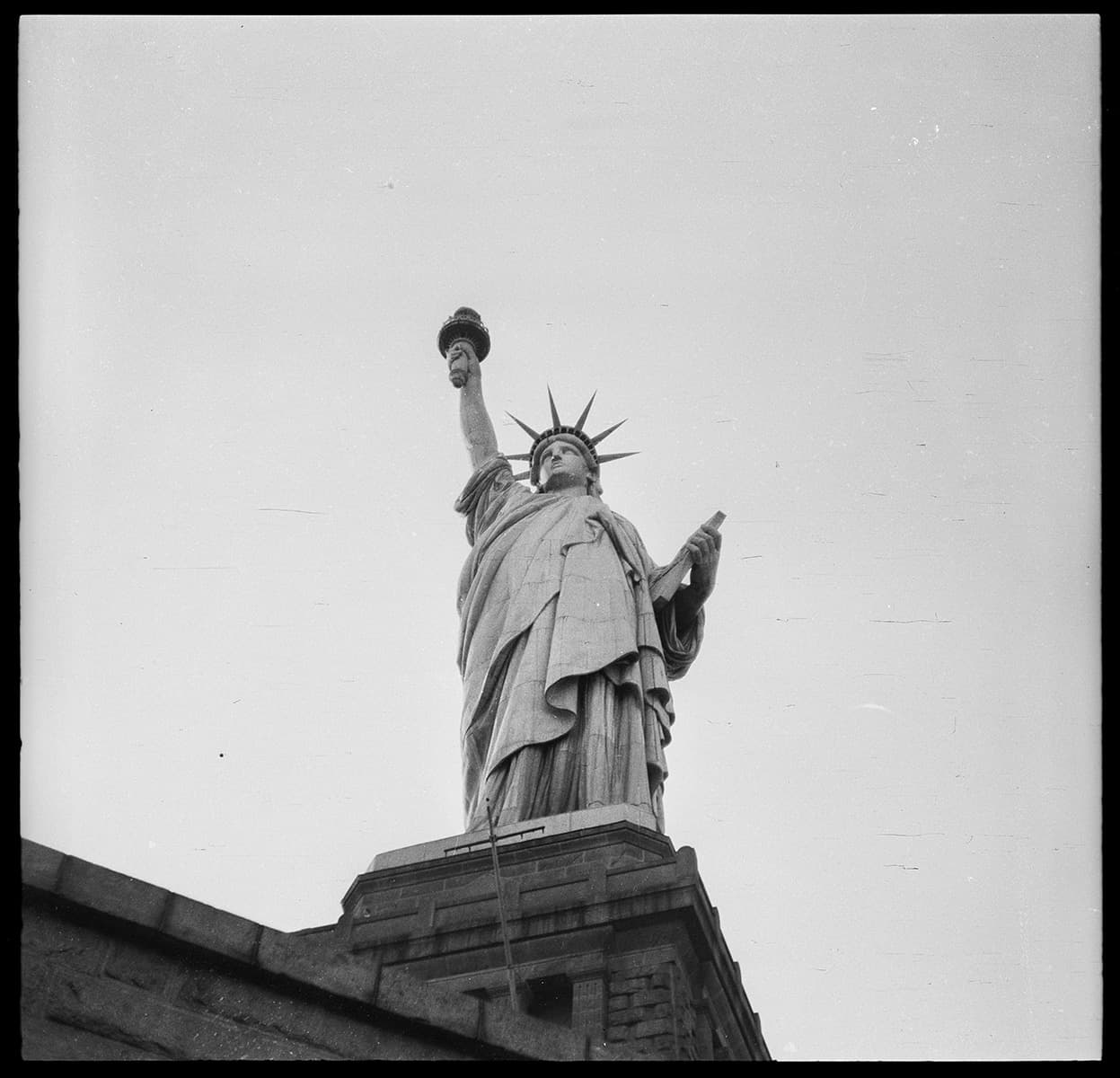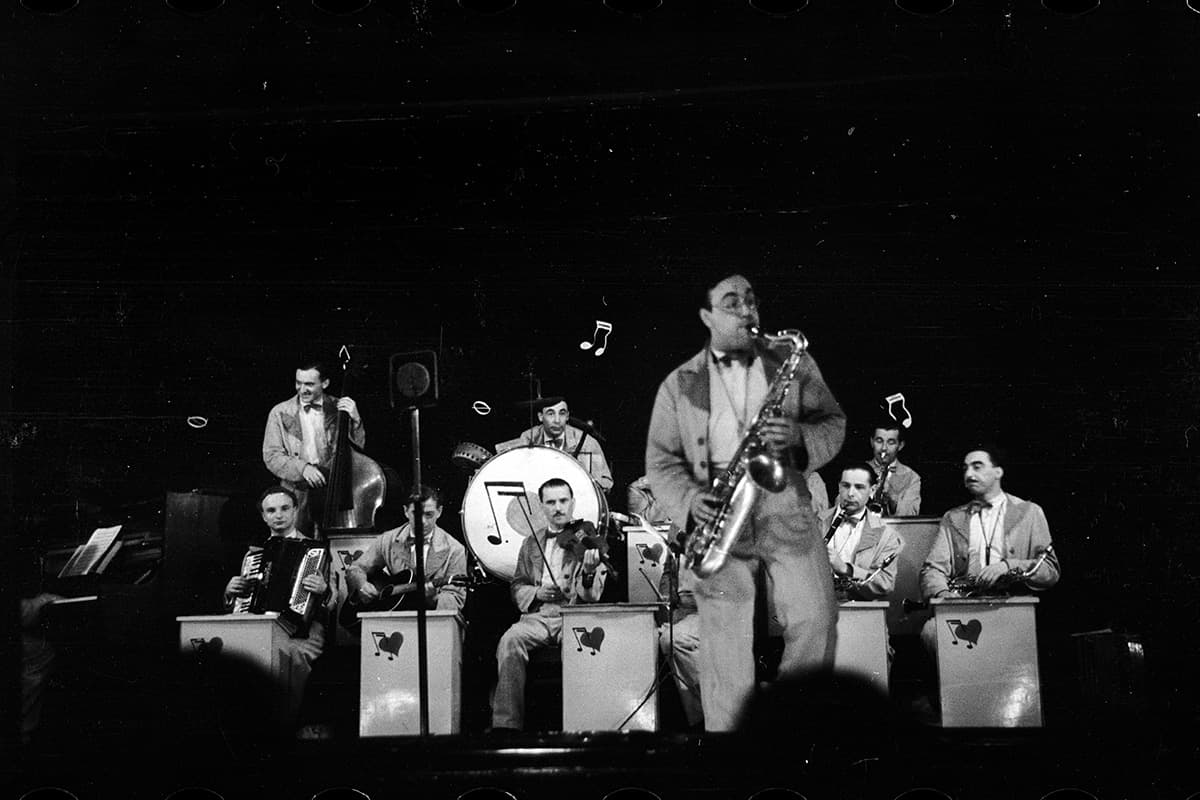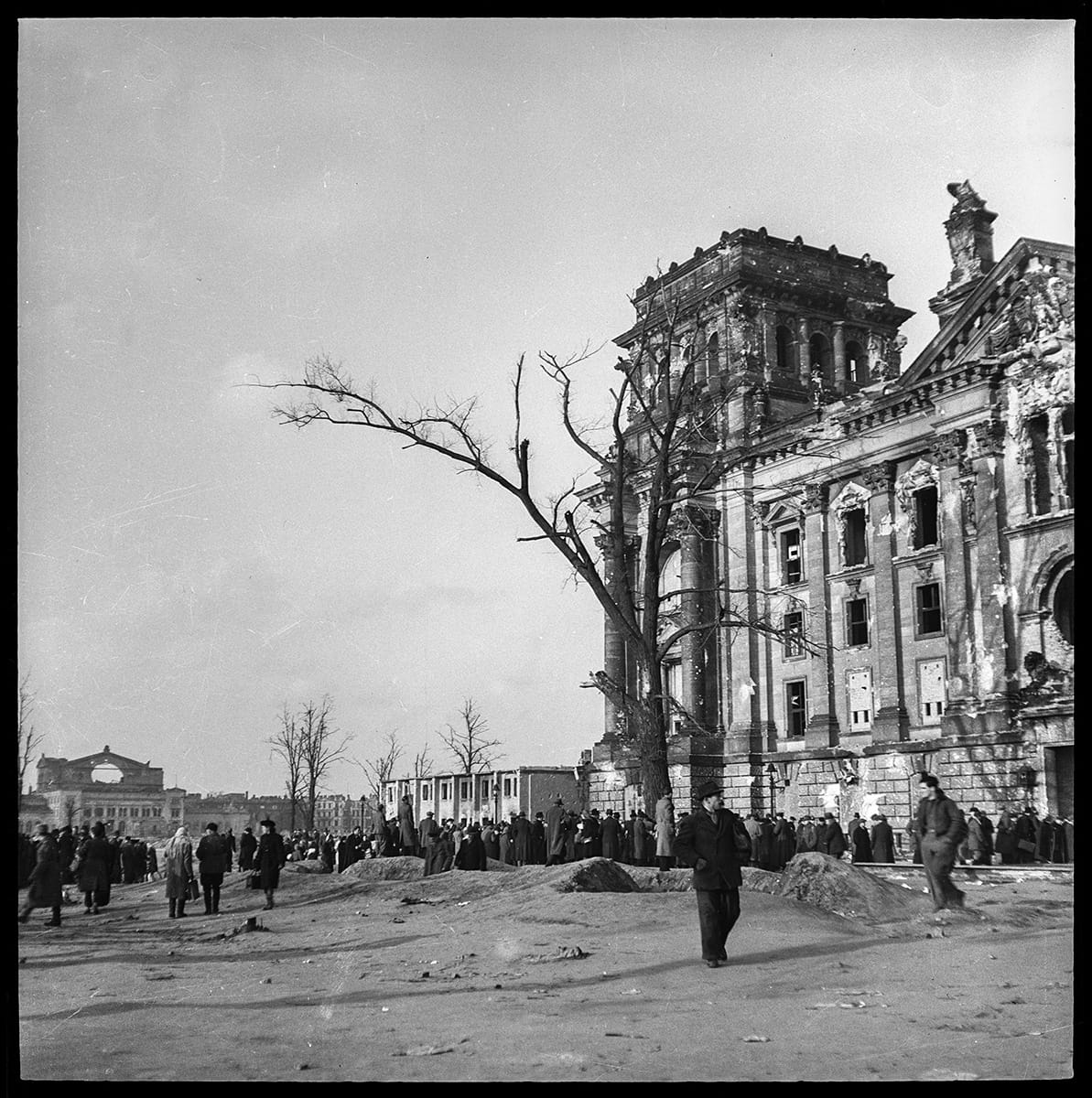
Black markets and the ruins of Berlin. Long way back to America
Black markets and the ruins of Berlin. Long way back to America
In 2019 I bought negatives of an American photographer who took photographs during the Second World War at an online auction in the US. The seller had bought them at a yard sale at one of the houses in New York. Along with the negatives were prints, a portrait of the photographer, a mailing envelope, and even the photographer's stamp. All of these items were mixed together in the dust and looked like a bag of rubbish, surprisingly quite well preserved for their time. After a bit of cleaning of all the stuff, it was possible to find out the name and destiny of the photographer. It turned out to be an American photographer Sam (Samuel) Jaffe.
After photographing in liberated France, American photographer Sam Jaffe traveled to the heart of Nazi Germany - to Berlin. Moving in convoy, the American troops entered occupied German territory. As they entered, they were greeted by a warning road sign «Entering Germany. Be on your guard. Do not fraternise with Germans». Literally just getting down from the back of an army truck, in the American sector of Berlin, Sam Jaffe started to make photographs. One of the striking images is a portrait of a US Army 3rd grade technician holding a dog house and a puppy, presumably a Riesenschnauzer breed. He also took portraits of colleagues near the 3110th Signal Service Battalion sign and the barbed wire fence at the entrance to the unit. He also asked colleagues to take a portrait of him at this location with a Leica camera around his neck.
A couple of days after his arrival, while the weather was still sunny in Berlin, Sam Jaffe went to photograph the defeated city. And of course, the first place he went to was the Soviet sector of Berlin. He visited the Reichstag building, already a symbol of victory, and photographed the Soviet plaque of honour with portraits of generals not far from from the building of Reichstag. With his American colleague, they took portraits of each other near the destroyed 88-mm air defence gun near the Reichstag, before heading to the newly opened Memorial to Fallen Soviet Soldiers in the Tiergarten.
Apart from the blown-up underground tunnel and bombed-out houses, Sam Jaffe's greatest interest was in the so-called ‘black markets’. In these spontaneous markets, anything could be bought at the time, as locals carried all their belongings for sale to survive and American soldiers sold various items from the United States. Immediately after Allied troops entered Berlin in July 1945, black markets spontaneously appeared in Tiergarten and gradually took on monstrous proportions.
After a month or two in Berlin, Sam Jaffe travelled to the north-west of Germany, to the port city of Bremerhaven with the American military by railroad, in wooden cars with ‘burzhuyka’ and stopped at stations for meals. During the war there was one of the biggest bases of the German Kriegsmarine submarine fleet in the North Sea. As a consequence, the city was subjected to extensive Allied bombing and 79% of the city was destroyed. But key parts of the harbour were deliberately preserved for further Allied supply. The area was a post-war enclave administered by the United States in the British zone of northern Germany.
In Bremerhaven, Sam Jaffe photographed the post-war life of the harbour town over a period of several months. His camera captured civilians as well as former members of the German navy. It is interesting that on their uniforms one can notice the Nazi symbols removed, but the awards and epaulettes with rank remaining.
From Bremerhaven, in early 1946, photographer Sam Jaffe sailed with other American soldiers home to America, to New York. Minutes before leaving port, he photographed the loading of machinery and American troops onto the cargo vessels Frostburg Victory and Rollins Victory, aboard which he himself would be travelling.
The journey back home would be quite long and challenging. Firstly, it would be through the harsh waters of the Atlantic Ocean, and secondly, at the time, a direct crossing of the Atlantic would take at least several weeks. On the board of Rollins Victory cargo ship Sam Jaffe photographed tired military personnel as they stepped out on deck for some fresh air and sunshine during the nice weather. Tired from a long day's sailing, they stood leaning against metal structures or sat around eating army rations.
Finally reaching New York, Sam Jaffe took a few portraits of the soldiers amongst the corps of an army unit and then went on a well-deserved break. Meanwhile, he and his friends traveled to the bustling heart of the New York city, to Manhattan: Rockefeller Center with its famous ice skating rink, Times Square with its movie theatres and shops, Broadway and 42nd Street, and of course a trip to the Statue of Liberty on Bedloe Island, which would be renamed in 1956, to what we know today, Liberty Island.


German citizens near the Reichstag. Berlin, Germany. October 1945
German citizens near the Reichstag. Berlin, Germany. October 1945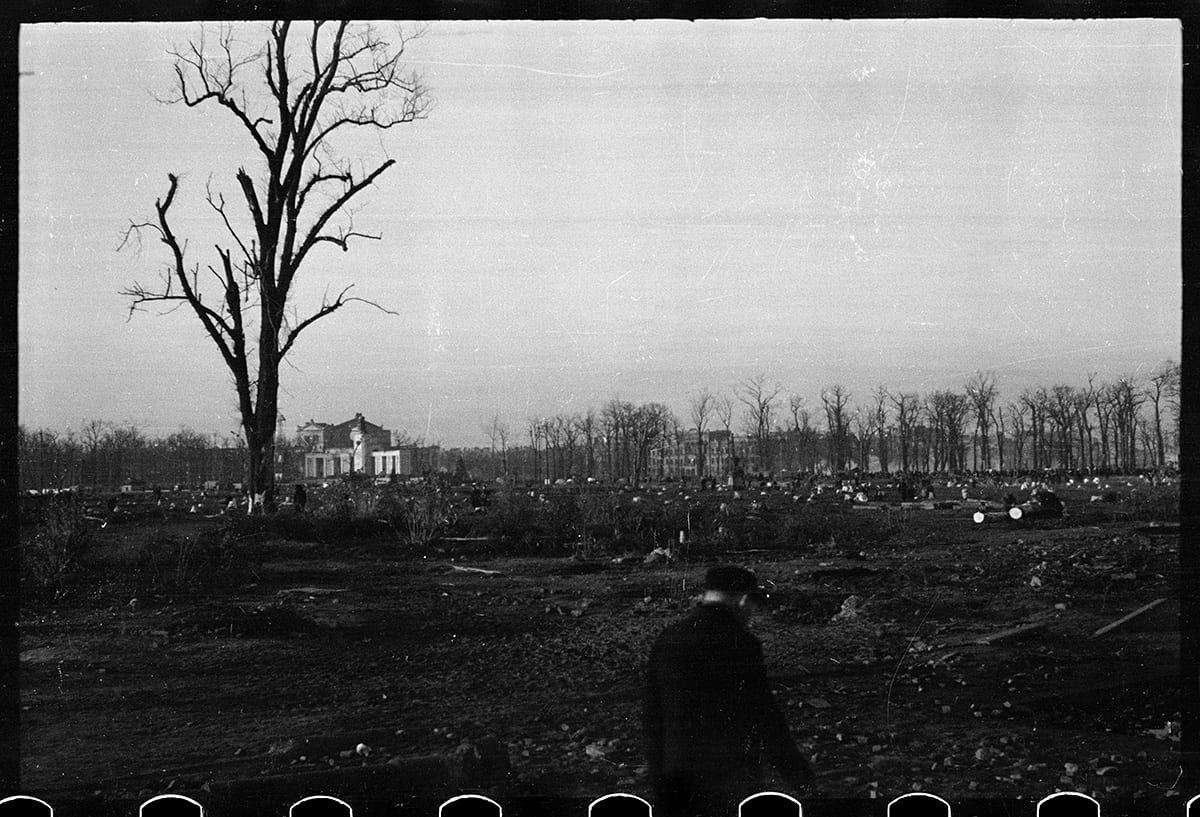
Cutting down trees near the memorial for fallen Soviet soldiers in Tiergarten. Berlin, Germany. October 1945
Cutting down trees near the memorial for fallen Soviet soldiers in Tiergarten. Berlin, Germany. October 1945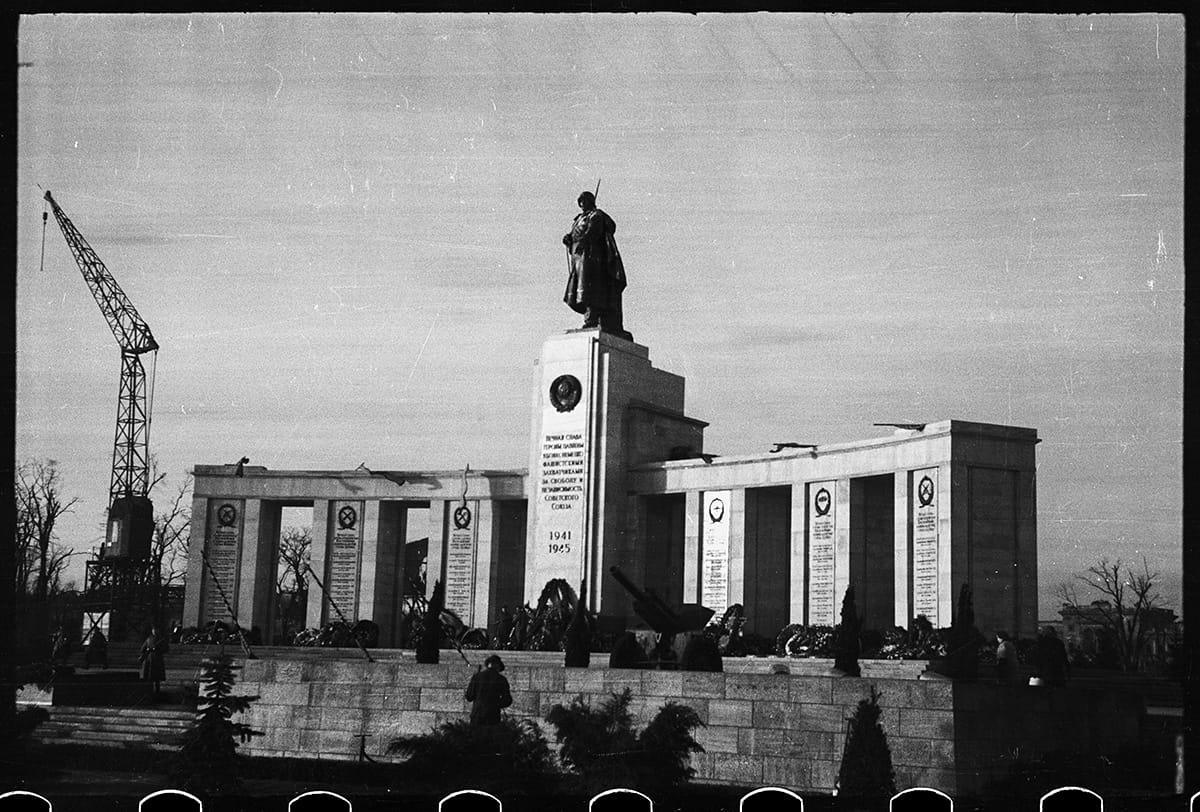
Monument to fallen Soviet soldiers in Tiergarten. Berlin, Germany. October 1945
Monument to fallen Soviet soldiers in Tiergarten. Berlin, Germany. October 1945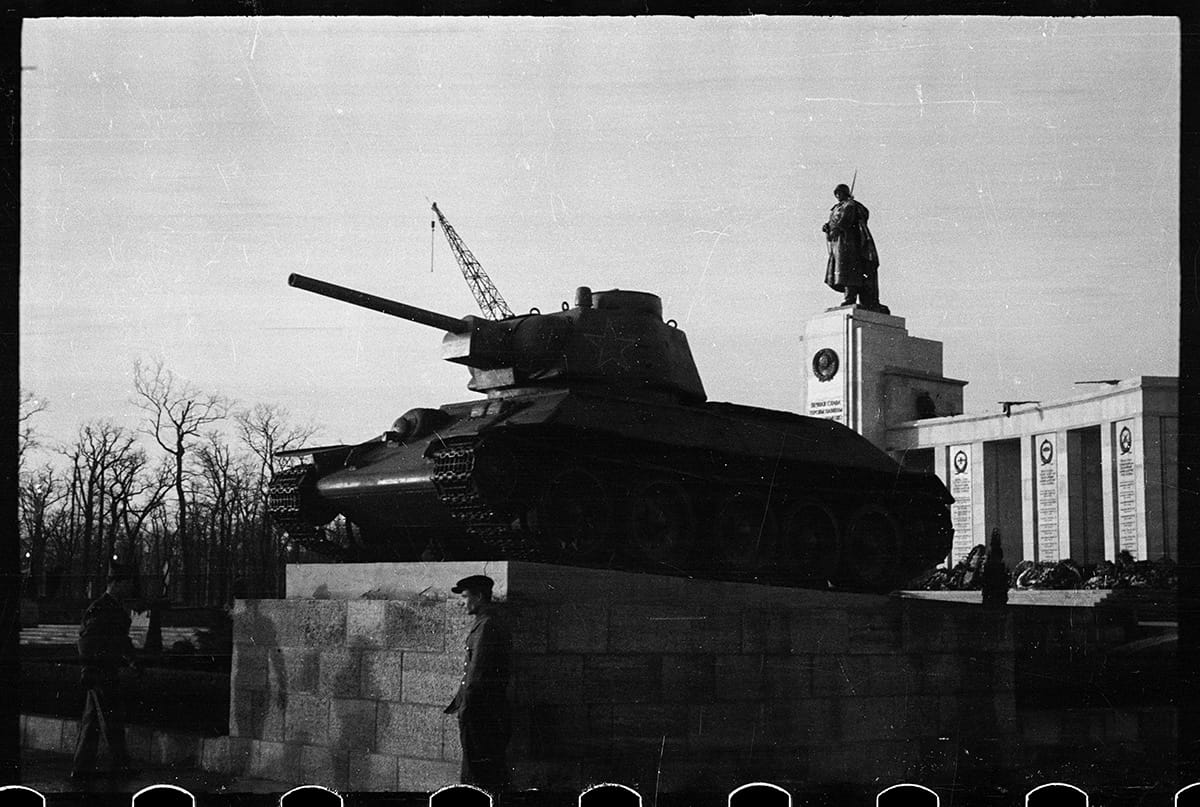
Monument to fallen Soviet soldiers in Tiergarten. Berlin, Germany. October 1945
Monument to fallen Soviet soldiers in Tiergarten. Berlin, Germany. October 1945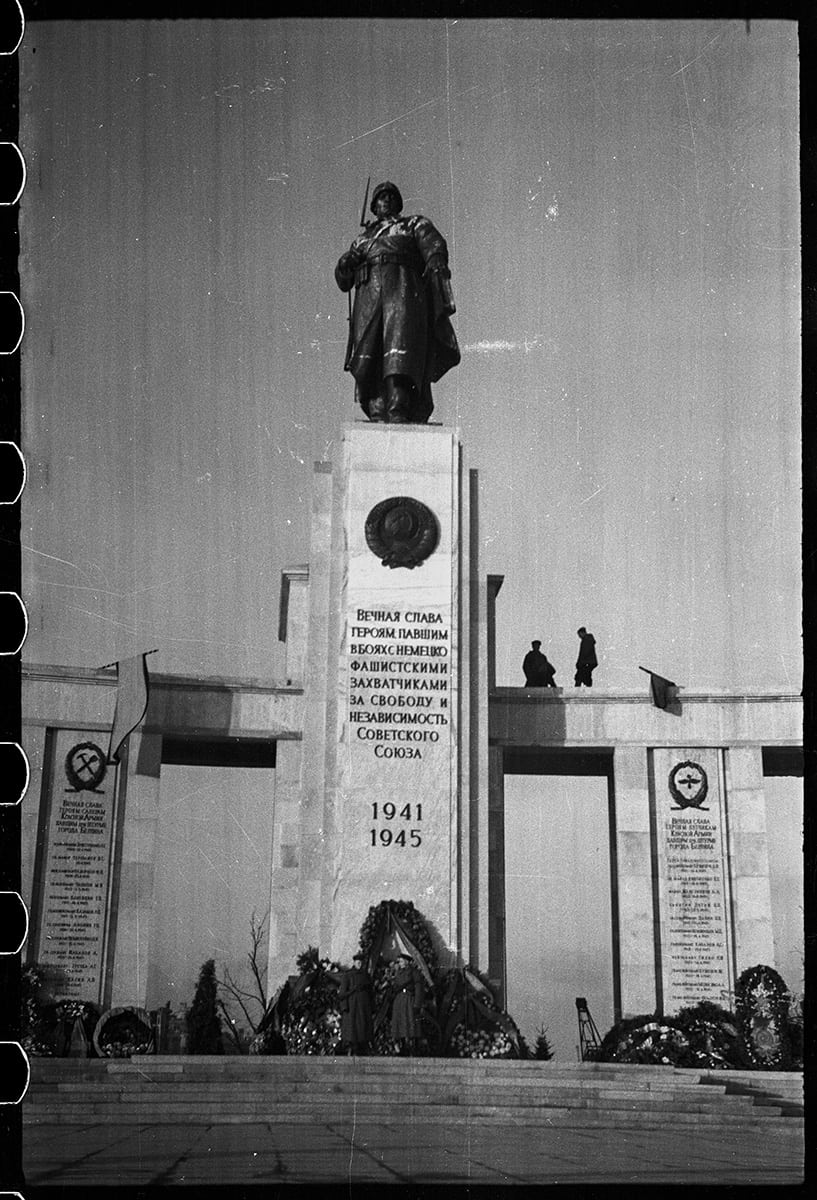
Monument to fallen Soviet soldiers in Tiergarten. Berlin, Germany. October 1945
Monument to fallen Soviet soldiers in Tiergarten. Berlin, Germany. October 1945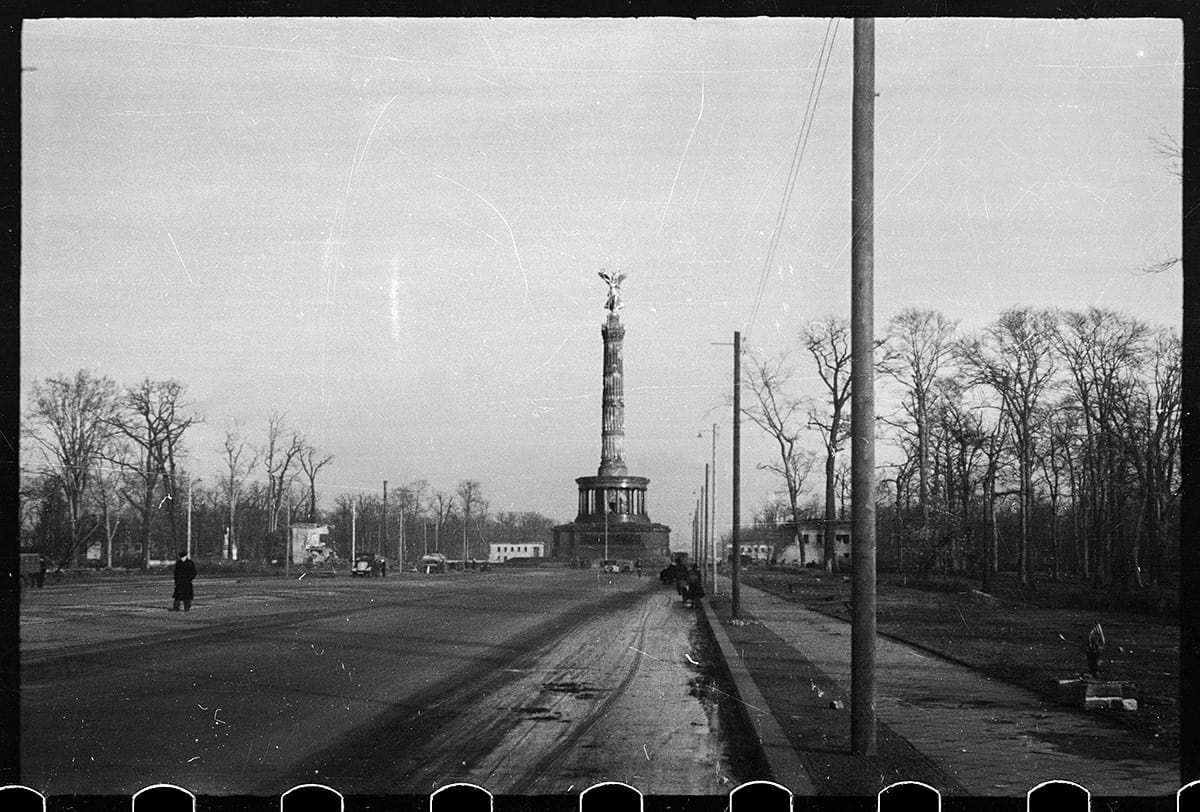
The road to the Victory Column. Tiergarten, Berlin, Germany. October 1945
The road to the Victory Column. Tiergarten, Berlin, Germany. October 1945
The Reichstag building. Berlin, Germany. October 1945
The Reichstag building. Berlin, Germany. October 1945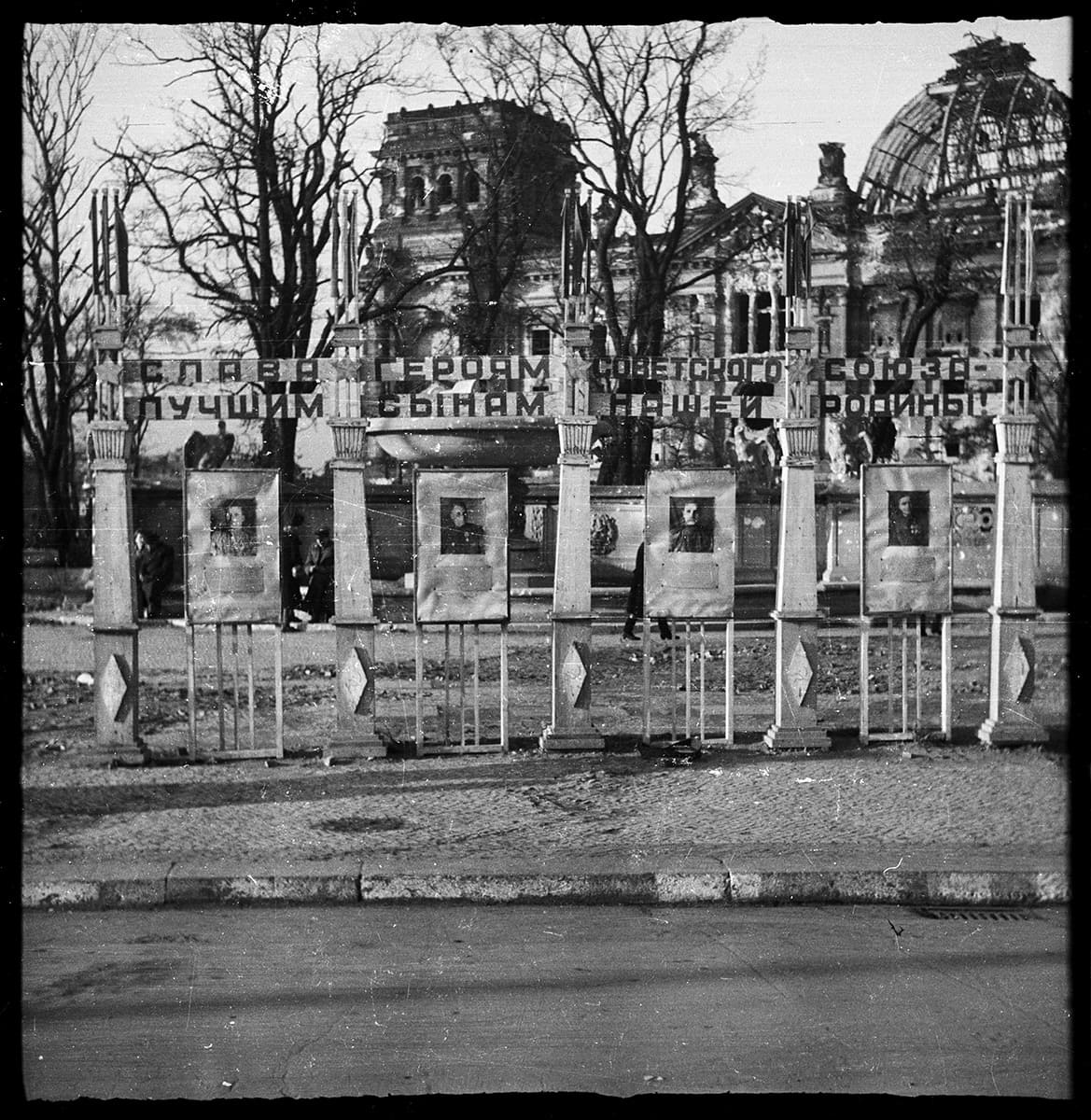
Soviet commemorative plaque near the Reichstag building. Berlin, Germany. October 1945
Soviet commemorative plaque near the Reichstag building. Berlin, Germany. October 1945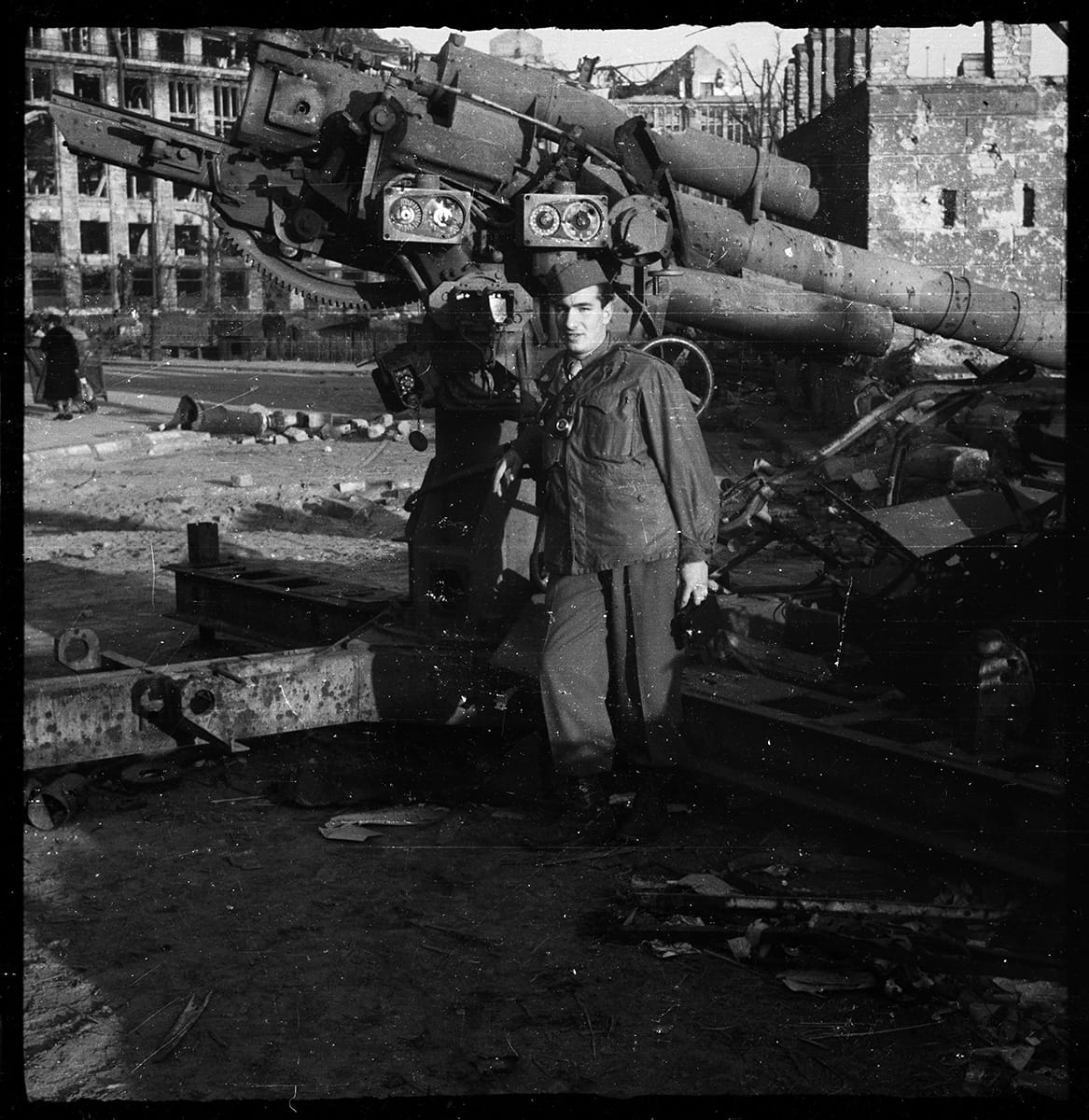
Portrait of Sam Jaffe near a destroyed 88mm anti-aircraft gun on the Reichstag building. Berlin, Germany. October 1945
Portrait of Sam Jaffe near a destroyed 88mm anti-aircraft gun on the Reichstag building. Berlin, Germany. October 1945
Portrait of an American soldier near a destroyed 88mm anti-aircraft gun on the Reichstag building. Berlin, Germany. October 1945
Portrait of an American soldier near a destroyed 88mm anti-aircraft gun on the Reichstag building. Berlin, Germany. October 1945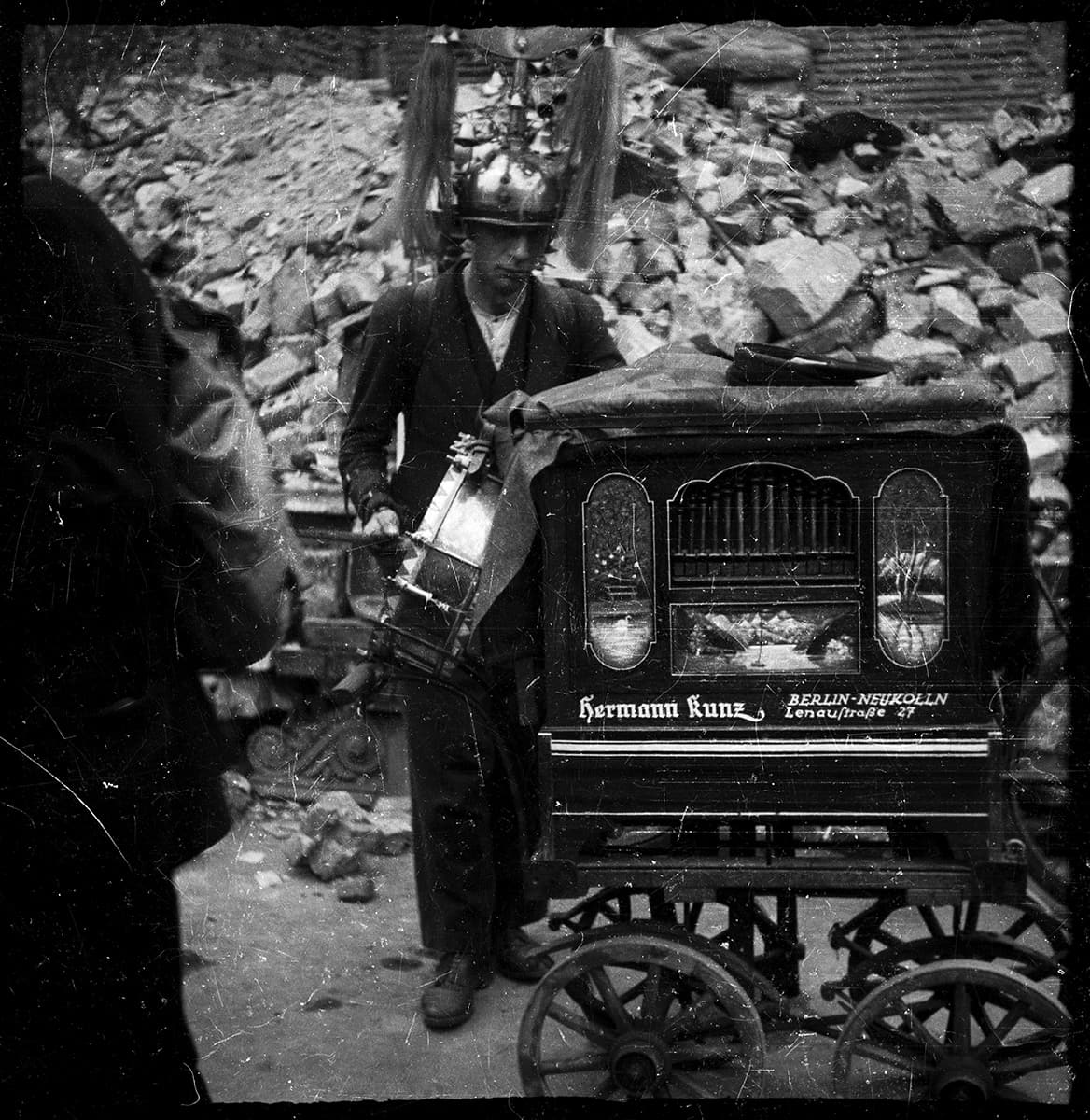
Orchestra man among the ruins of the city. Berlin, Germany. October 1945
Orchestra man among the ruins of the city. Berlin, Germany. October 1945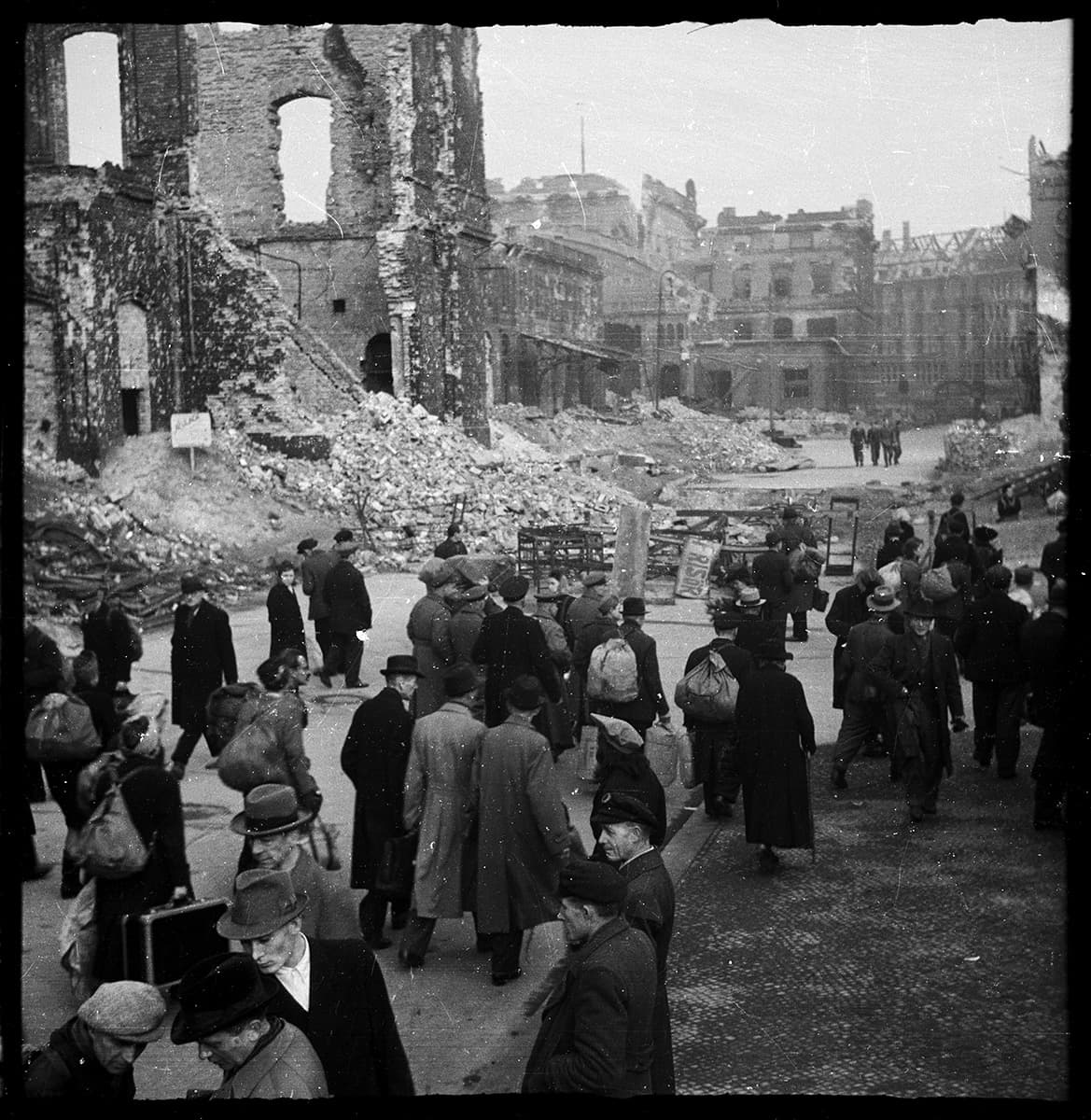
Black market among the ruins of the city. Berlin, Germany. October 1945
Black market among the ruins of the city. Berlin, Germany. October 1945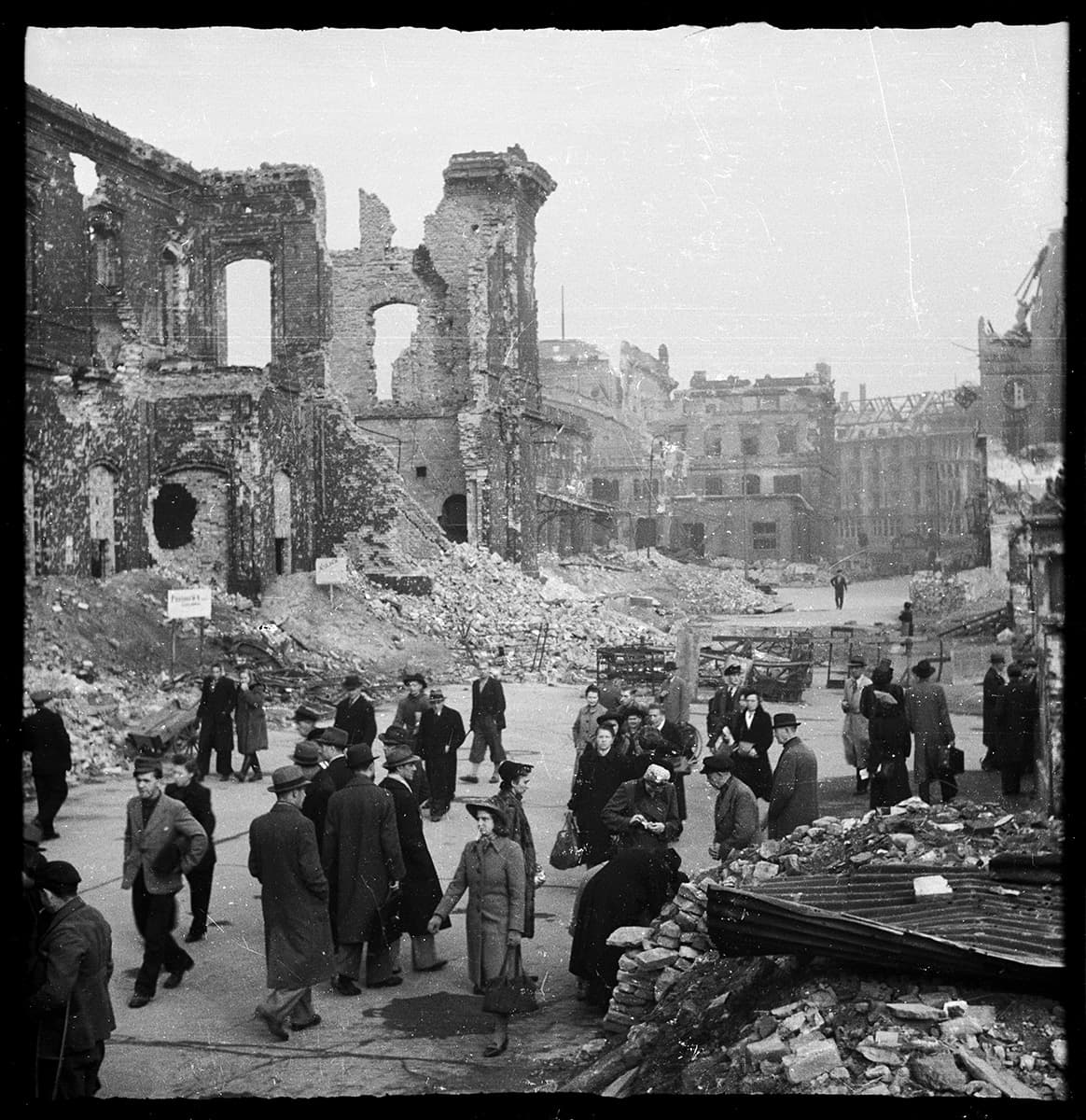
Locals sell various goods on the black market in order to survive. Berlin, Germany. October 1945
Locals sell various goods on the black market in order to survive. Berlin, Germany. October 1945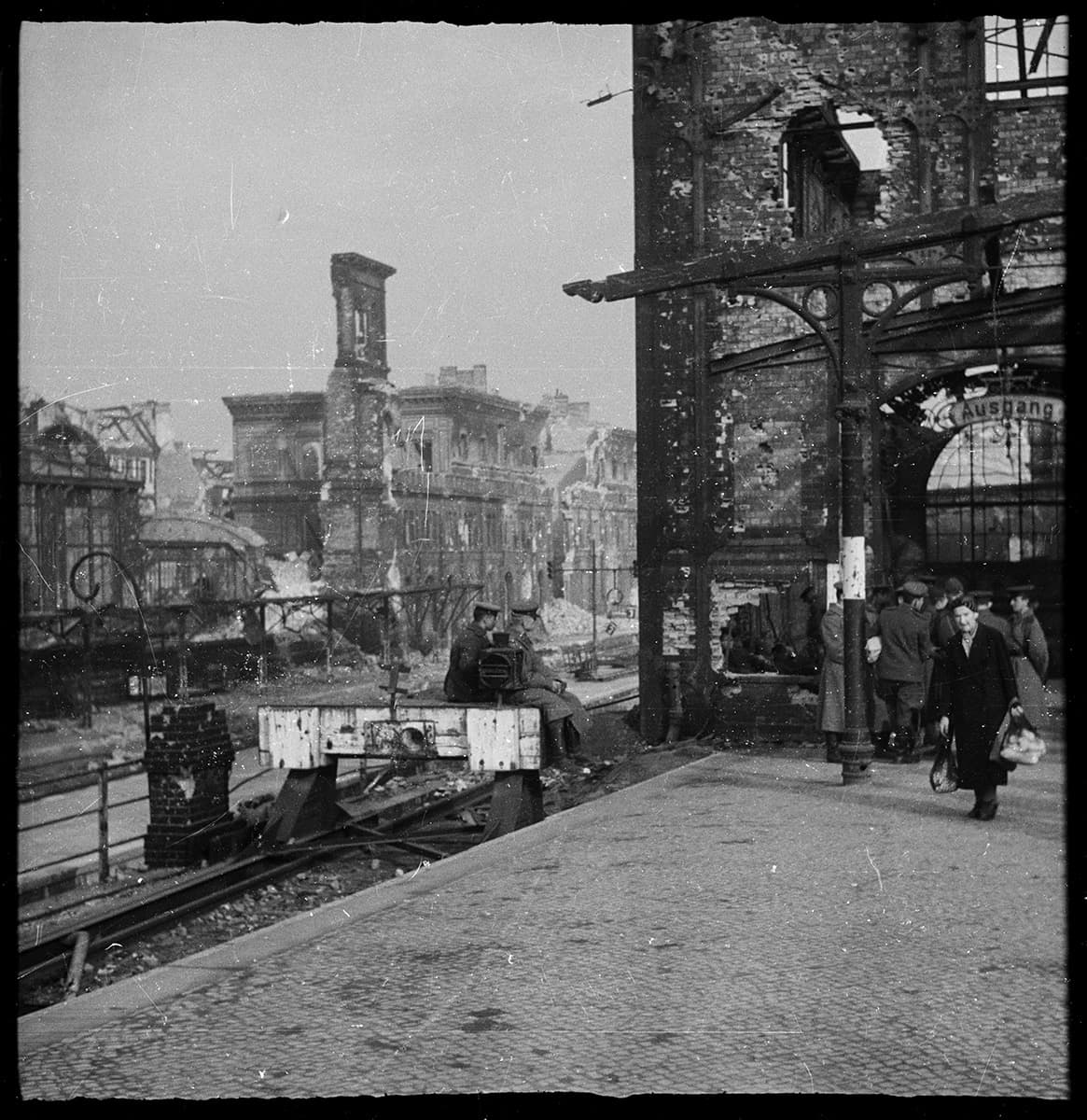
Residents among the ruins of the war-torn city near the railway station. Berlin, Germany. October 1945
Residents among the ruins of the war-torn city near the railway station. Berlin, Germany. October 1945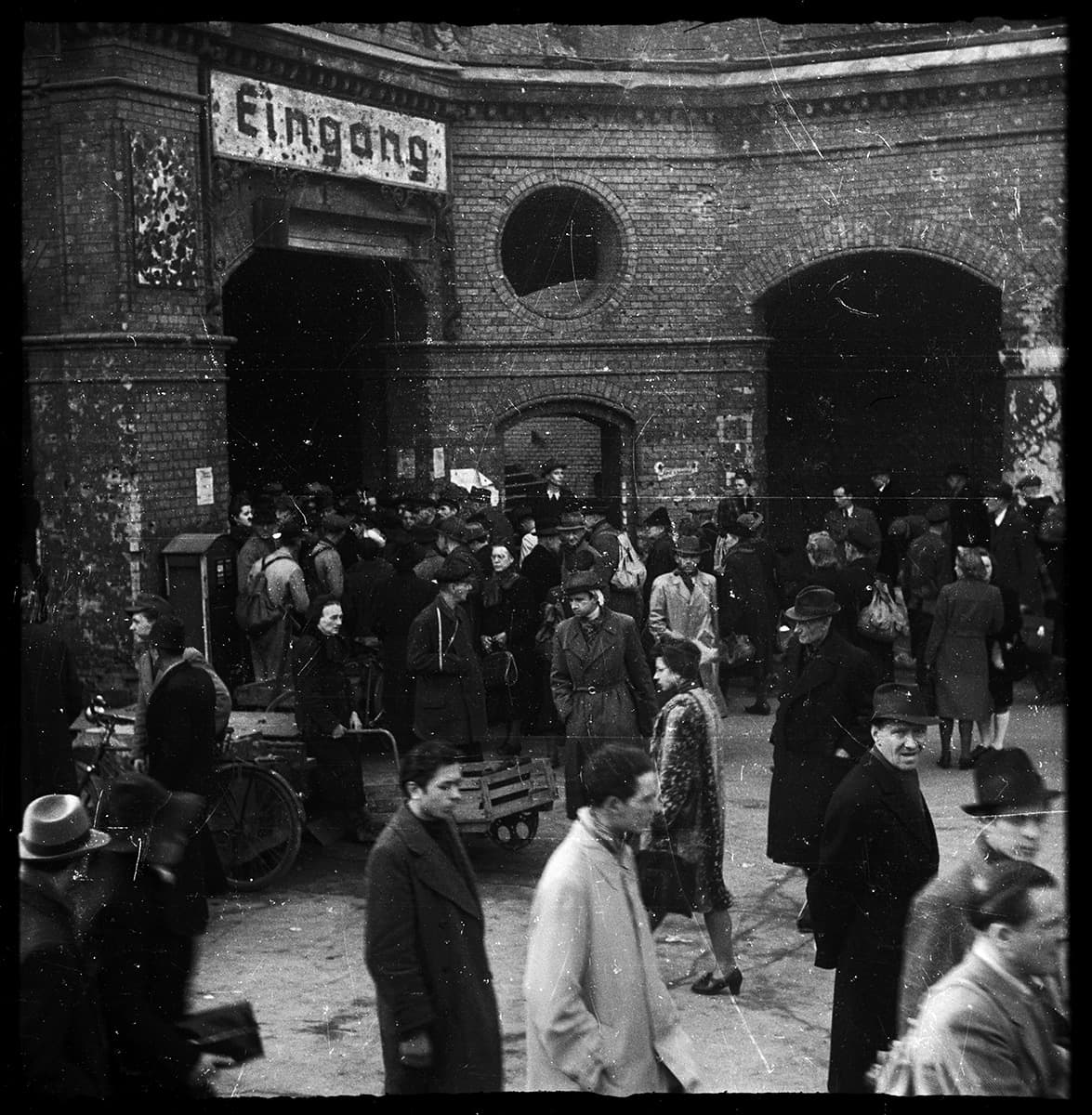
Locals at one of the city's black markets, near the war-damaged train station. Potsdamer Platz, Berlin, Germany. October 1945
Locals at one of the city's black markets, near the war-damaged train station. Potsdamer Platz, Berlin, Germany. October 1945
Locals at one of the city's black markets, near the war-damaged train station. Potsdamer Platz, Berlin, Germany. October 1945
Locals at one of the city's black markets, near the war-damaged train station. Potsdamer Platz, Berlin, Germany. October 1945
Locals at one of the city's black markets, near the war-damaged train station. Potsdamer Platz, Berlin, Germany. October 1945
Locals at one of the city's black markets, near the war-damaged train station. Potsdamer Platz, Berlin, Germany. October 1945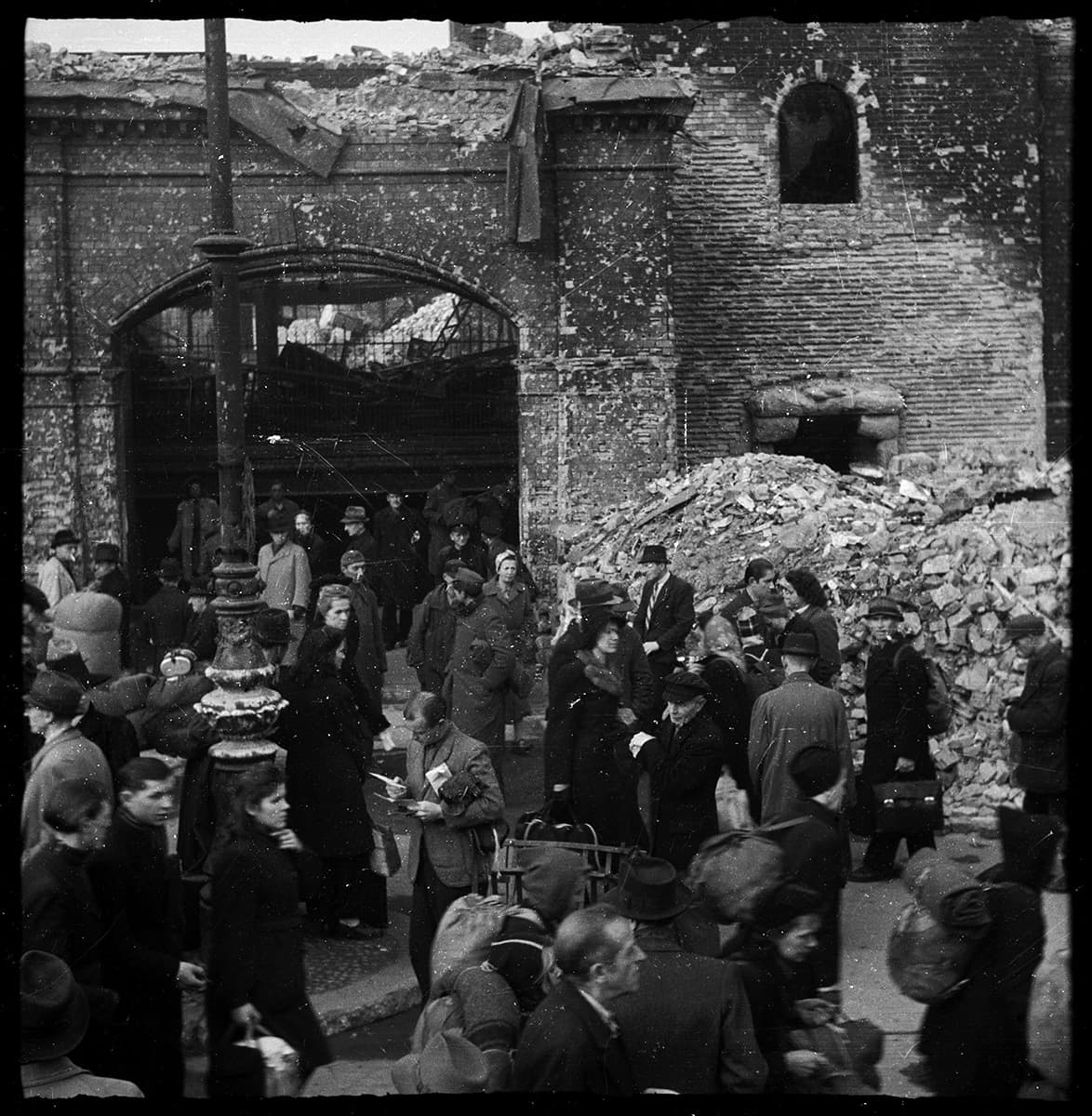
Locals at one of the city's black markets, near the war-damaged train station. Potsdamer Platz, Berlin, Germany. October 1945
Locals at one of the city's black markets, near the war-damaged train station. Potsdamer Platz, Berlin, Germany. October 1945
One of the black markets. After the war, locals sold or bartered any goods in these markets in order to survive. Berlin, Germany. October 1945
One of the black markets. After the war, locals sold or bartered any goods in these markets in order to survive. Berlin, Germany. October 1945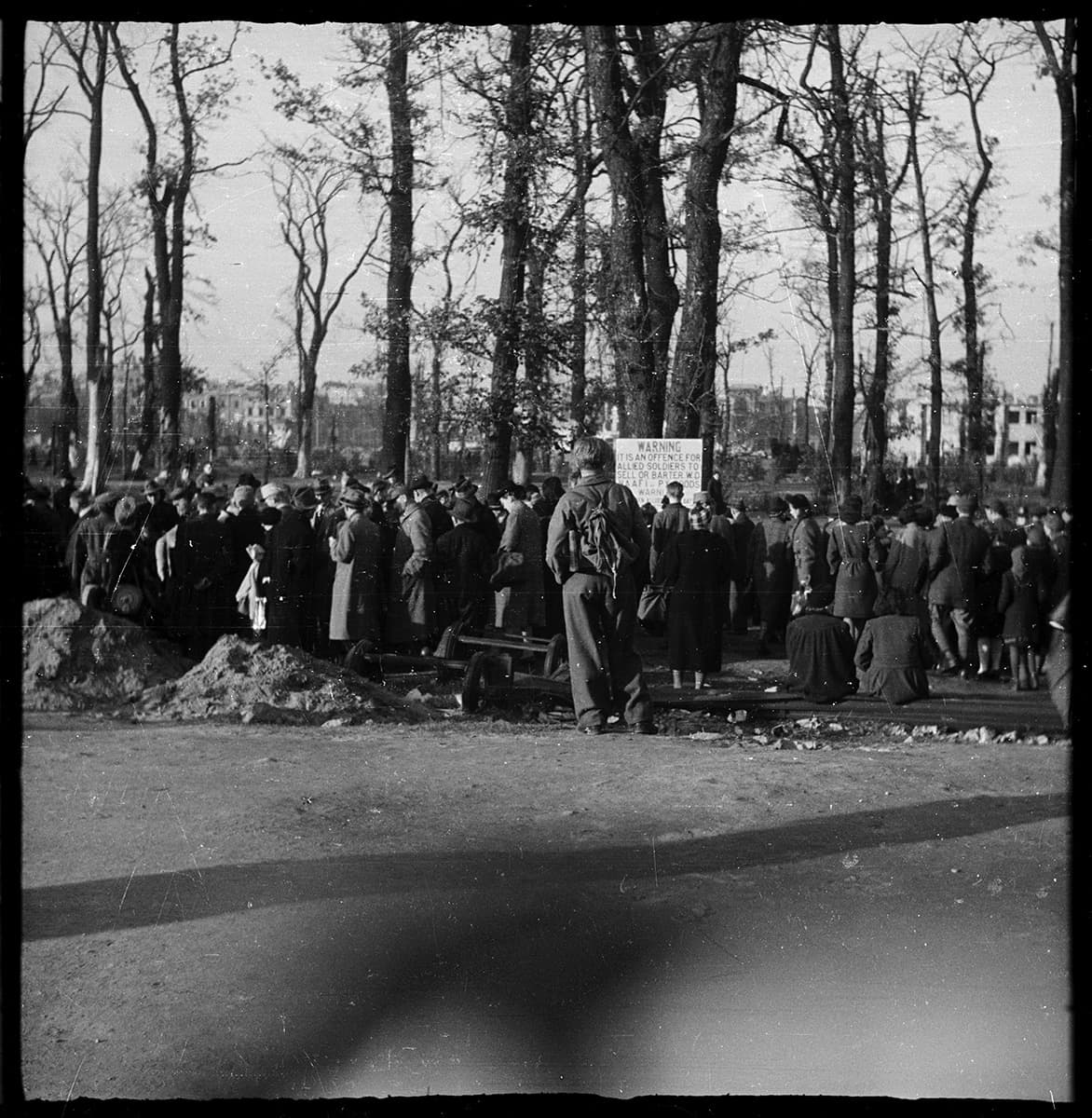
The largest black market in the city, near the Reichstag. After the war, locals used these markets to sell or exchange any goods they needed to survive. Officially, the military were forbidden to buy or sell there, but unofficially everyone did. In the background is a poster warning "Attention! It is an offence for Allied soldiers to sell or barter anything". Tiergarten, Berlin, Germany. October 1945
The largest black market in the city, near the Reichstag. After the war, locals used these markets to sell or exchange any goods they needed to survive. Officially, the military were forbidden to buy or sell there, but unofficially everyone did. In the background is a poster warning "Attention! It is an offence for Allied soldiers to sell or barter anything". Tiergarten, Berlin, Germany. October 1945
Military and locals in the area of the largest black market on the road to the Victory Column. Tiergarten, Berlin. October 1945.
Military and locals in the area of the largest black market on the road to the Victory Column. Tiergarten, Berlin. October 1945.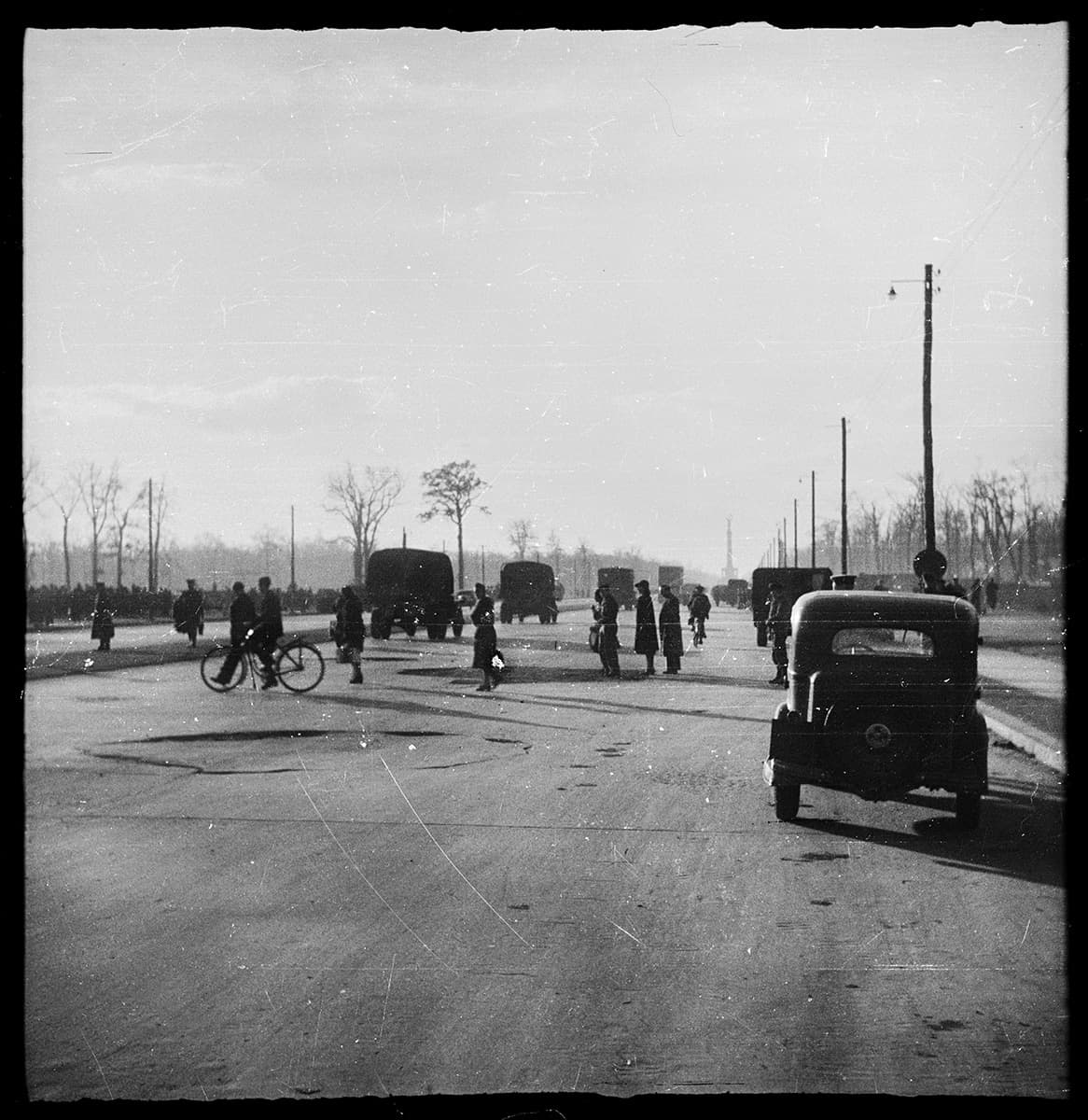
Military and locals in the area of the largest black market on the road to the Victory Column. Tiergarten, Berlin. October 1945.
Military and locals in the area of the largest black market on the road to the Victory Column. Tiergarten, Berlin. October 1945.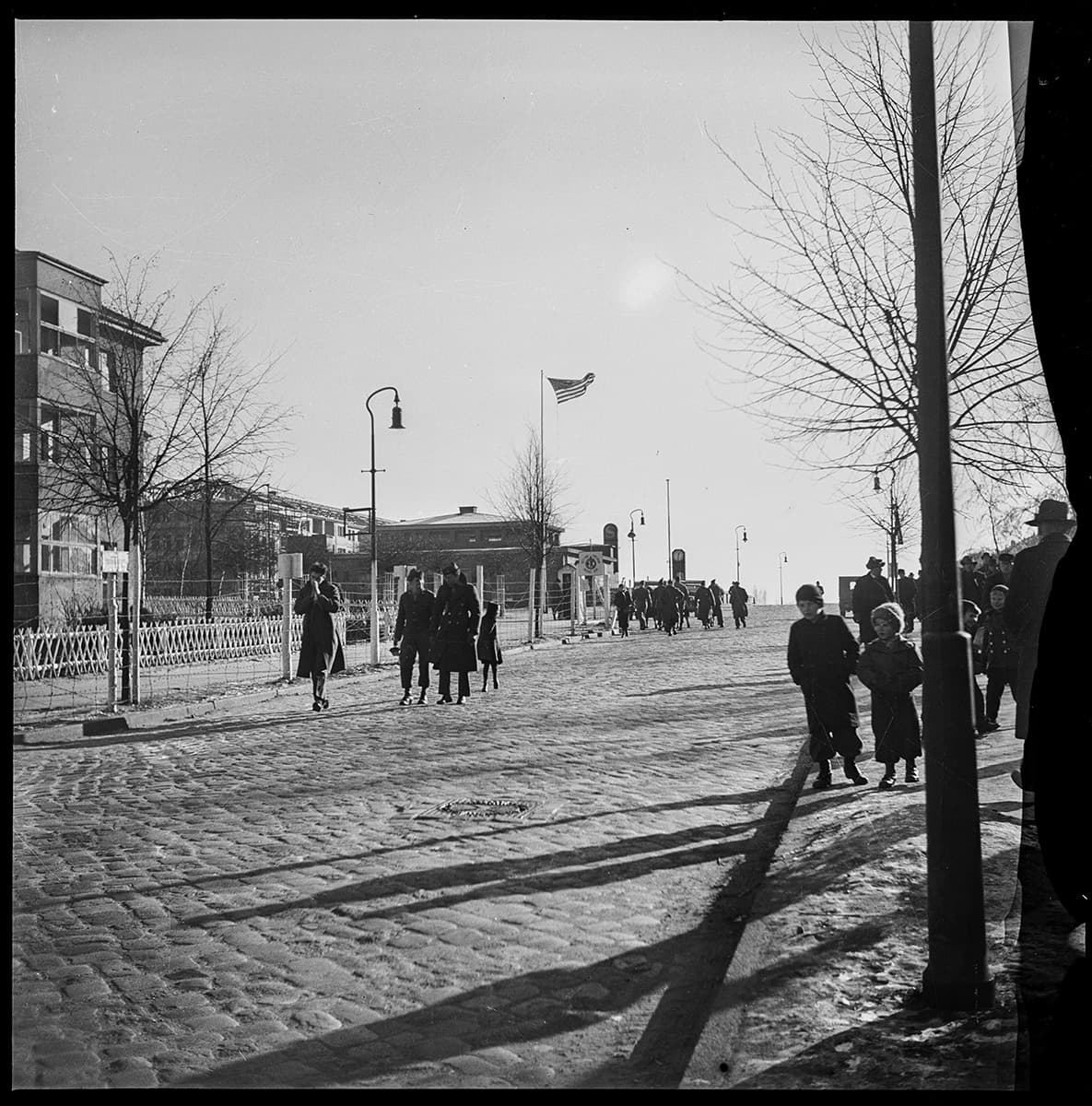
Local residents and American soldiers walk along a street near the 3110th Signal Battalion, U.S. Army. Berlin, 1945
Local residents and American soldiers walk along a street near the 3110th Signal Battalion, U.S. Army. Berlin, 1945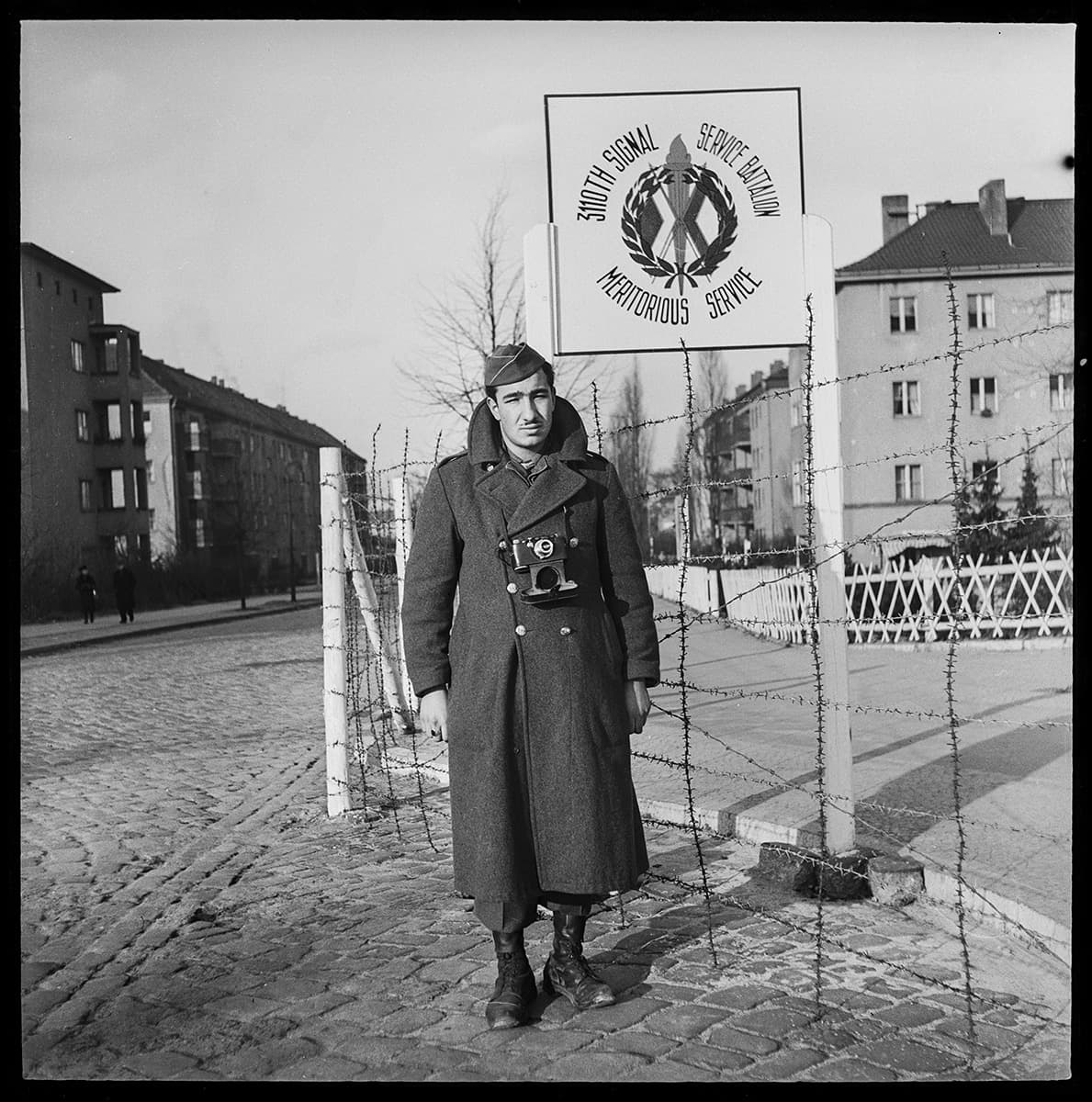
Portrait of photographer Sam Jaffe with a Leica camera around his neck in front of the sign of Liaison Battalion 3110. Berlin, Germany. October 1945
Portrait of photographer Sam Jaffe with a Leica camera around his neck in front of the sign of Liaison Battalion 3110. Berlin, Germany. October 1945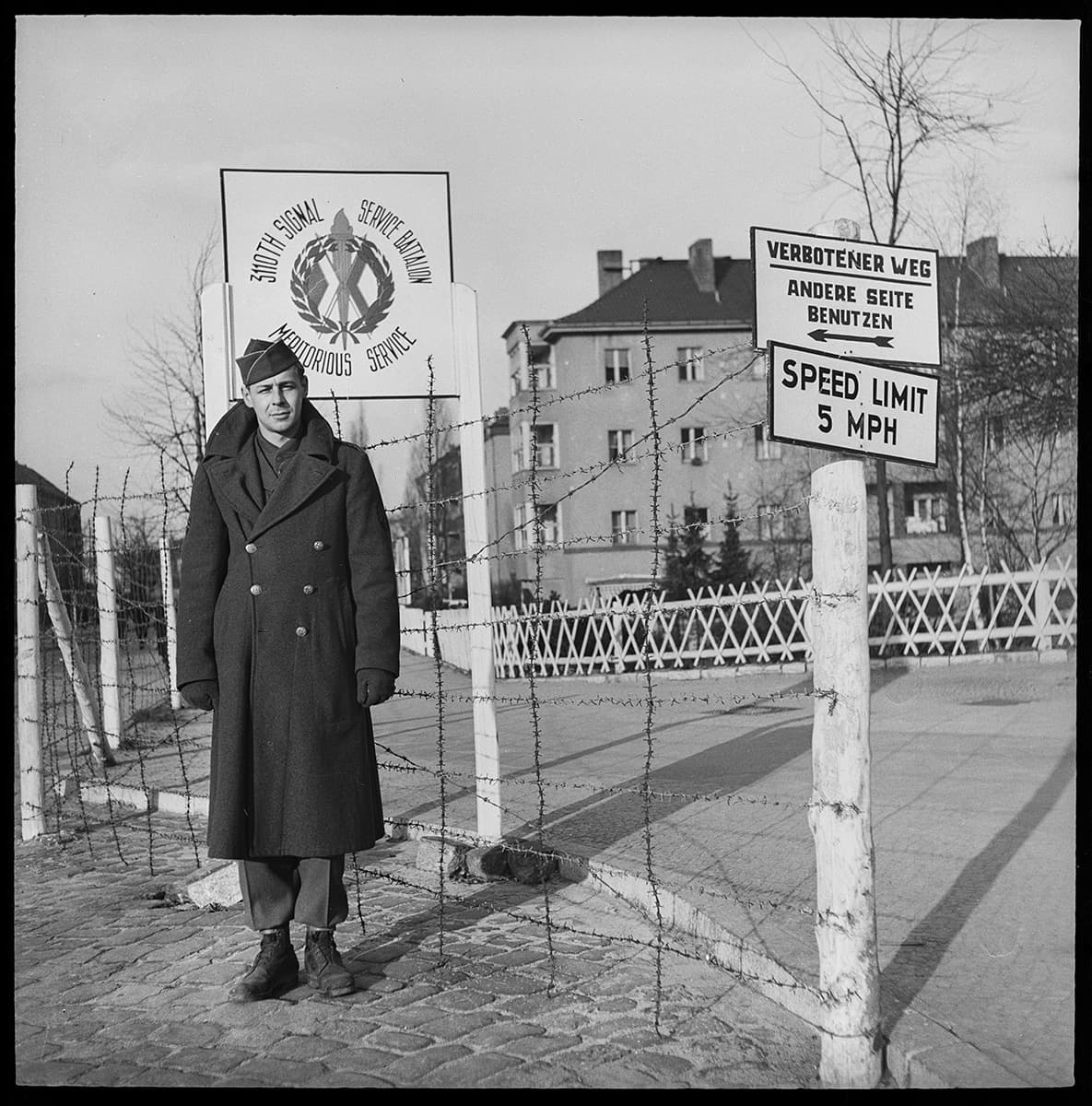
A third grade technician near the entrance to the 3110th Signal Battalion, U.S. Army. Berlin, 1945
A third grade technician near the entrance to the 3110th Signal Battalion, U.S. Army. Berlin, 1945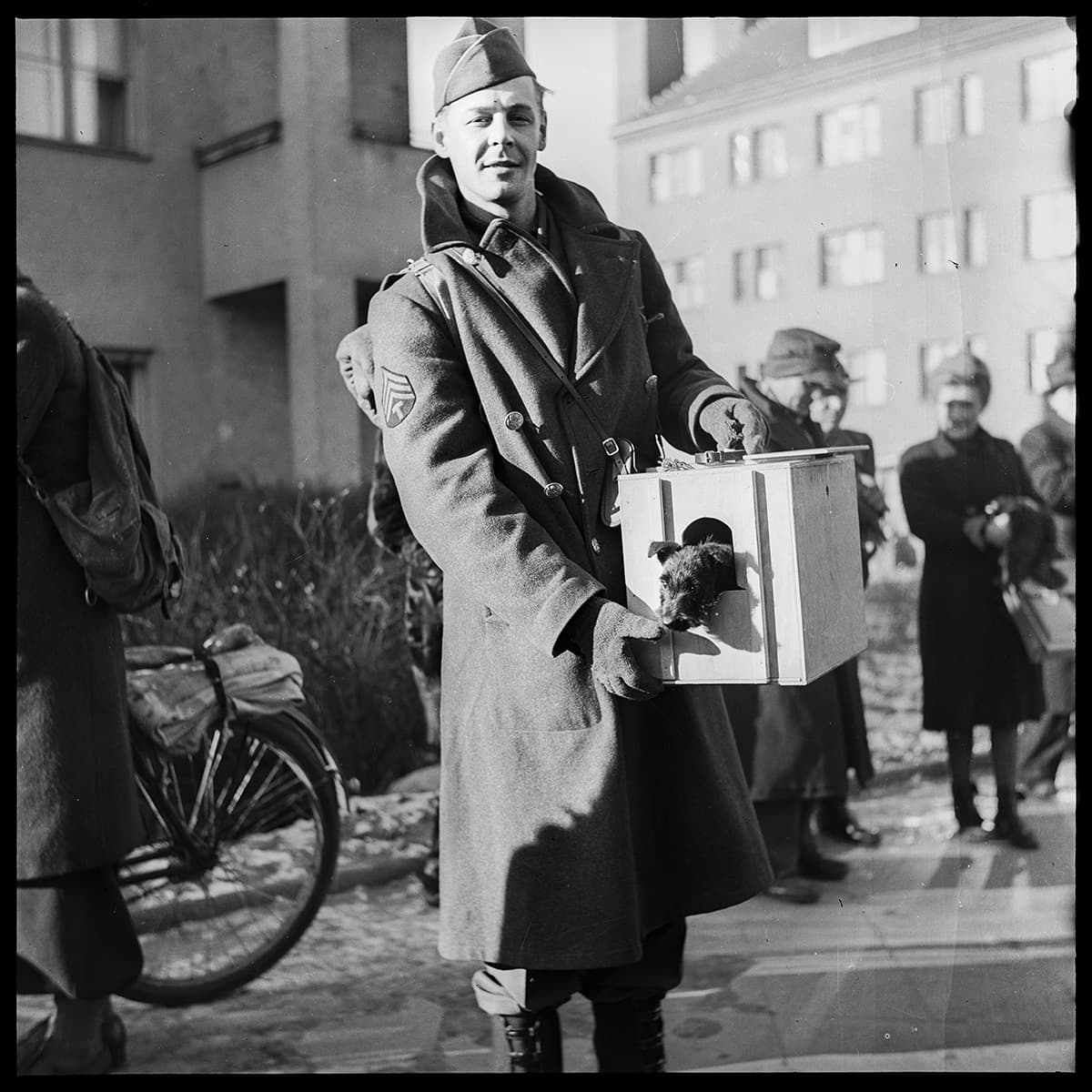
U.S. Army 3rd grade technician on hand with a puppy, presumably of the Riesenschnauzer breed, in a booth upon arrival at the unit. Berlin, Germany. October 1945
U.S. Army 3rd grade technician on hand with a puppy, presumably of the Riesenschnauzer breed, in a booth upon arrival at the unit. Berlin, Germany. October 1945
Unloading of American soldiers in the American sector of the city. Berlin, 1945
Unloading of American soldiers in the American sector of the city. Berlin, 1945
An American military man sits at his desk with a Life magazine, for 15 October 1945 Berlin, Germany. October 1945
An American military man sits at his desk with a Life magazine, for 15 October 1945 Berlin, Germany. October 1945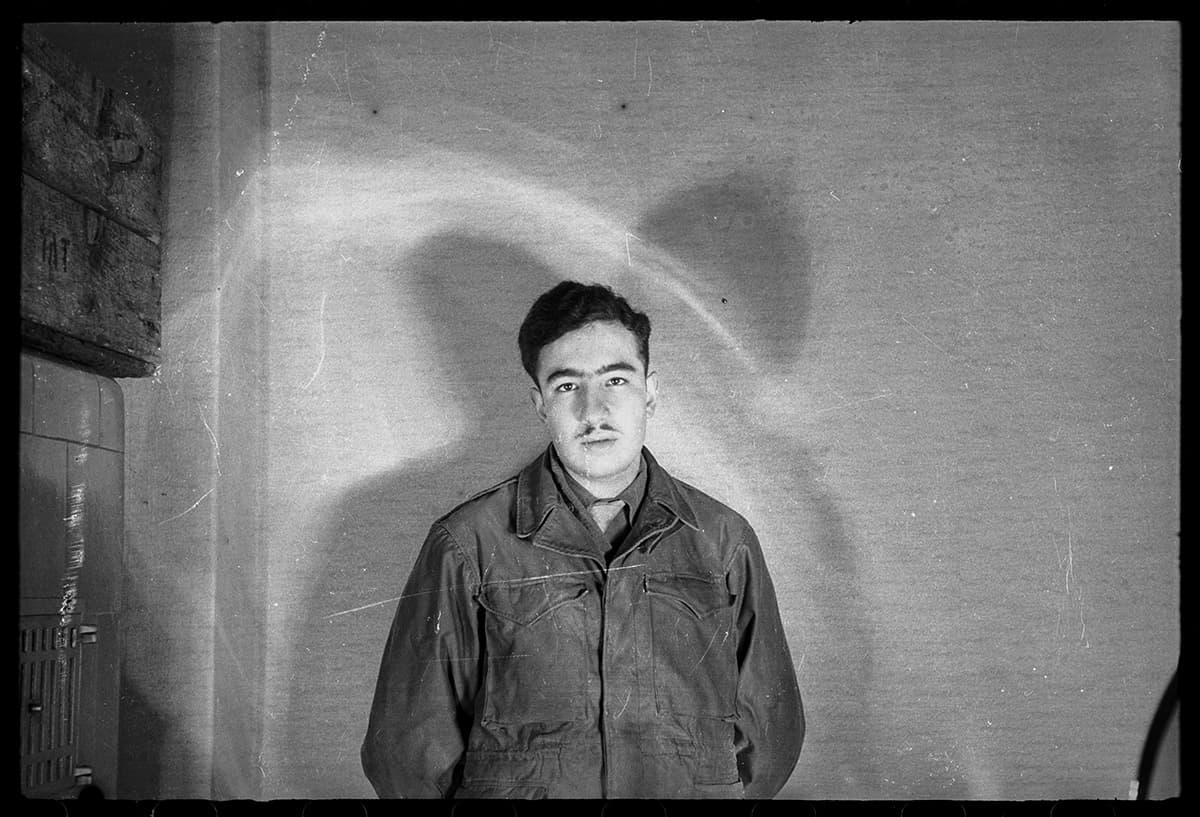
Portrait of Sam Jaffe in the location of the unit. Berlin, Germany. October 1945
Portrait of Sam Jaffe in the location of the unit. Berlin, Germany. October 1945
A puppy, presumably of the Riesenschnauzer breed, in an army wooden crate. Berlin, Germany. October 1945
A puppy, presumably of the Riesenschnauzer breed, in an army wooden crate. Berlin, Germany. October 1945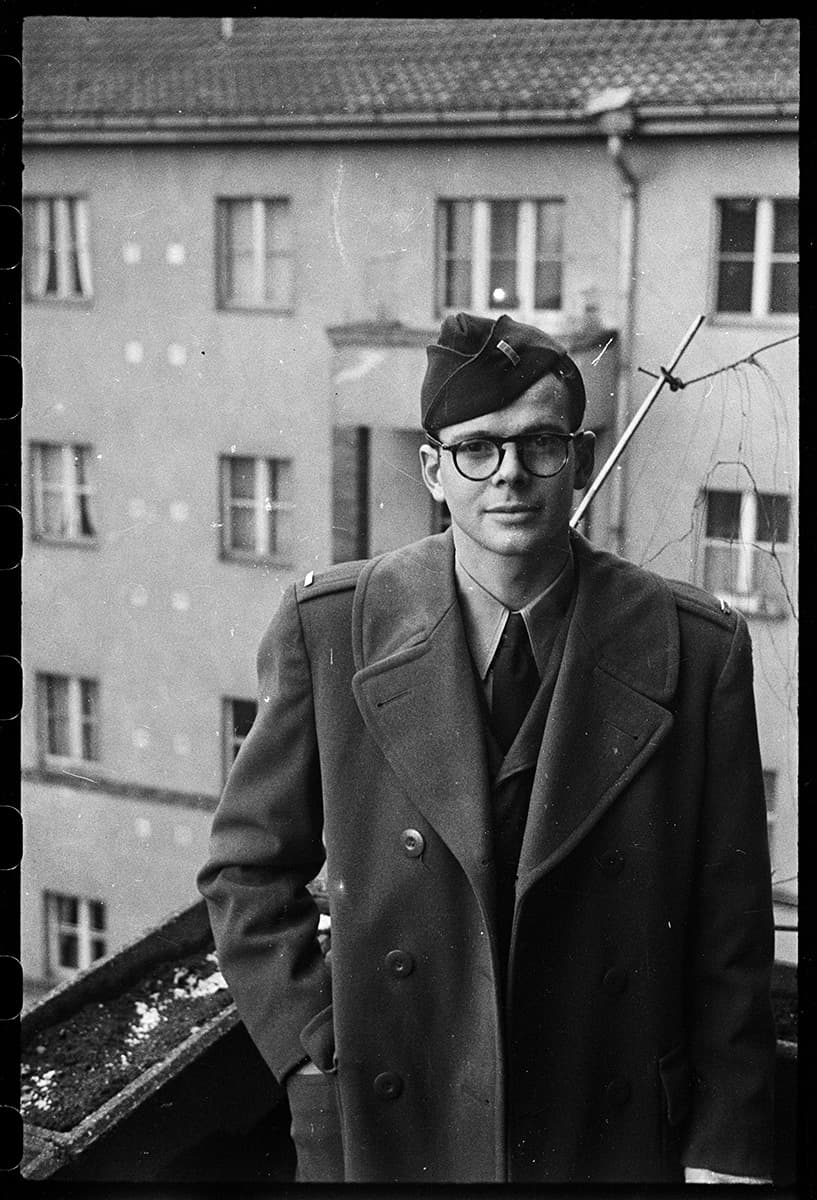
American military in the location of the unit. Berlin, Germany. October 1945
American military in the location of the unit. Berlin, Germany. October 1945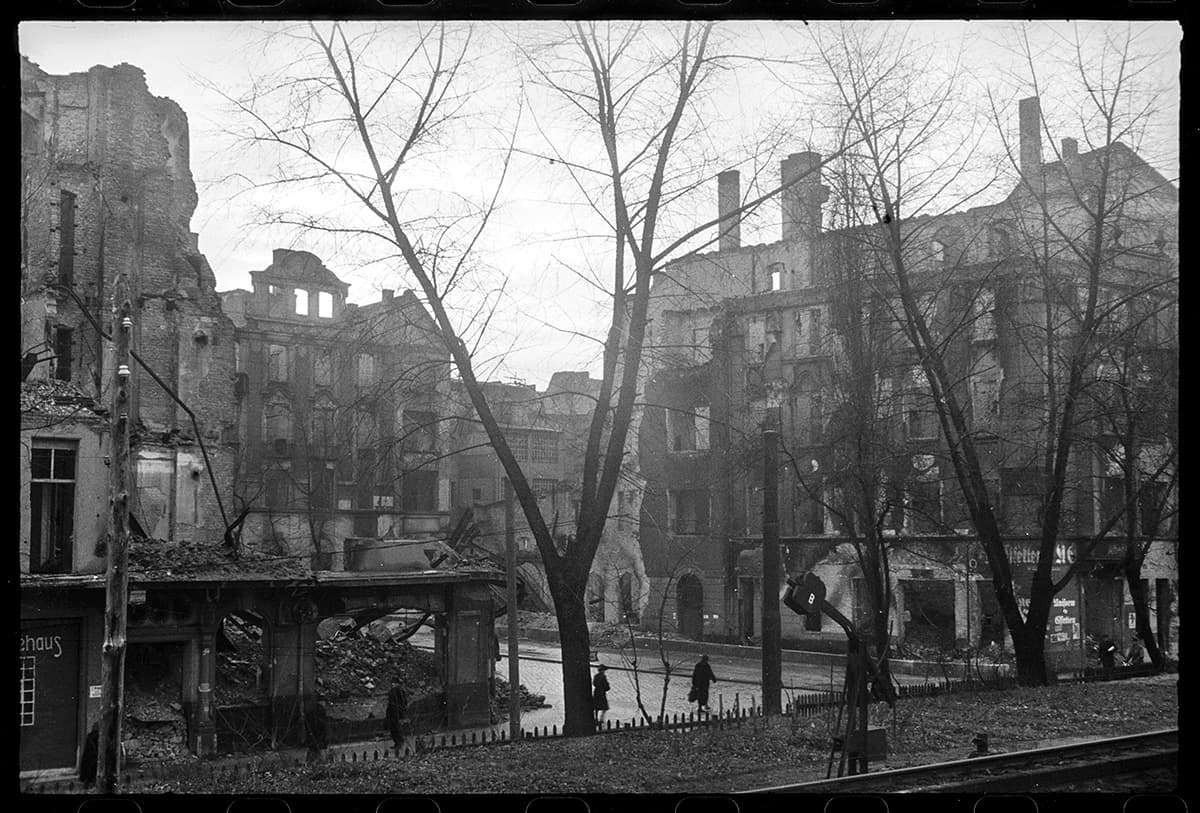
An image of a district in a war-torn city, taken from a train. Berlin, Germany. 1945
An image of a district in a war-torn city, taken from a train. Berlin, Germany. 1945
Two adjacent shots on film. Destroyed German anti-aircraft guns and American military in an armoured car. Germany. 1945
Two adjacent shots on film. Destroyed German anti-aircraft guns and American military in an armoured car. Germany. 1945
American military man with a puppy, presumably of the Riesenschnauzer breed, in a railway carriage. Germany. 1945
American military man with a puppy, presumably of the Riesenschnauzer breed, in a railway carriage. Germany. 1945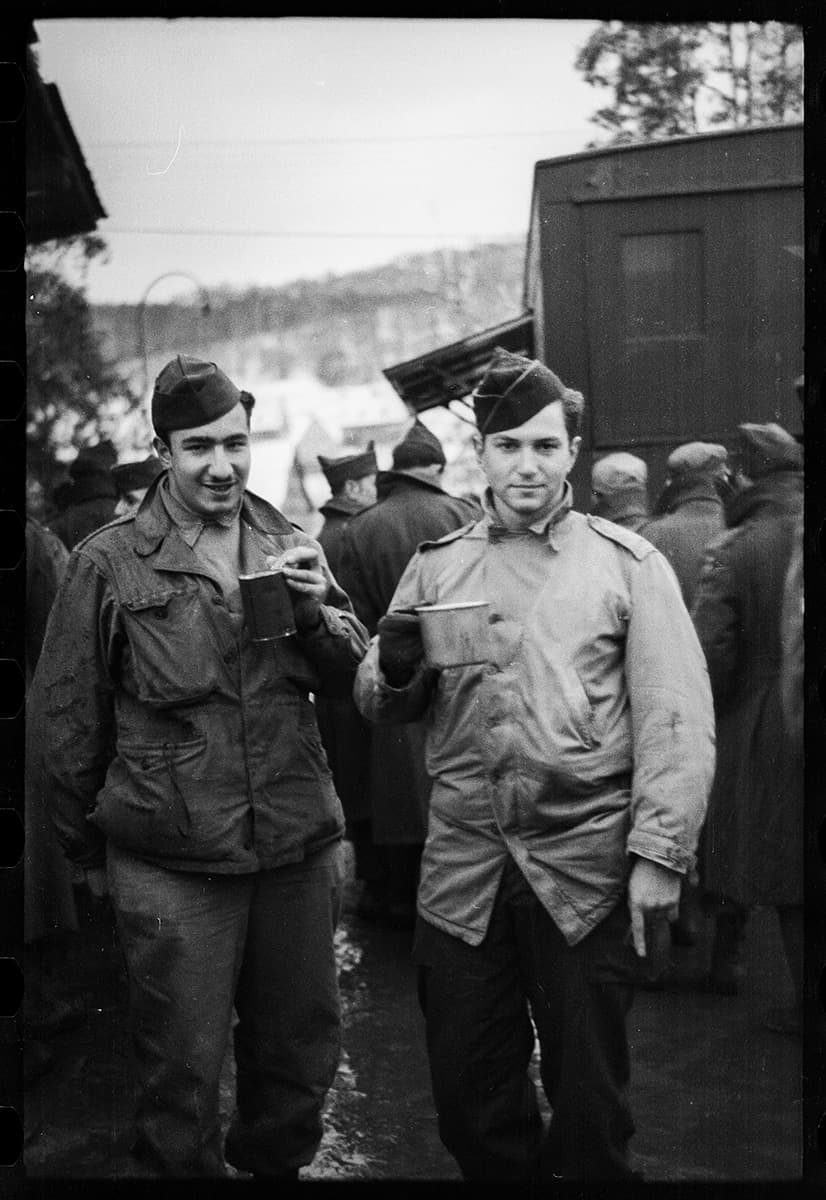
Portrait of Sam Jaffe and a fellow serviceman during a lunch stop at a railway station. Germany. 1945
Portrait of Sam Jaffe and a fellow serviceman during a lunch stop at a railway station. Germany. 1945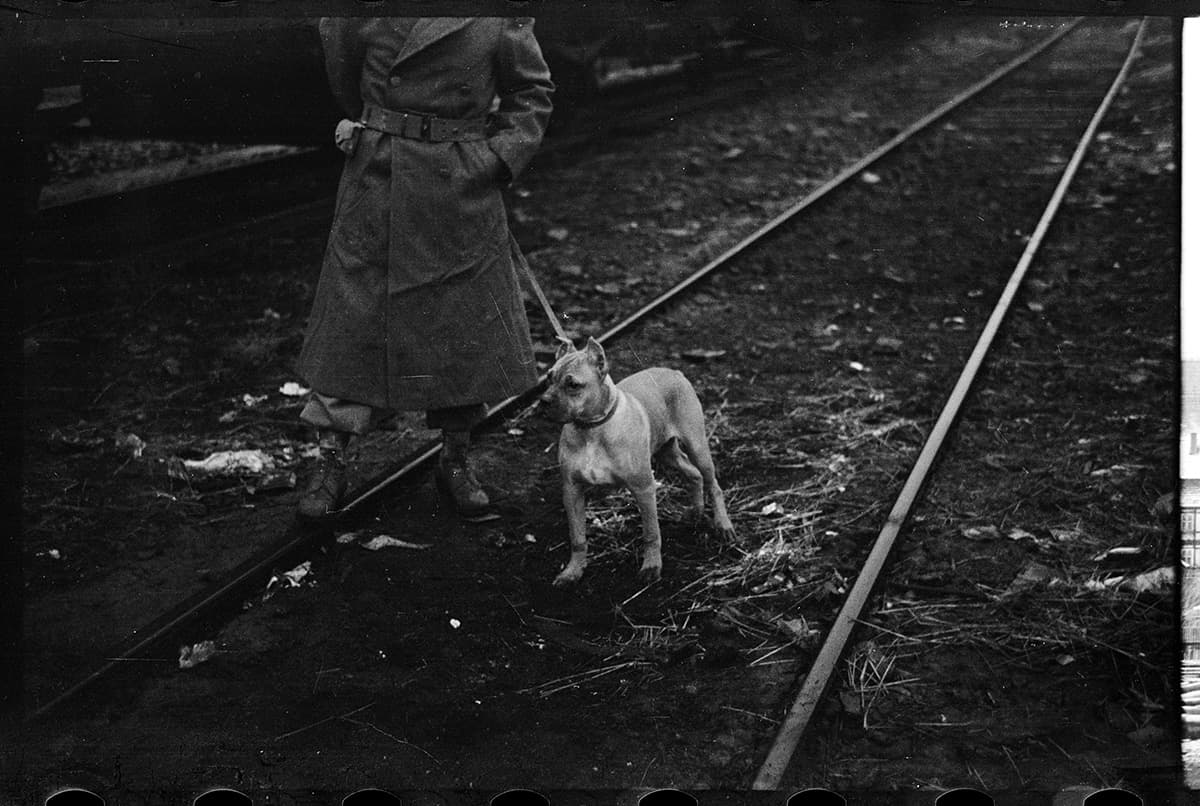
A US soldier with a dog, presumably of the pit bull breed, at a railway station while parking. Germany. 1945
A US soldier with a dog, presumably of the pit bull breed, at a railway station while parking. Germany. 1945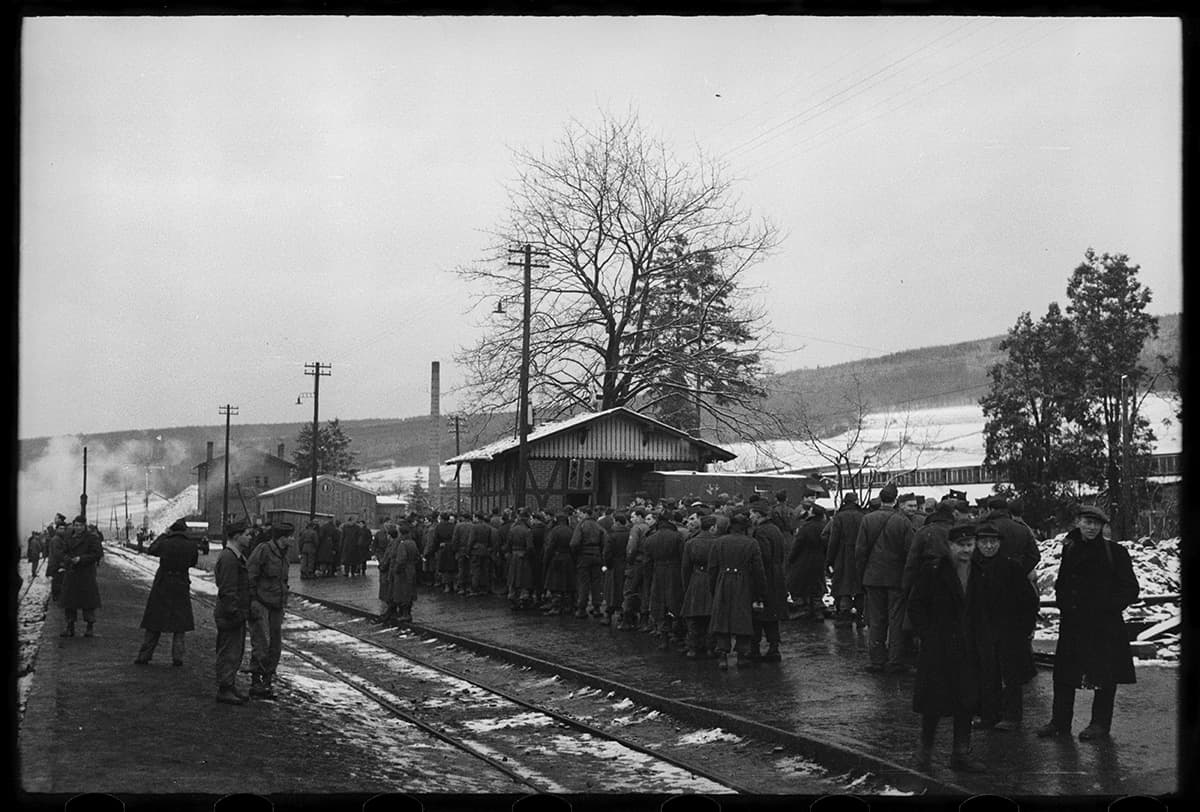
US military during a lunch stop at a railway station. Germany. 1945
US military during a lunch stop at a railway station. Germany. 1945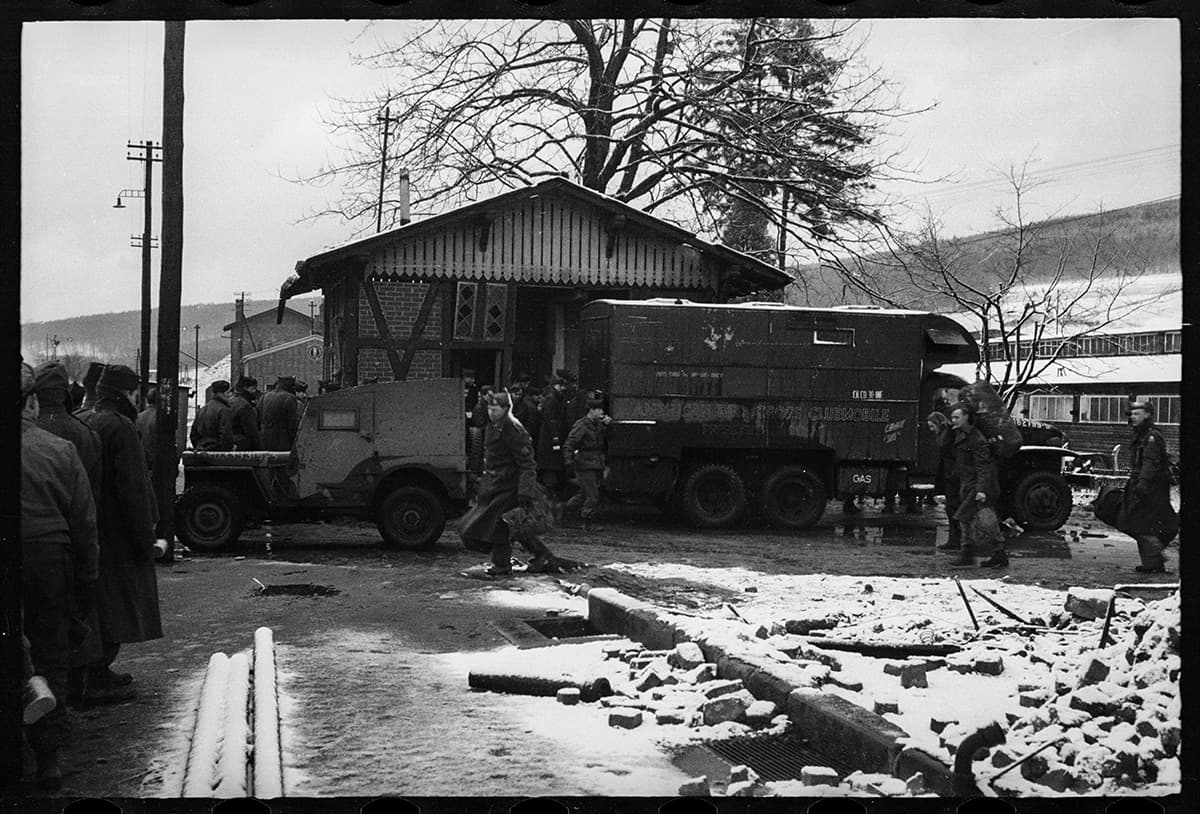
US military during a lunch stop at a railway station. Germany. 1945
US military during a lunch stop at a railway station. Germany. 1945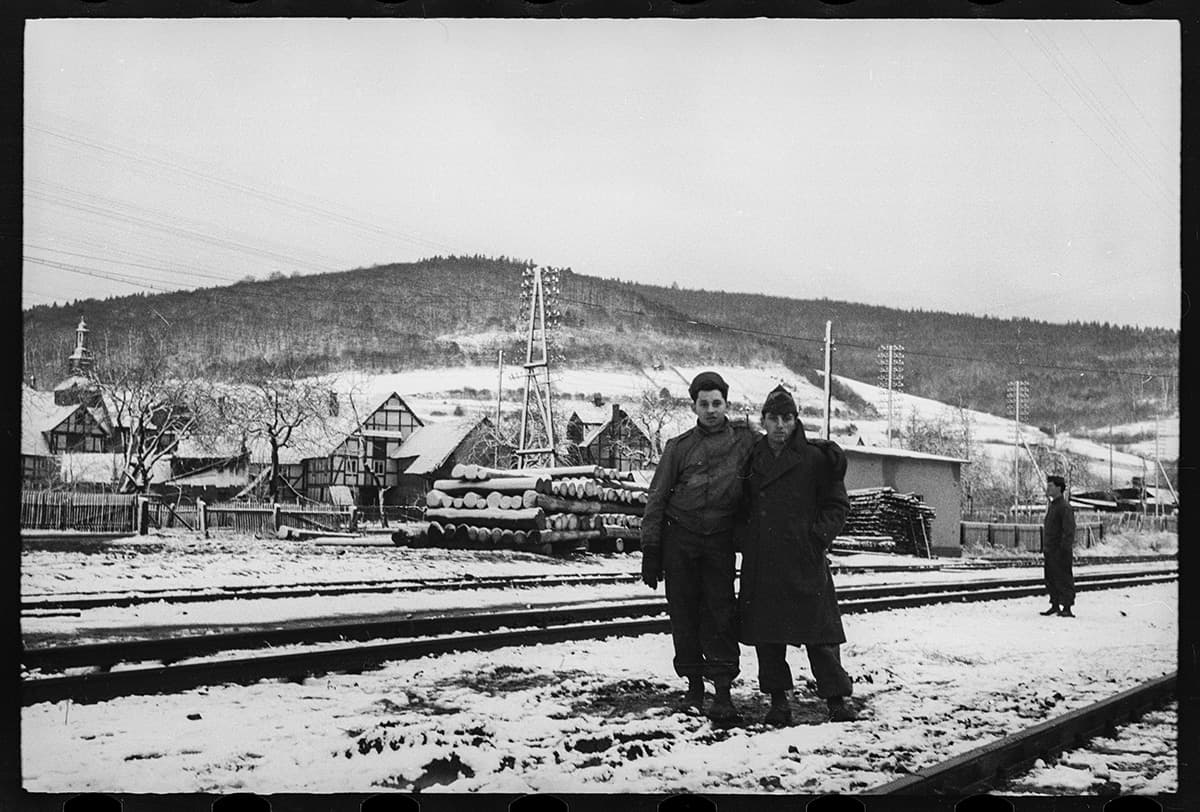
Portrait of Sam Jaffe and a fellow serviceman during a lunch stop at a railway station. Germany. 1945
Portrait of Sam Jaffe and a fellow serviceman during a lunch stop at a railway station. Germany. 1945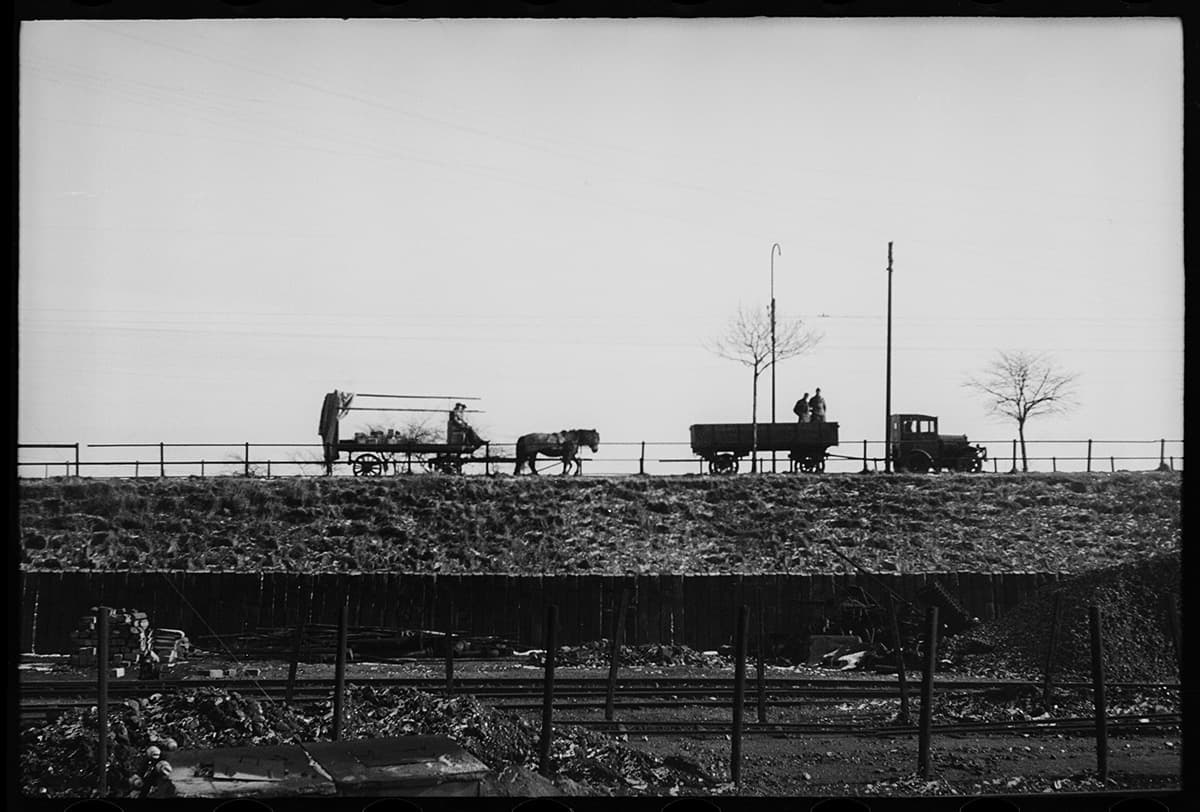
German residents. Photo taken from a railway carriage. Germany. 1945
German residents. Photo taken from a railway carriage. Germany. 1945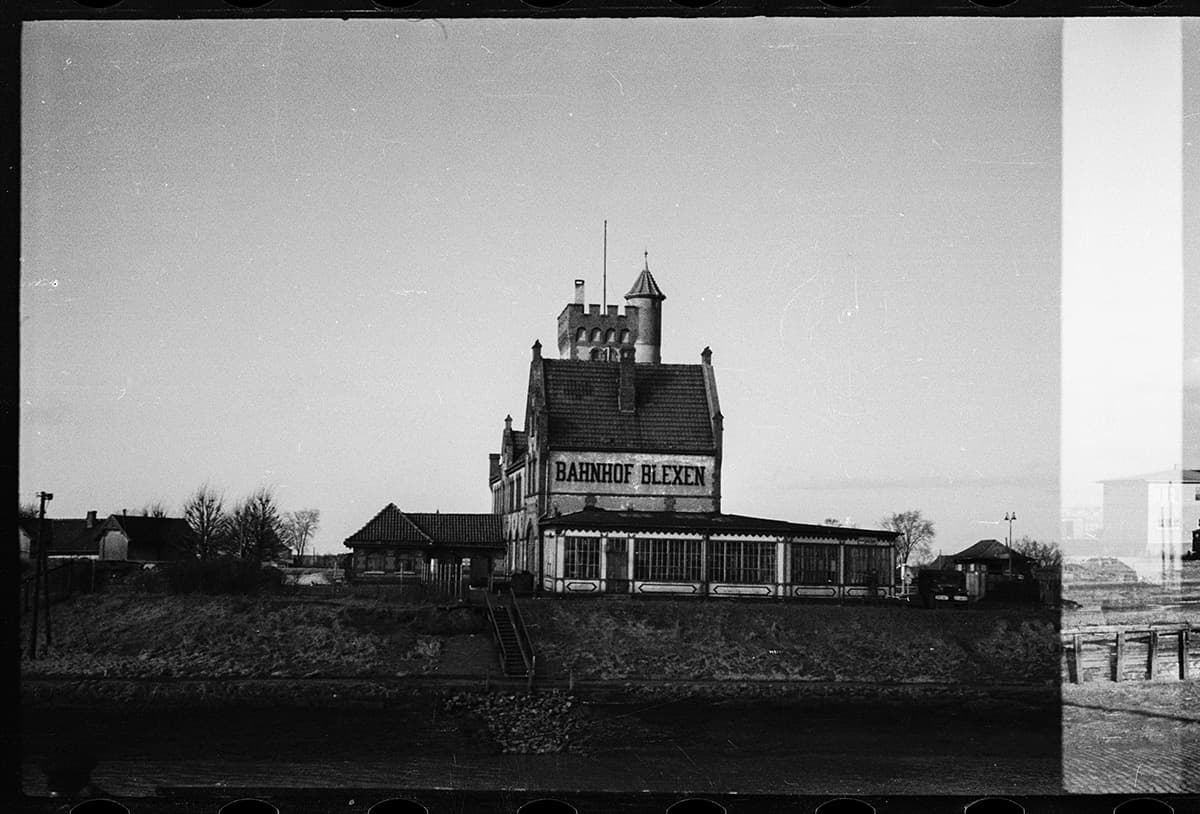
The building of the Blexen railway station. Bremerhaven, Germany. 1945
The building of the Blexen railway station. Bremerhaven, Germany. 1945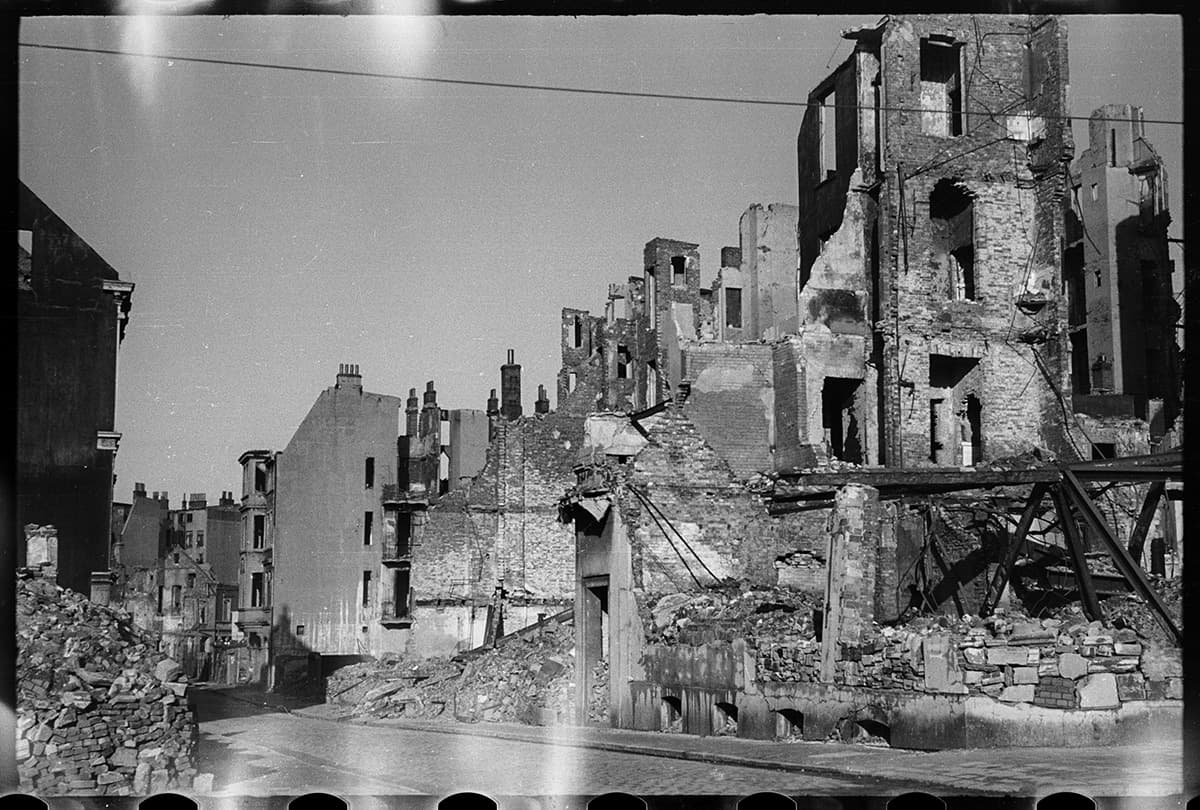
The city's residential neighbourhoods destroyed by bombing.As one of the largest bases of the Nazi Kriegsmarine war fleet in the North Sea, the city was subjected to extensive Allied bombing and 79% of the city was destroyed. But key parts of the harbour were deliberately preserved, to further supply the Allies. Bremerhaven, Germany. October - November 1945
The city's residential neighbourhoods destroyed by bombing.As one of the largest bases of the Nazi Kriegsmarine war fleet in the North Sea, the city was subjected to extensive Allied bombing and 79% of the city was destroyed. But key parts of the harbour were deliberately preserved, to further supply the Allies. Bremerhaven, Germany. October - November 1945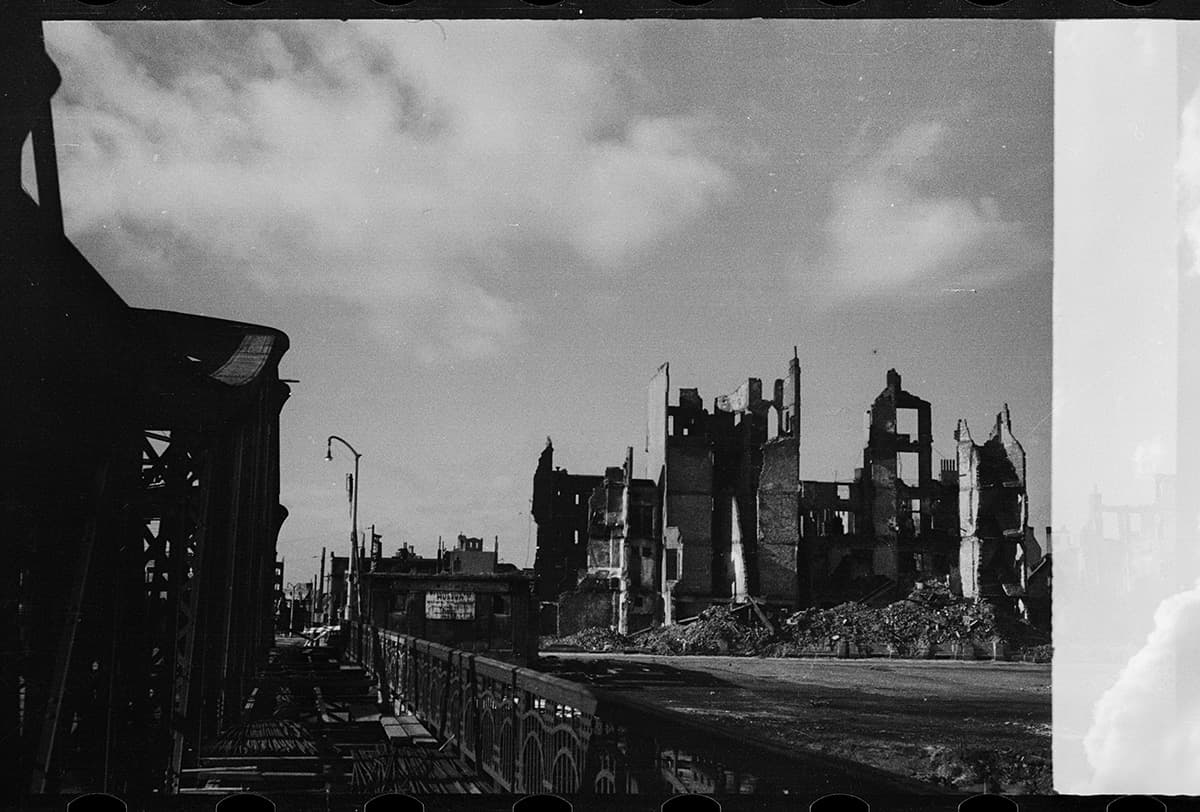
The city's residential neighbourhoods destroyed by bombing.As one of the largest bases of the Nazi Kriegsmarine war fleet in the North Sea, the city was subjected to extensive Allied bombing and 79% of the city was destroyed. But key parts of the harbour were deliberately preserved, to further supply the Allies. Bremerhaven, Germany. October - November 1945
The city's residential neighbourhoods destroyed by bombing.As one of the largest bases of the Nazi Kriegsmarine war fleet in the North Sea, the city was subjected to extensive Allied bombing and 79% of the city was destroyed. But key parts of the harbour were deliberately preserved, to further supply the Allies. Bremerhaven, Germany. October - November 1945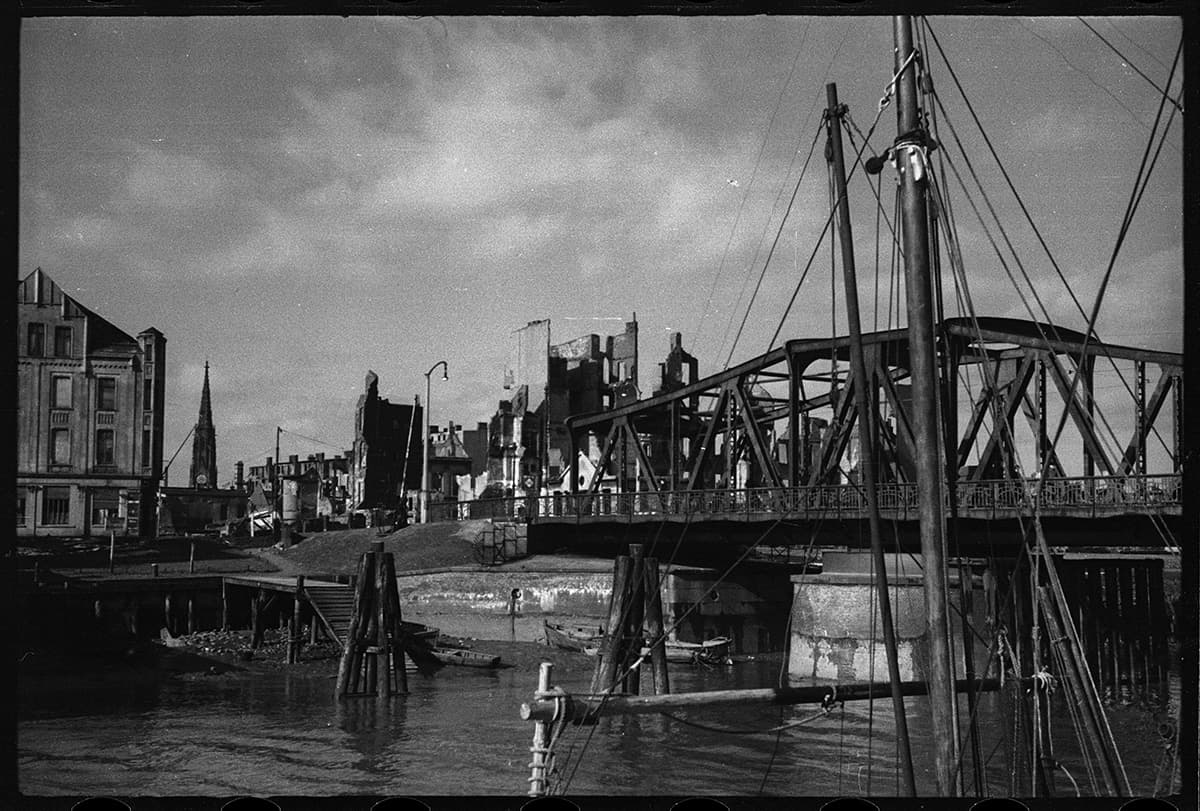
The city's residential neighbourhoods destroyed by bombing.As one of the largest bases of the Nazi Kriegsmarine war fleet in the North Sea, the city was subjected to extensive Allied bombing and 79% of the city was destroyed. But key parts of the harbour were deliberately preserved, to further supply the Allies. Bremerhaven, Germany. October - November 1945
The city's residential neighbourhoods destroyed by bombing.As one of the largest bases of the Nazi Kriegsmarine war fleet in the North Sea, the city was subjected to extensive Allied bombing and 79% of the city was destroyed. But key parts of the harbour were deliberately preserved, to further supply the Allies. Bremerhaven, Germany. October - November 1945
A horse-drawn carriage in the streets of a ruined city. One of the horses has fallen down from exhaustion and the coachman is trying to pick it up and bring it to its senses. Bremerhaven, Germany. 1945
A horse-drawn carriage in the streets of a ruined city. One of the horses has fallen down from exhaustion and the coachman is trying to pick it up and bring it to its senses. Bremerhaven, Germany. 1945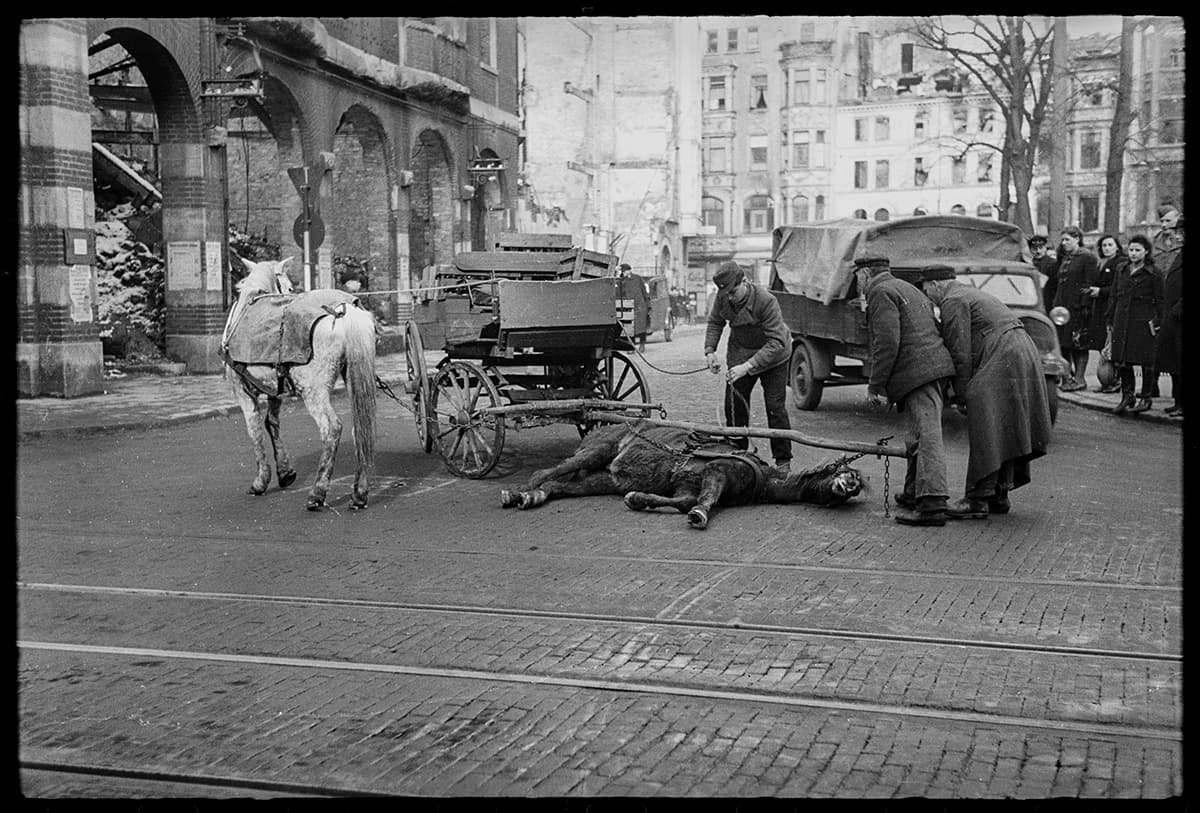
A horse-drawn carriage in the streets of a ruined city. One of the horses has fallen down from exhaustion and the coachman is trying to pick it up and bring it to its senses. Bremerhaven, Germany. 1945
A horse-drawn carriage in the streets of a ruined city. One of the horses has fallen down from exhaustion and the coachman is trying to pick it up and bring it to its senses. Bremerhaven, Germany. 1945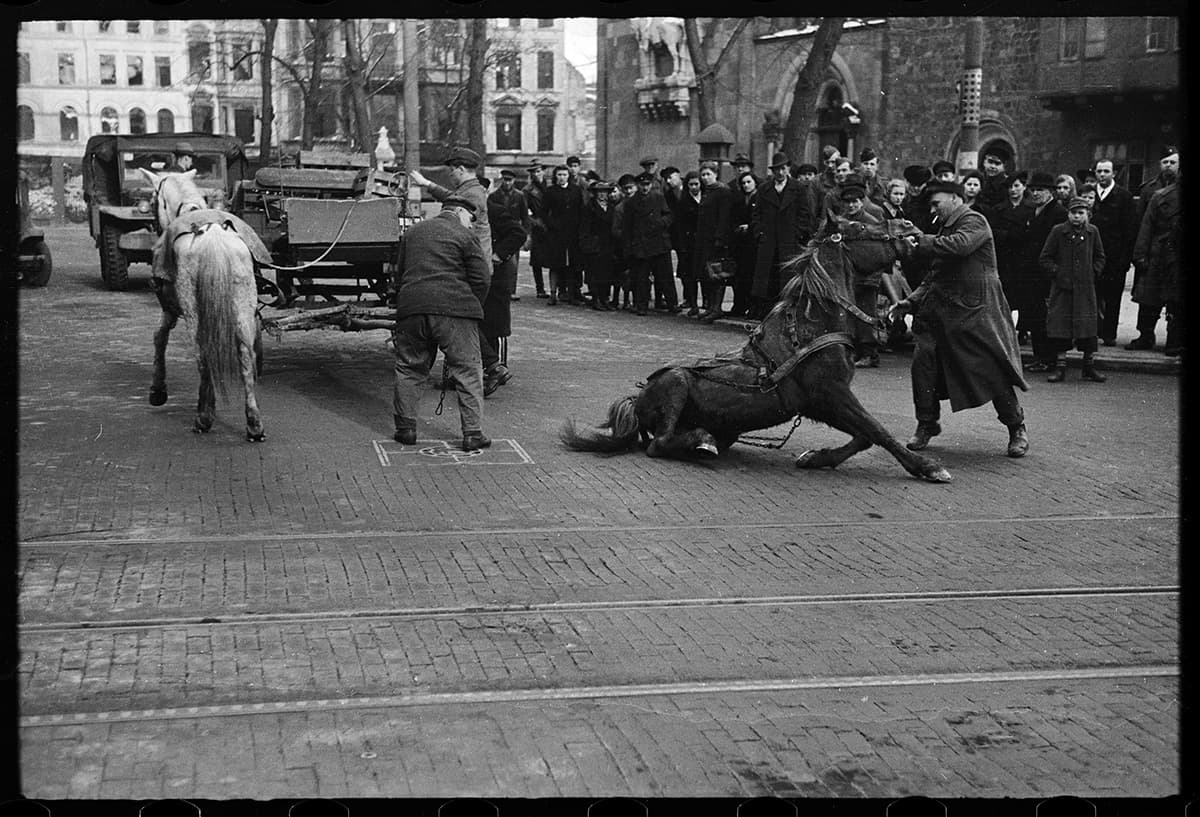
A horse-drawn carriage in the streets of a ruined city. One of the horses has fallen down from exhaustion and the coachman is trying to pick it up and bring it to its senses. Bremerhaven, Germany. 1945
A horse-drawn carriage in the streets of a ruined city. One of the horses has fallen down from exhaustion and the coachman is trying to pick it up and bring it to its senses. Bremerhaven, Germany. 1945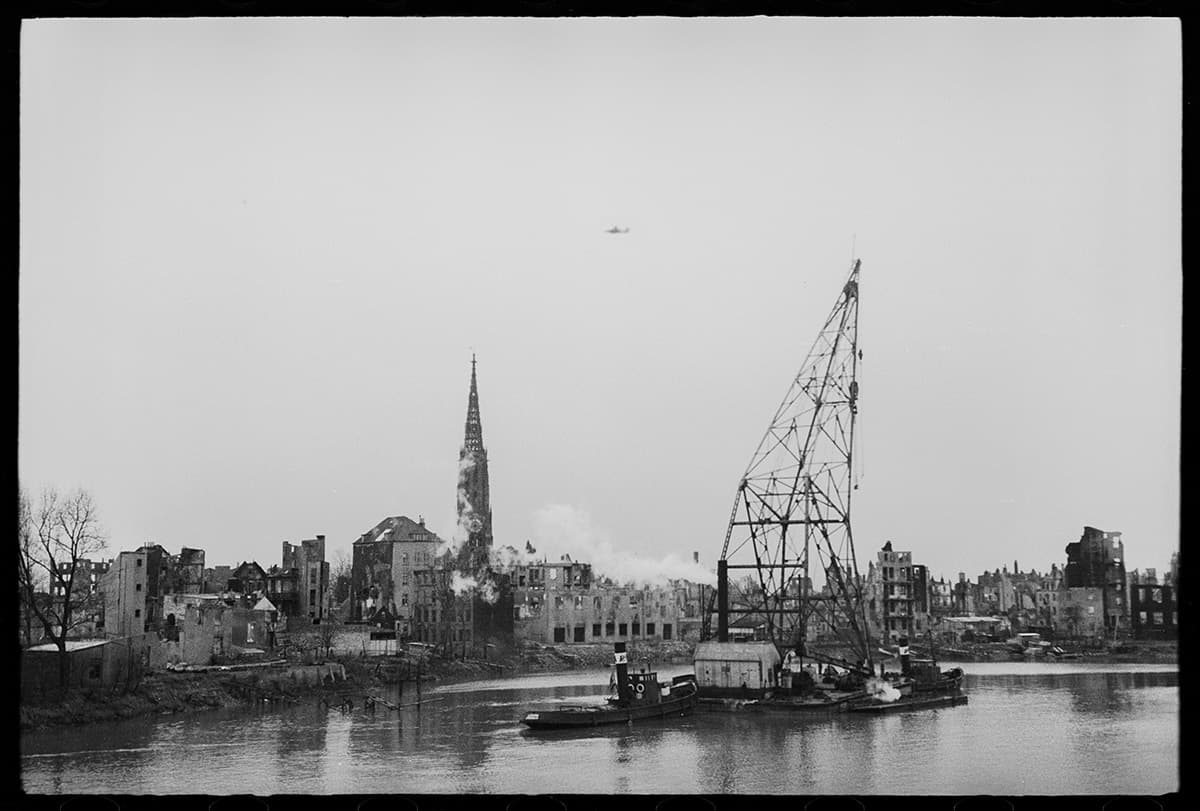
Barges pulling a floating crane on the river Geeste. Bremerhaven, Germany. 1945
Barges pulling a floating crane on the river Geeste. Bremerhaven, Germany. 1945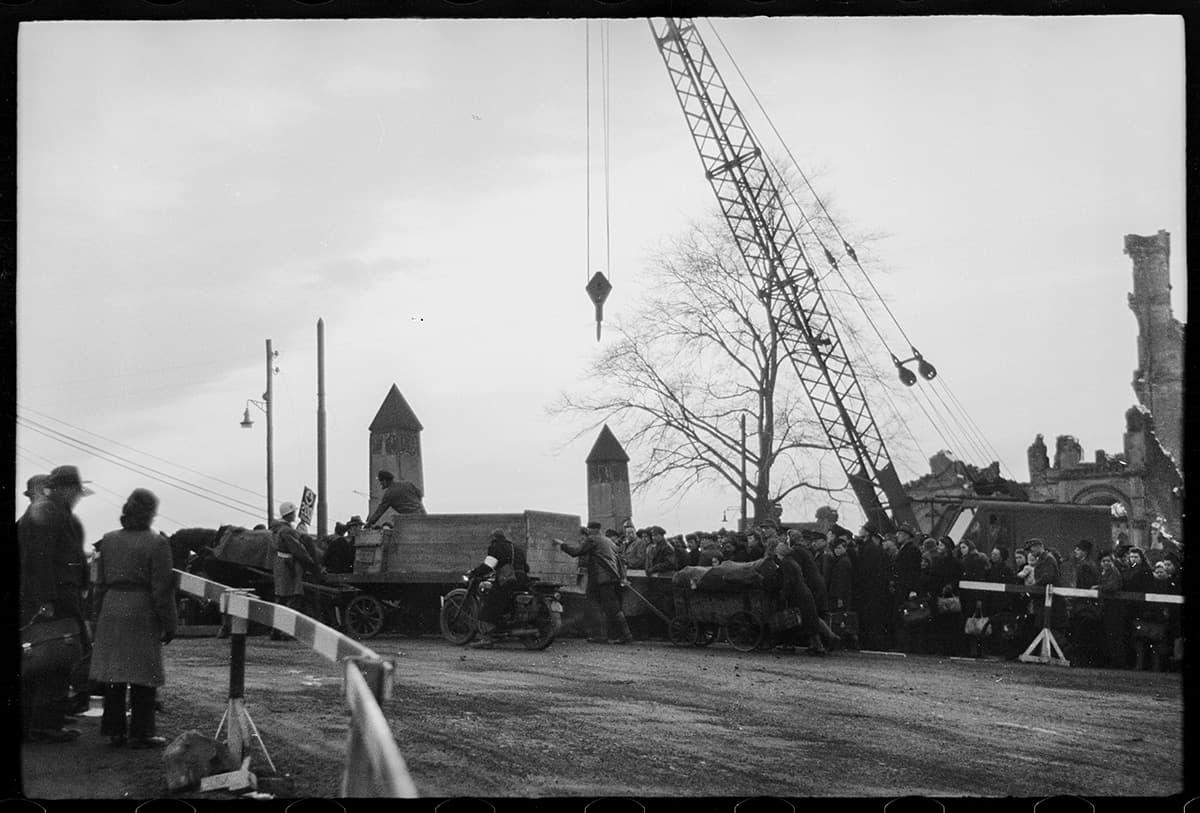
A US military policeman directs traffic at one of the intersections in the ruined city. Bremerhaven, Germany. 1945
A US military policeman directs traffic at one of the intersections in the ruined city. Bremerhaven, Germany. 1945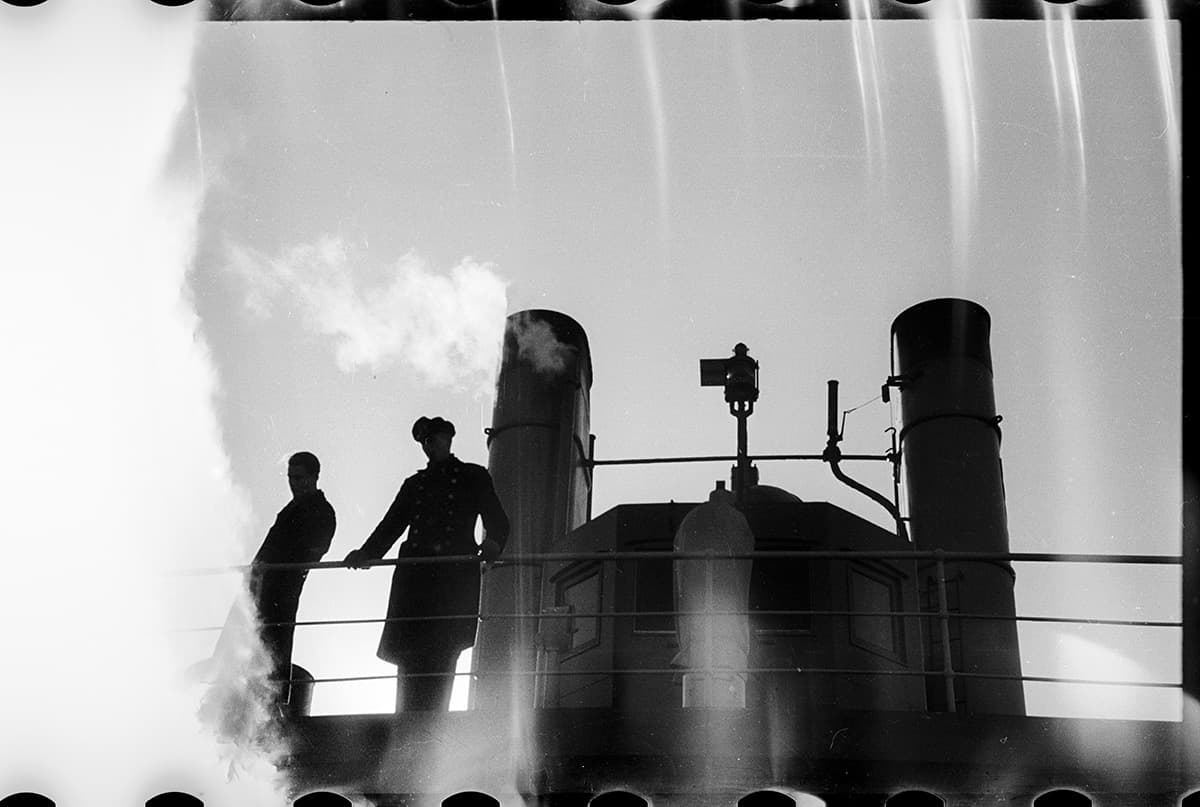
German sailors on a ship in the harbour. Bremerhaven, Germany. 1945
German sailors on a ship in the harbour. Bremerhaven, Germany. 1945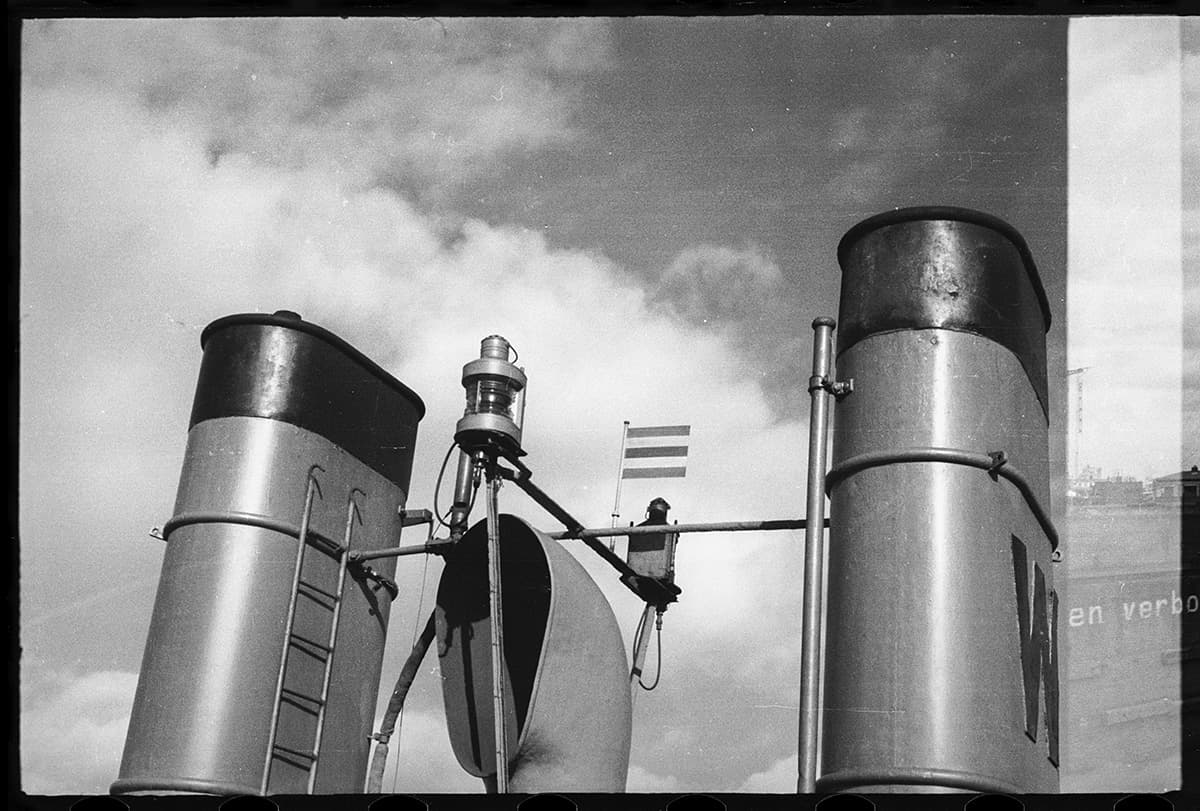
German ship in the harbour. Bremerhaven, Germany. 1945
German ship in the harbour. Bremerhaven, Germany. 1945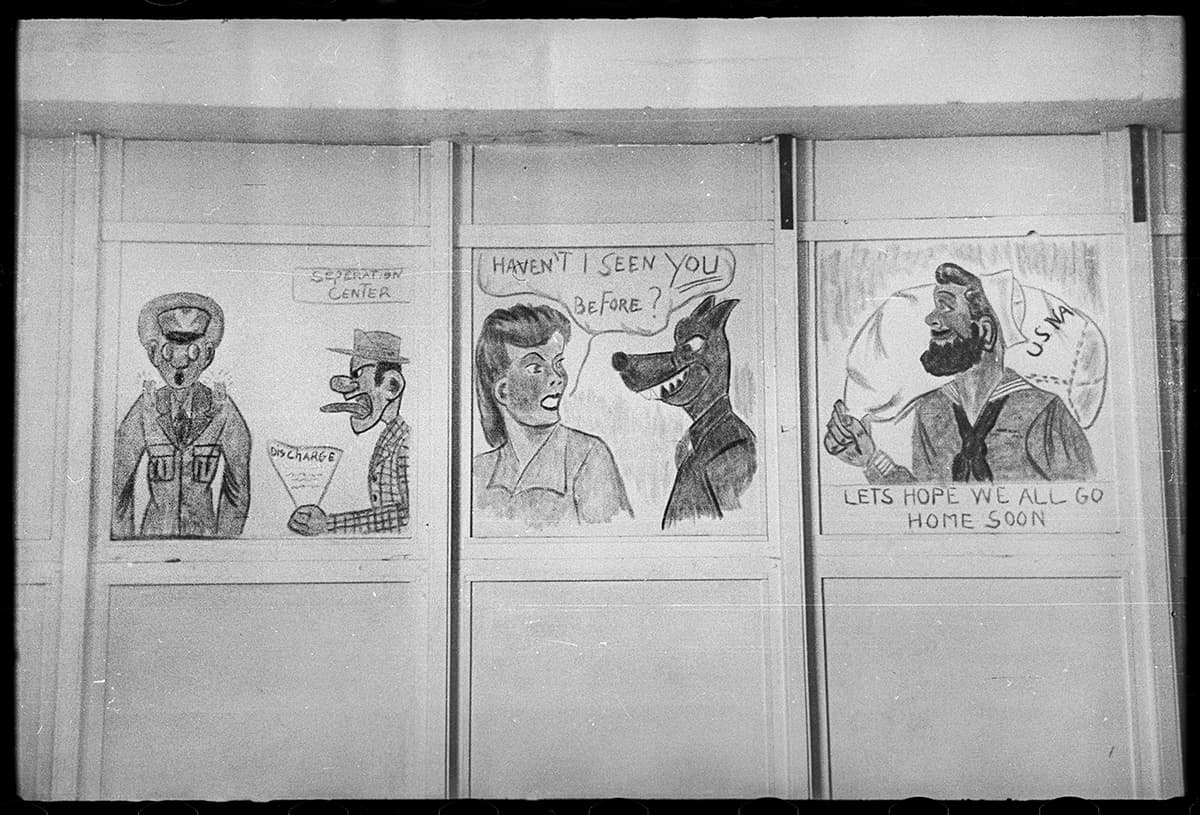
The cartoons are from an American military unit. The third cartoon shows an American sailor with a duffel bag and the inscription "Let's hope we all go home soon". Bremerhaven, Germany. 1945
The cartoons are from an American military unit. The third cartoon shows an American sailor with a duffel bag and the inscription "Let's hope we all go home soon". Bremerhaven, Germany. 1945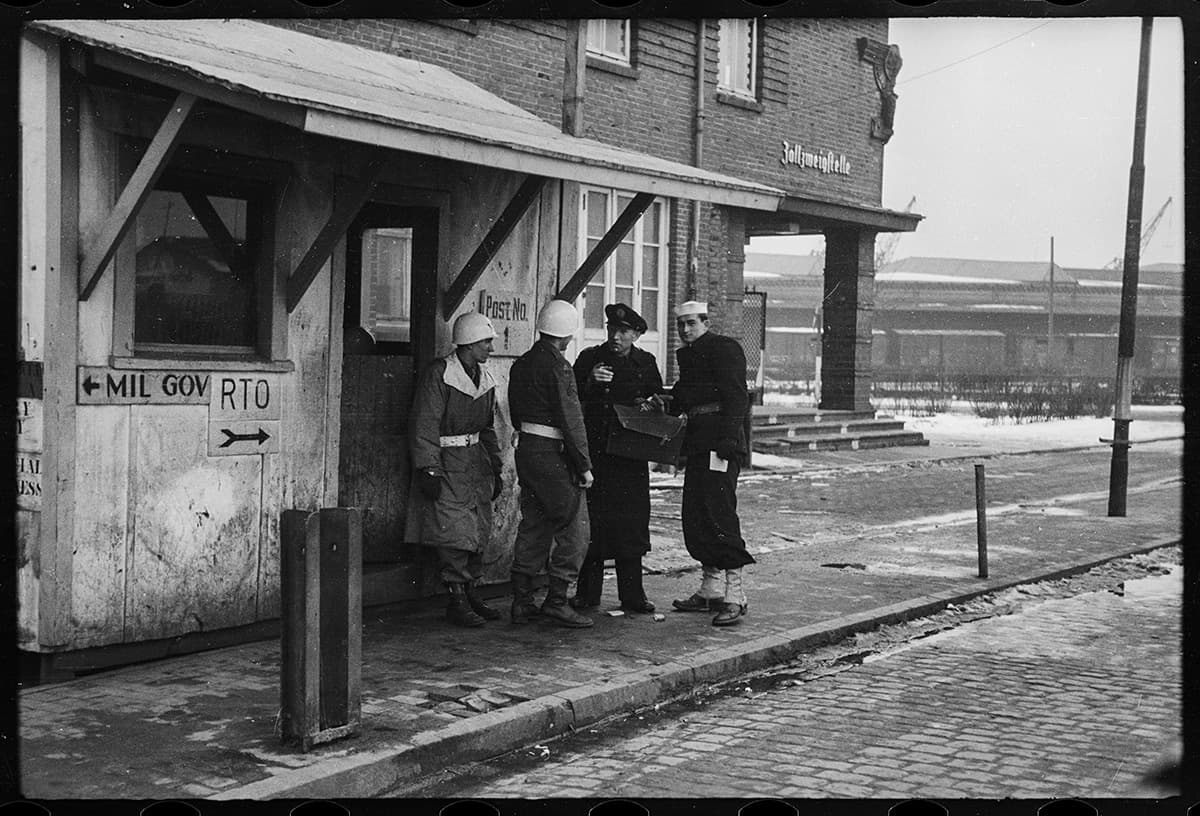
American sailors at the N1 checkpoint. Bremerhaven, Germany. 1945
American sailors at the N1 checkpoint. Bremerhaven, Germany. 1945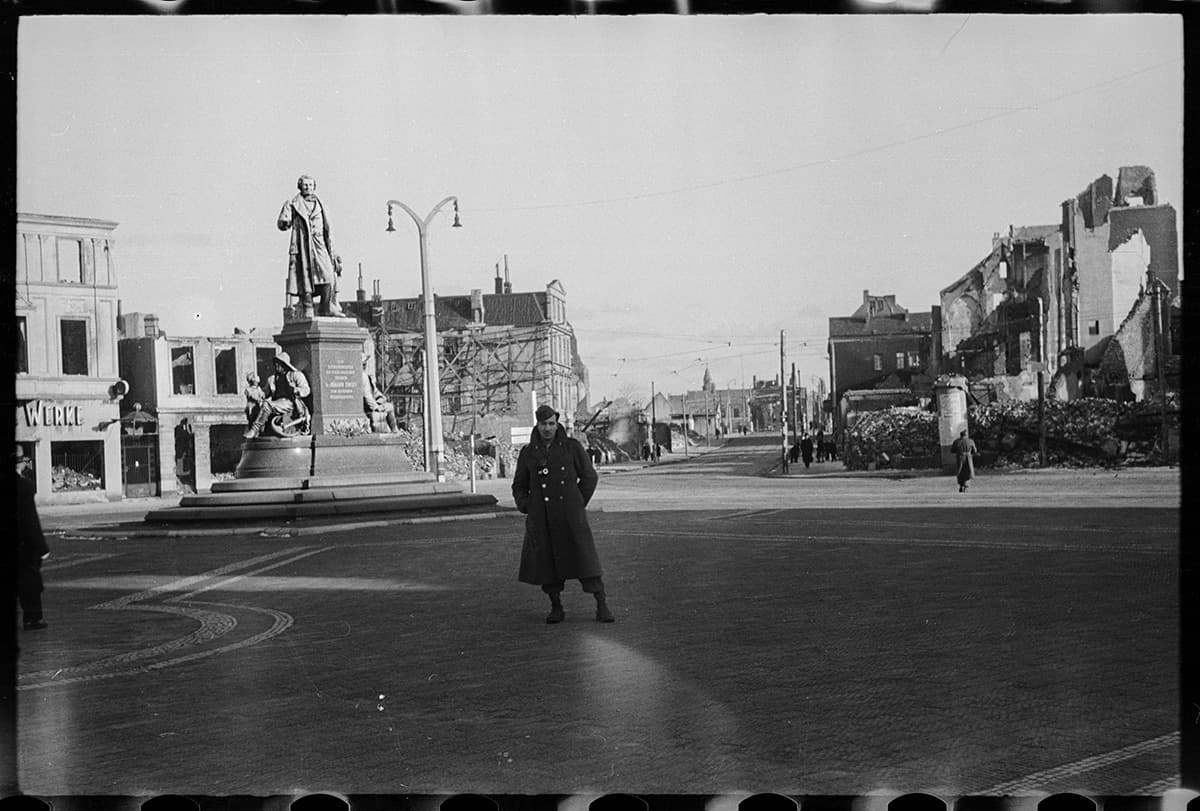
A portrait of Sam Jaffe amidst ruined houses and a surviving monument to the town's founder, burgomaster Johann Schmidt. The town was founded by Schmidt in 1827. Bremerhaven, Germany. 1945
A portrait of Sam Jaffe amidst ruined houses and a surviving monument to the town's founder, burgomaster Johann Schmidt. The town was founded by Schmidt in 1827. Bremerhaven, Germany. 1945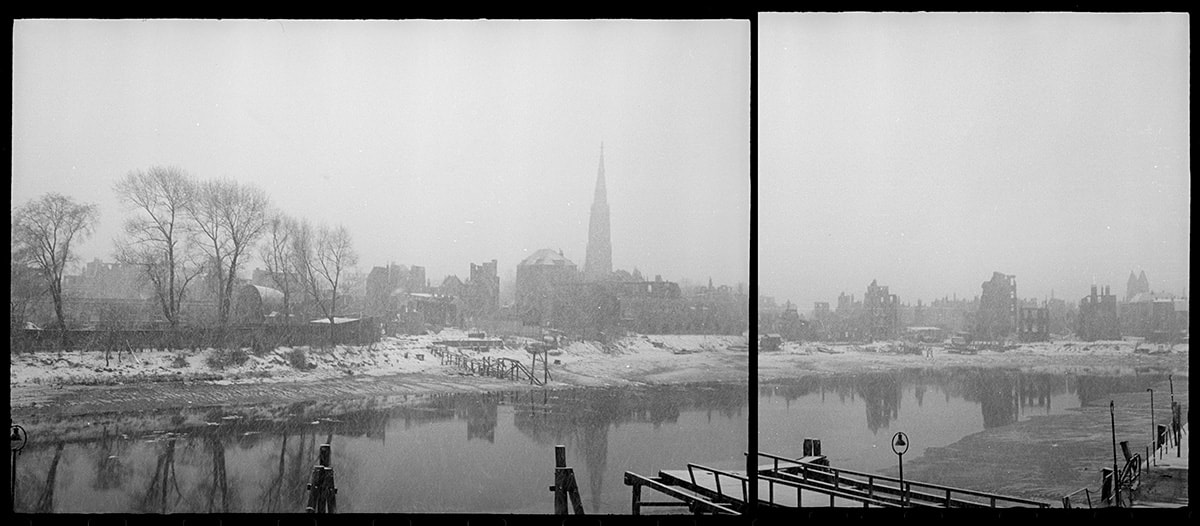
Snowfall on the Geeste River overlooking the Protestant Church (the church is also a monument to the city's founder, Johann Schmidt.) It was built in 1849 and consecrated in 1855. The church was rebuilt after the war. Bremerhaven, Germany. Winter 1945
Snowfall on the Geeste River overlooking the Protestant Church (the church is also a monument to the city's founder, Johann Schmidt.) It was built in 1849 and consecrated in 1855. The church was rebuilt after the war. Bremerhaven, Germany. Winter 1945
Bremen's St Peter's Cathedral. Bremen, Germany. Winter 1945
Bremen's St Peter's Cathedral. Bremen, Germany. Winter 1945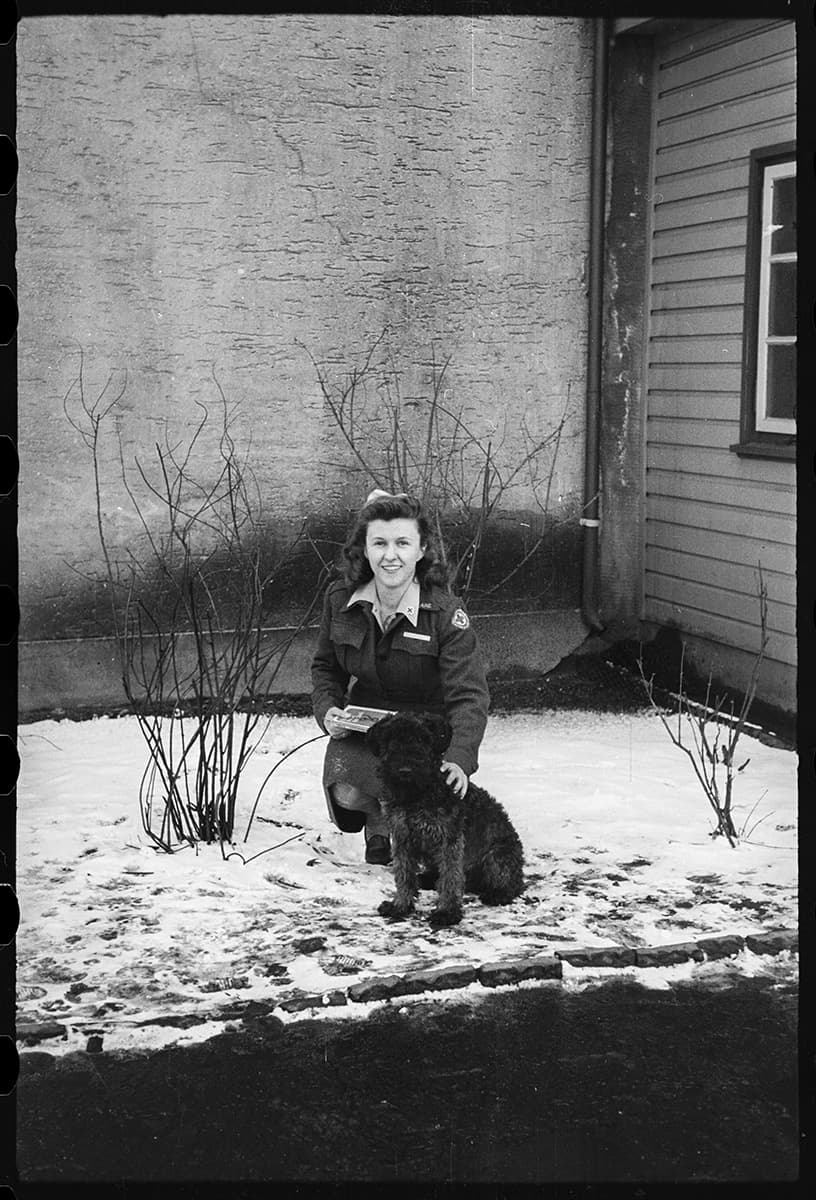
An employee of the American Red Cross. Bremerhaven, Germany. Winter 1945
An employee of the American Red Cross. Bremerhaven, Germany. Winter 1945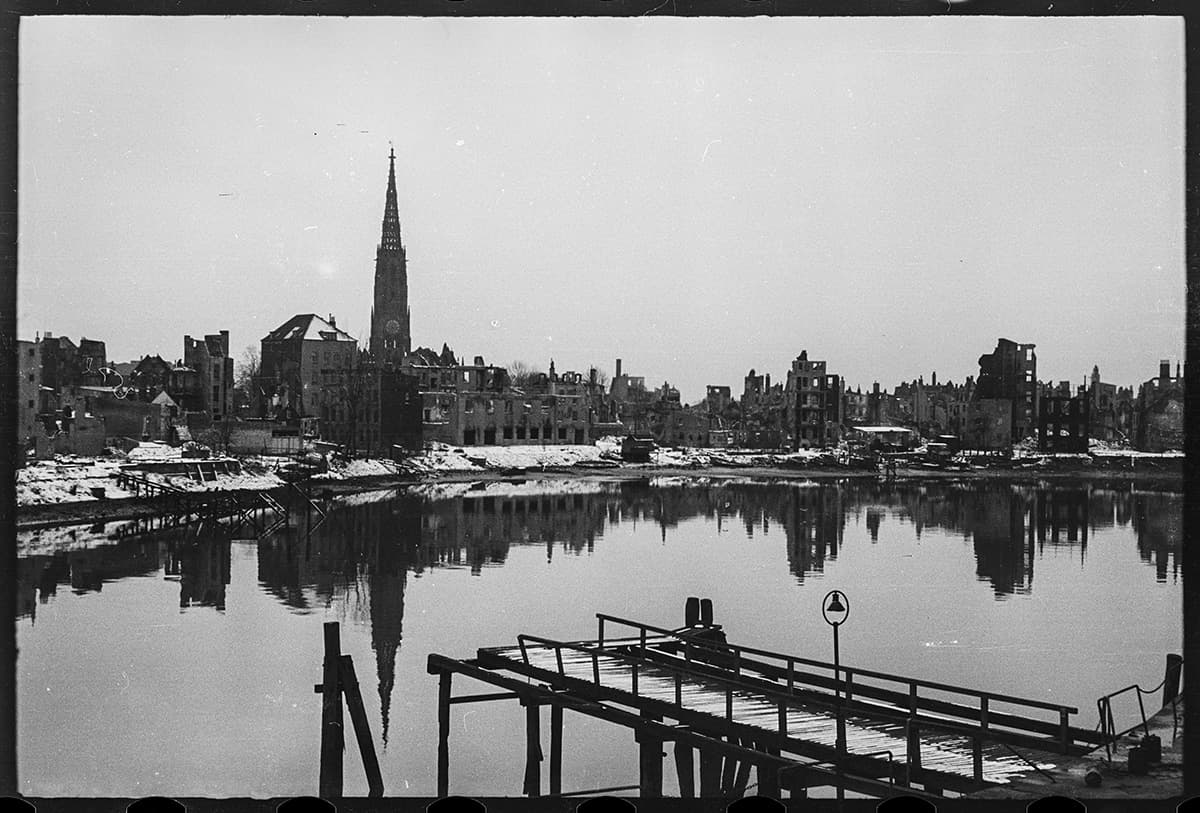
The Geeste River overlooking the Protestant Church (the church is also a monument to the town's founder Johann Schmidt.) It was built in 1849 and consecrated in 1855. The church was rebuilt after the war. Bremerhaven, Germany. Winter 1945
The Geeste River overlooking the Protestant Church (the church is also a monument to the town's founder Johann Schmidt.) It was built in 1849 and consecrated in 1855. The church was rebuilt after the war. Bremerhaven, Germany. Winter 1945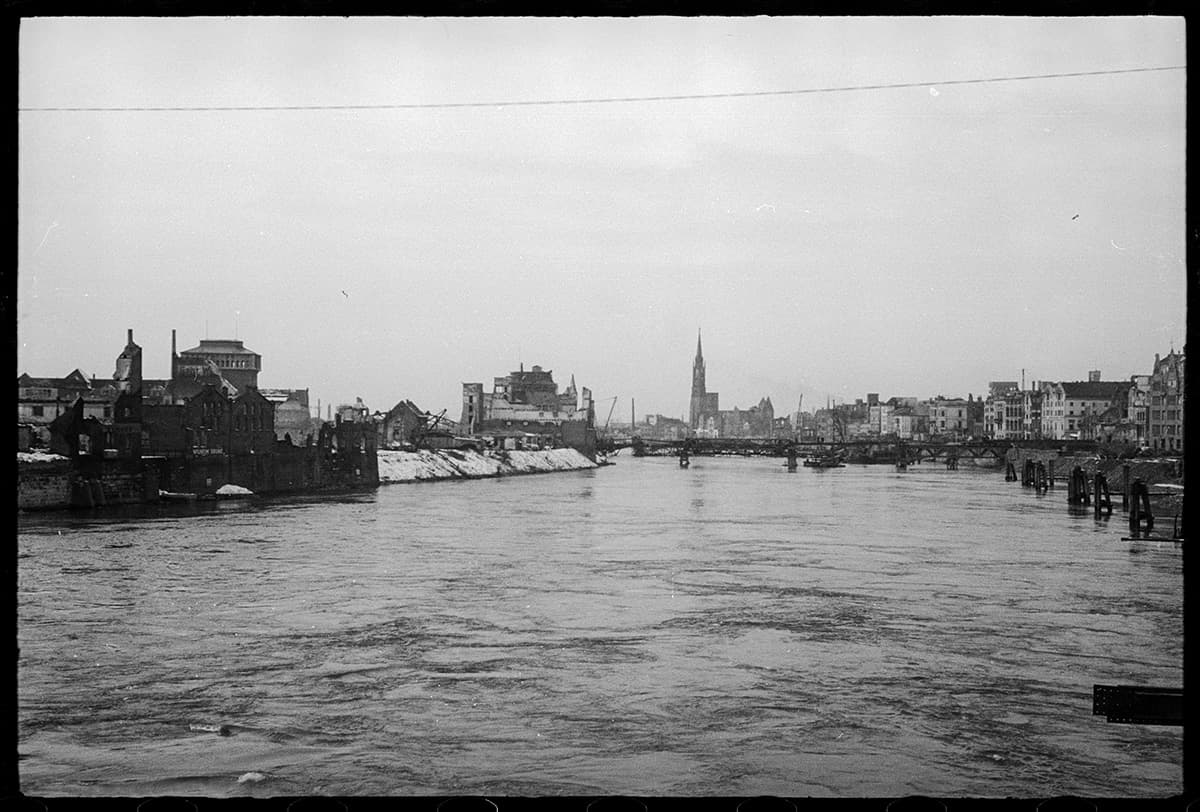
View of the Geeste River with destroyed bridges and crossings. Bremerhaven, Germany. Winter 1945
View of the Geeste River with destroyed bridges and crossings. Bremerhaven, Germany. Winter 1945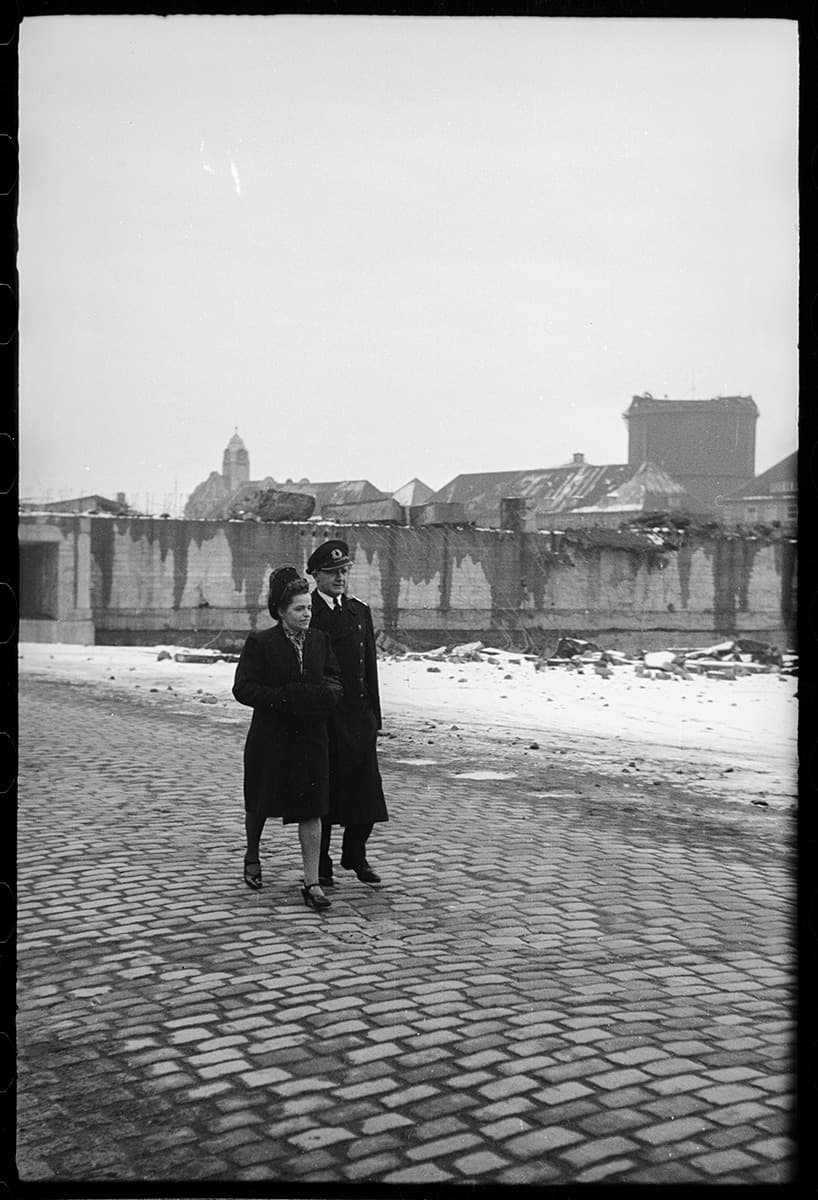
German sailor of the Kriegsmarine Navy with his wife. On the uniform can be seen removed Nazi symbols, but left epaulettes with rank. Bremerhaven, Germany. Winter 1945
German sailor of the Kriegsmarine Navy with his wife. On the uniform can be seen removed Nazi symbols, but left epaulettes with rank. Bremerhaven, Germany. Winter 1945
German sailors of the Kriegsmarine. Nazi symbols have been removed from the uniforms, but the awards and rank epaulettes remain. Bremerhaven, Germany. Winter 1945
German sailors of the Kriegsmarine. Nazi symbols have been removed from the uniforms, but the awards and rank epaulettes remain. Bremerhaven, Germany. Winter 1945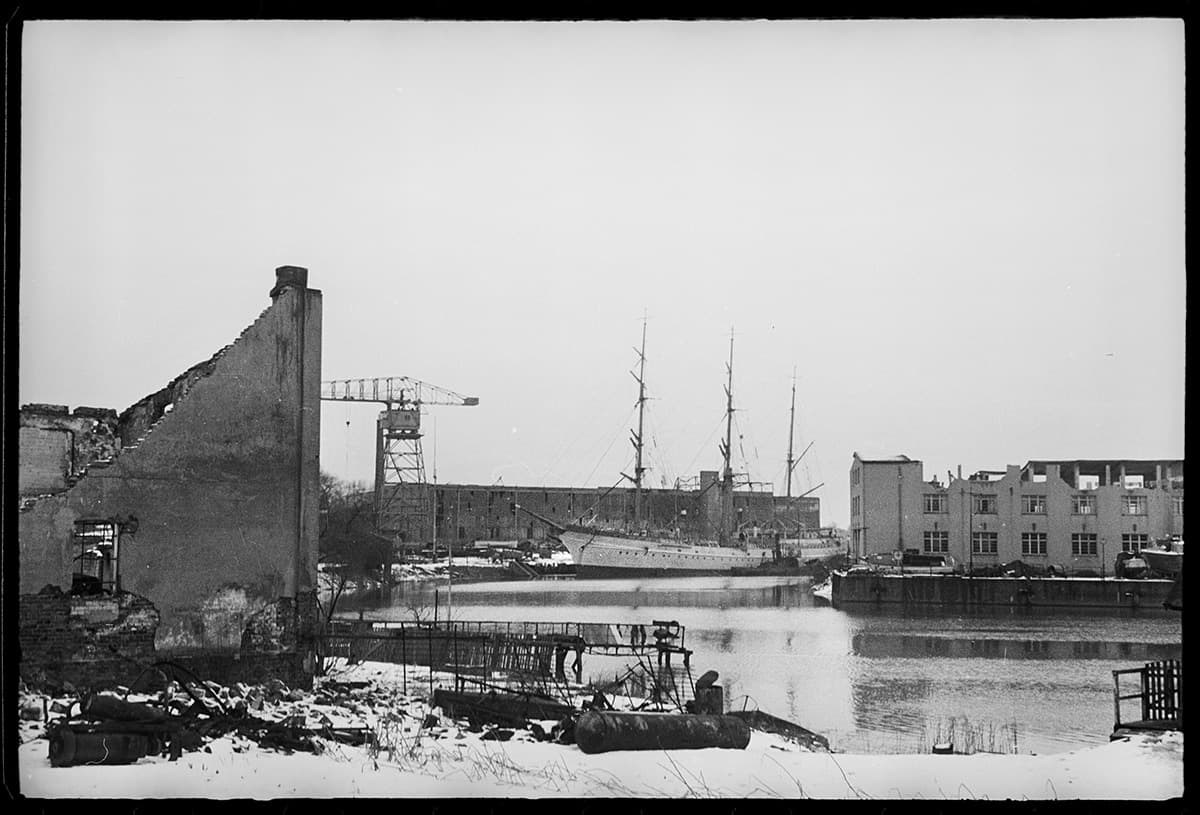
A sailing ship in a dilapidated harbour. Bremerhaven, Germany. Winter 1945
A sailing ship in a dilapidated harbour. Bremerhaven, Germany. Winter 1945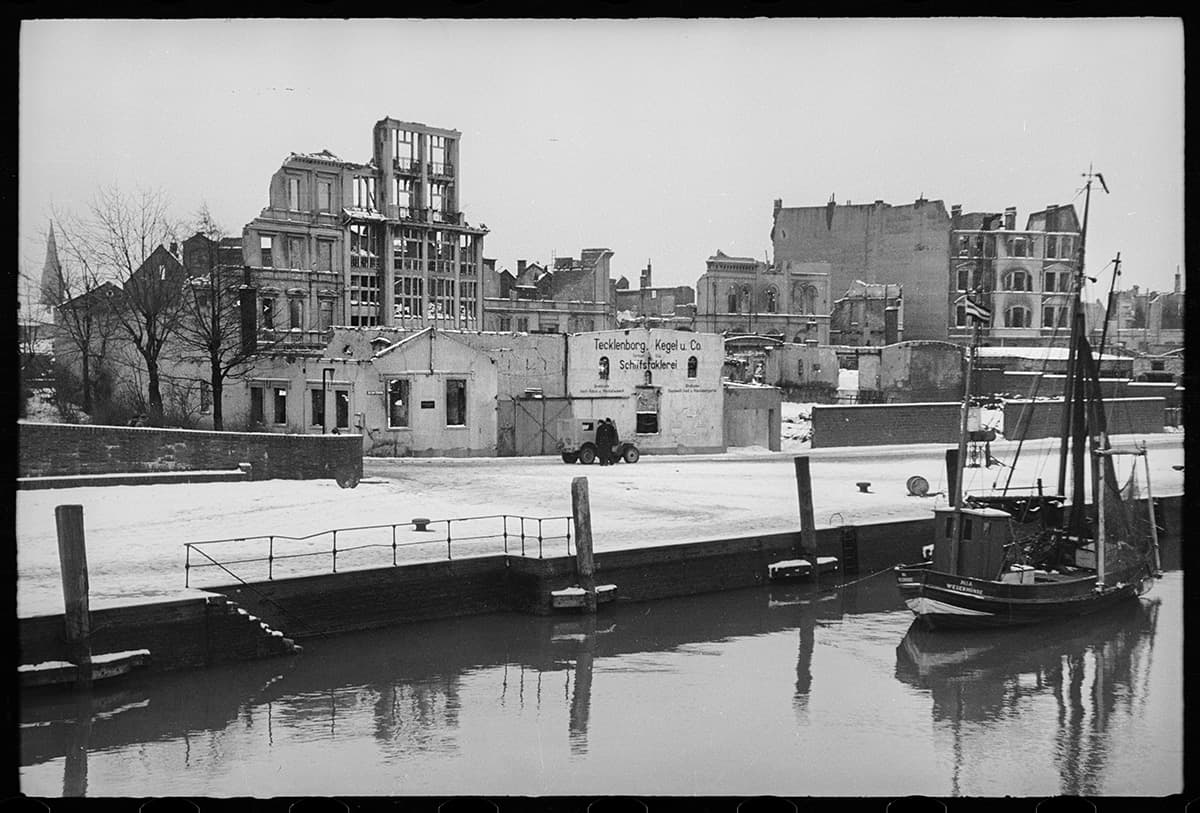
A boat named "Wesermunde" in the harbour with a background of dilapidated houses. Bremerhaven, Germany. Winter 1945
A boat named "Wesermunde" in the harbour with a background of dilapidated houses. Bremerhaven, Germany. Winter 1945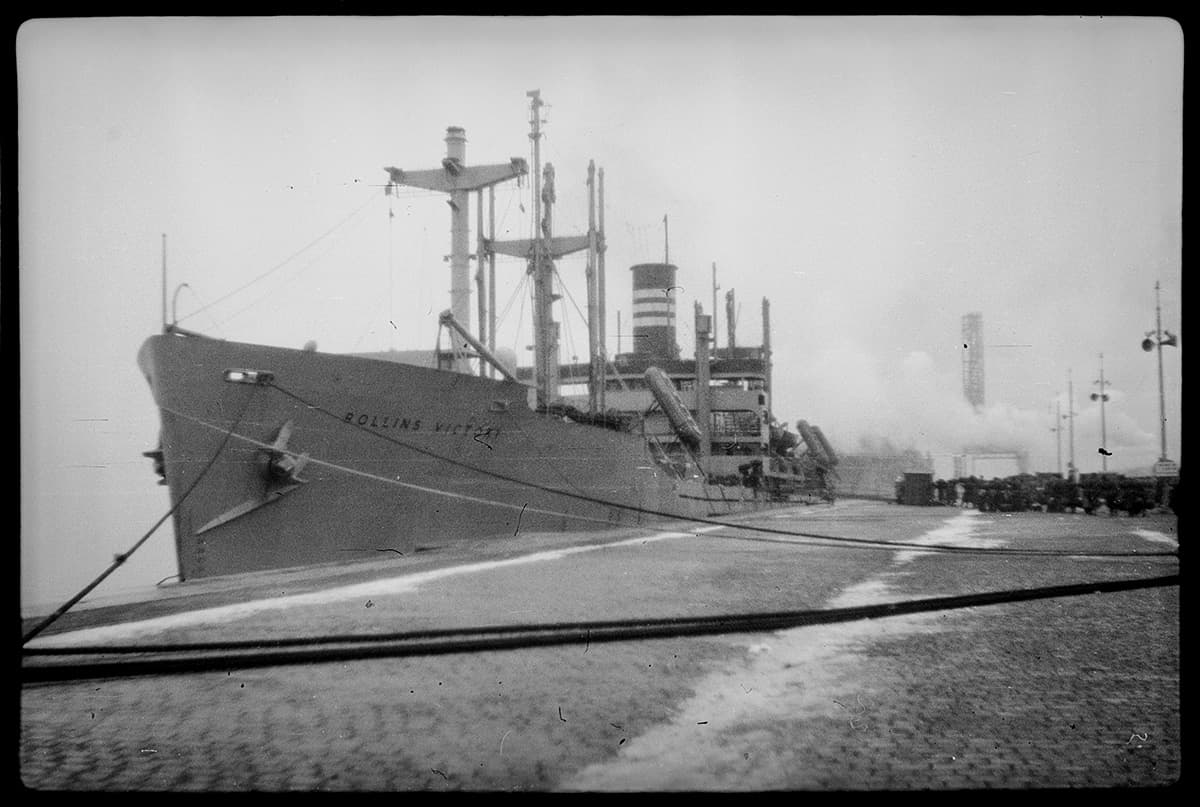
Loading of equipment and American military personnel onto the transport ship "Rollins Victory" prior to departure for America. Bremerhaven, Germany. 1946
Loading of equipment and American military personnel onto the transport ship "Rollins Victory" prior to departure for America. Bremerhaven, Germany. 1946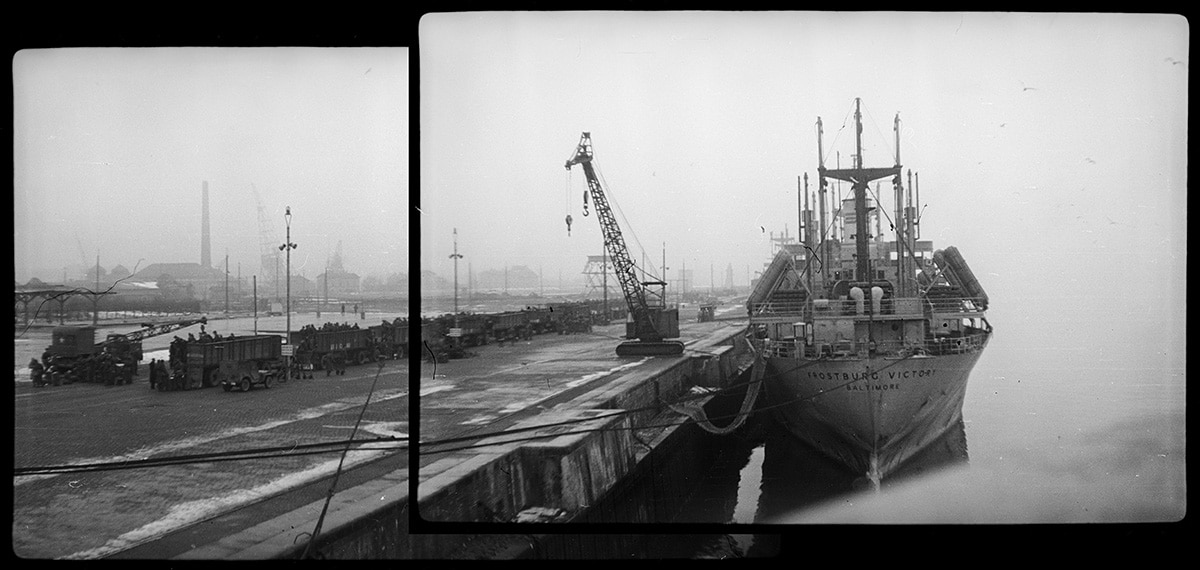
Loading equipment and American military personnel onto the transport ship "Frostburg Victory" prior to departure for America. Photographed from the neighbouring transport ship "Rollins Victory". Bremerhaven, Germany. 1946
Loading equipment and American military personnel onto the transport ship "Frostburg Victory" prior to departure for America. Photographed from the neighbouring transport ship "Rollins Victory". Bremerhaven, Germany. 1946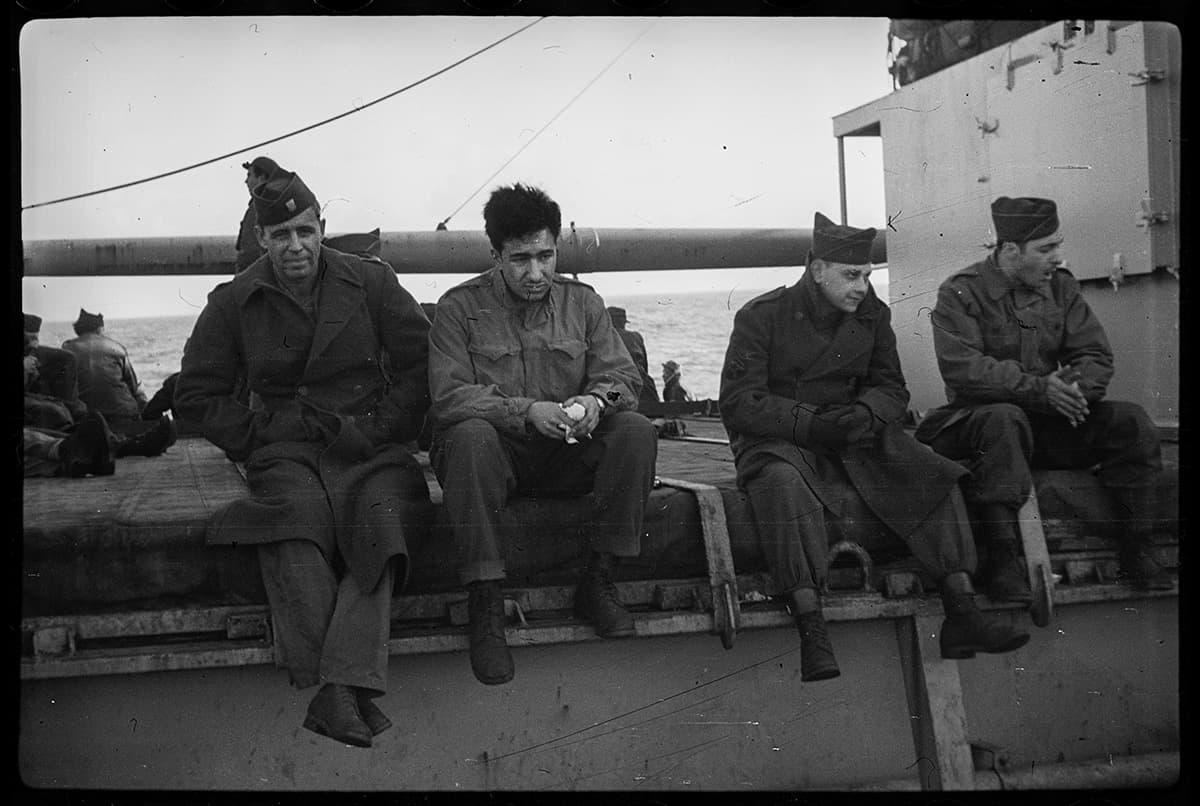
Photographer Sam Jaffe and US military personnel on the transport ship "Rollins Victory" returning to America. North Atlantic Ocean. 1946
Photographer Sam Jaffe and US military personnel on the transport ship "Rollins Victory" returning to America. North Atlantic Ocean. 1946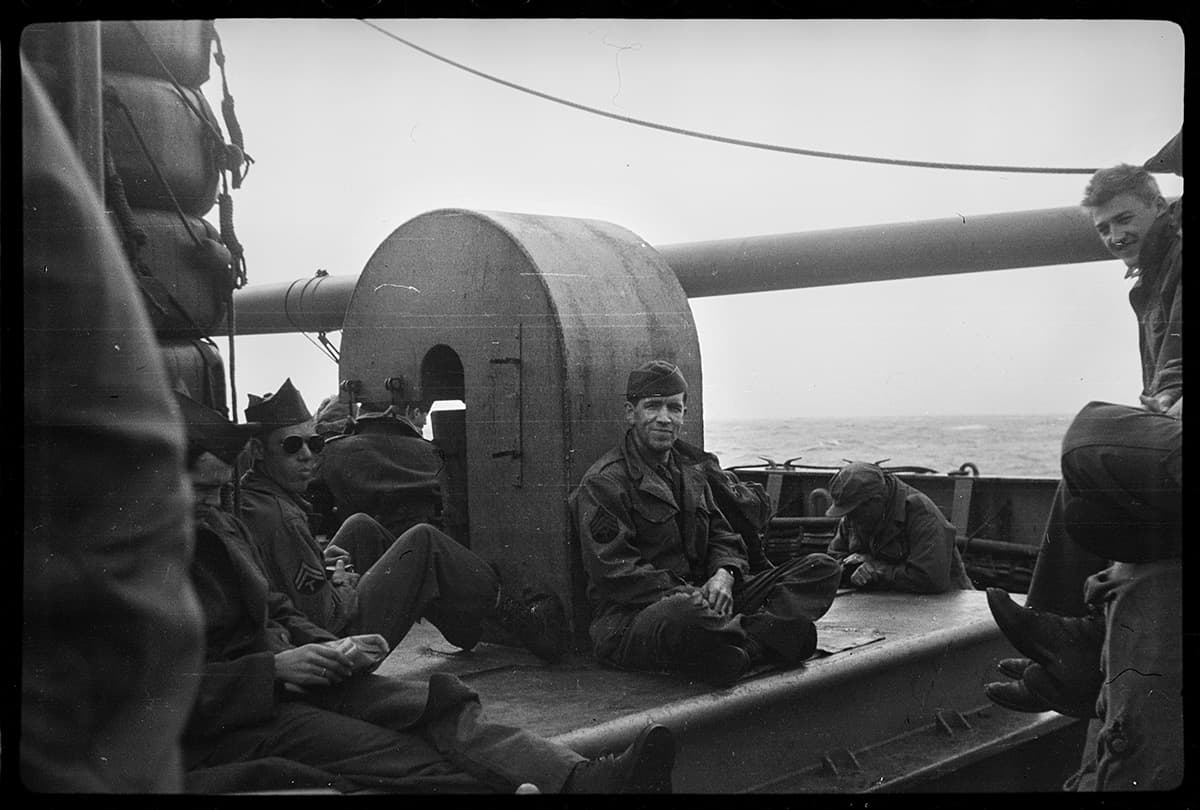
American military personnel on the transport ship "Rollins Victory" during their return to America. North Atlantic Ocean. 1946
American military personnel on the transport ship "Rollins Victory" during their return to America. North Atlantic Ocean. 1946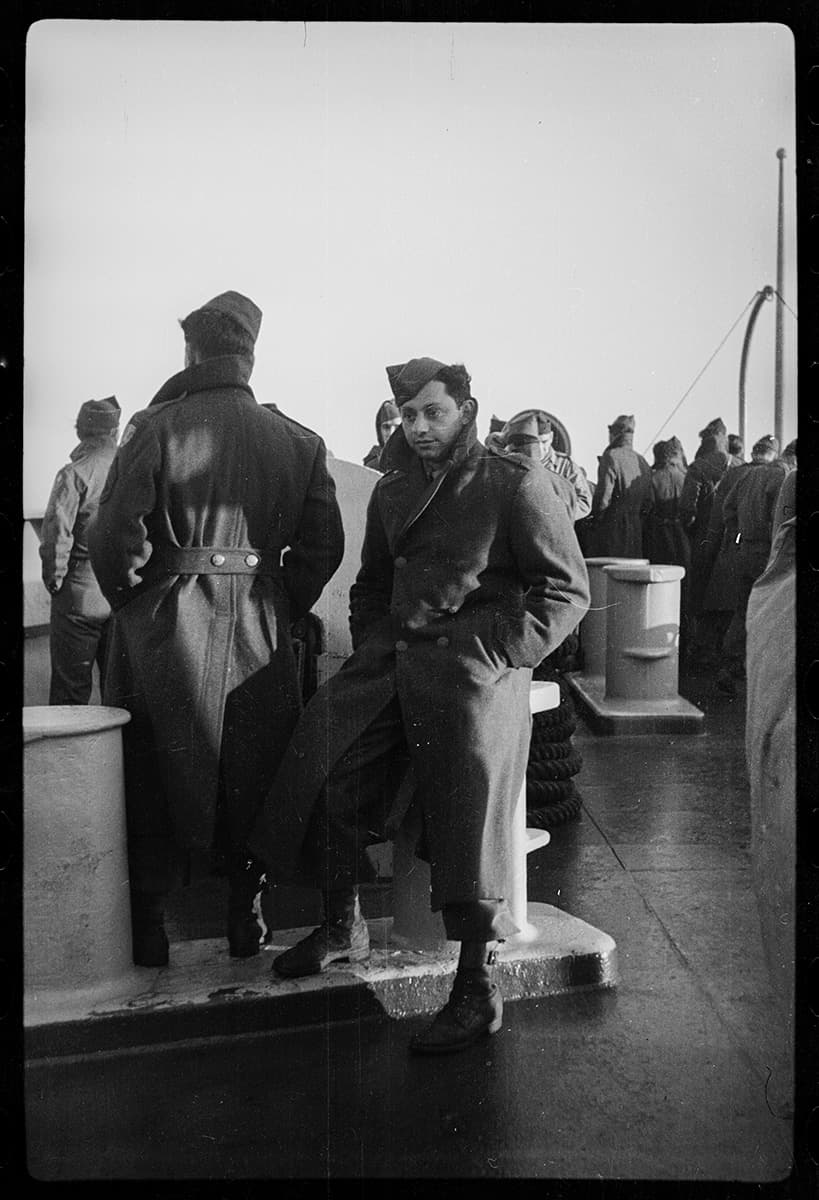
American military personnel on the transport ship "Rollins Victory" during their return to America. North Atlantic Ocean. 1946
American military personnel on the transport ship "Rollins Victory" during their return to America. North Atlantic Ocean. 1946
American military personnel on the transport ship "Rollins Victory" during their return to America. North Atlantic Ocean. 1946
American military personnel on the transport ship "Rollins Victory" during their return to America. North Atlantic Ocean. 1946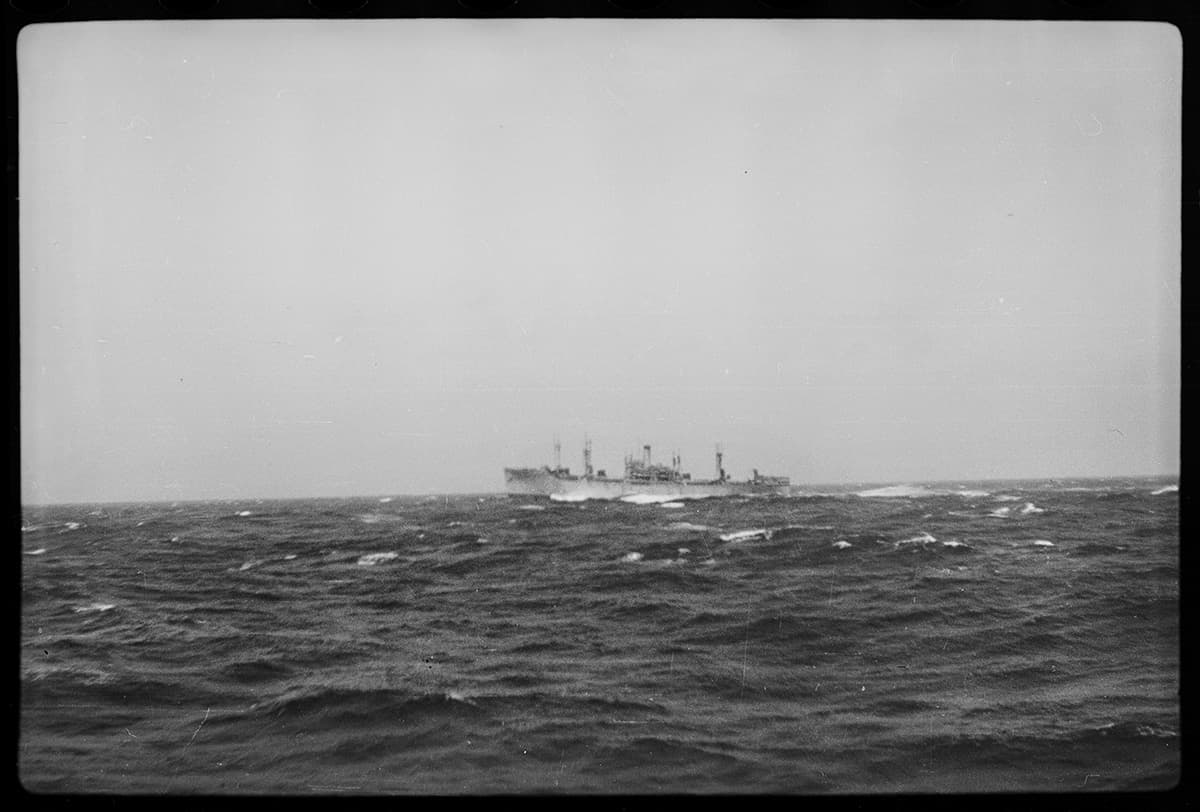
The American transport ship "Frostburg Victory". Photographed from the neighbouring transport ship "Rollins Victory". North Atlantic Ocean. 1946
The American transport ship "Frostburg Victory". Photographed from the neighbouring transport ship "Rollins Victory". North Atlantic Ocean. 1946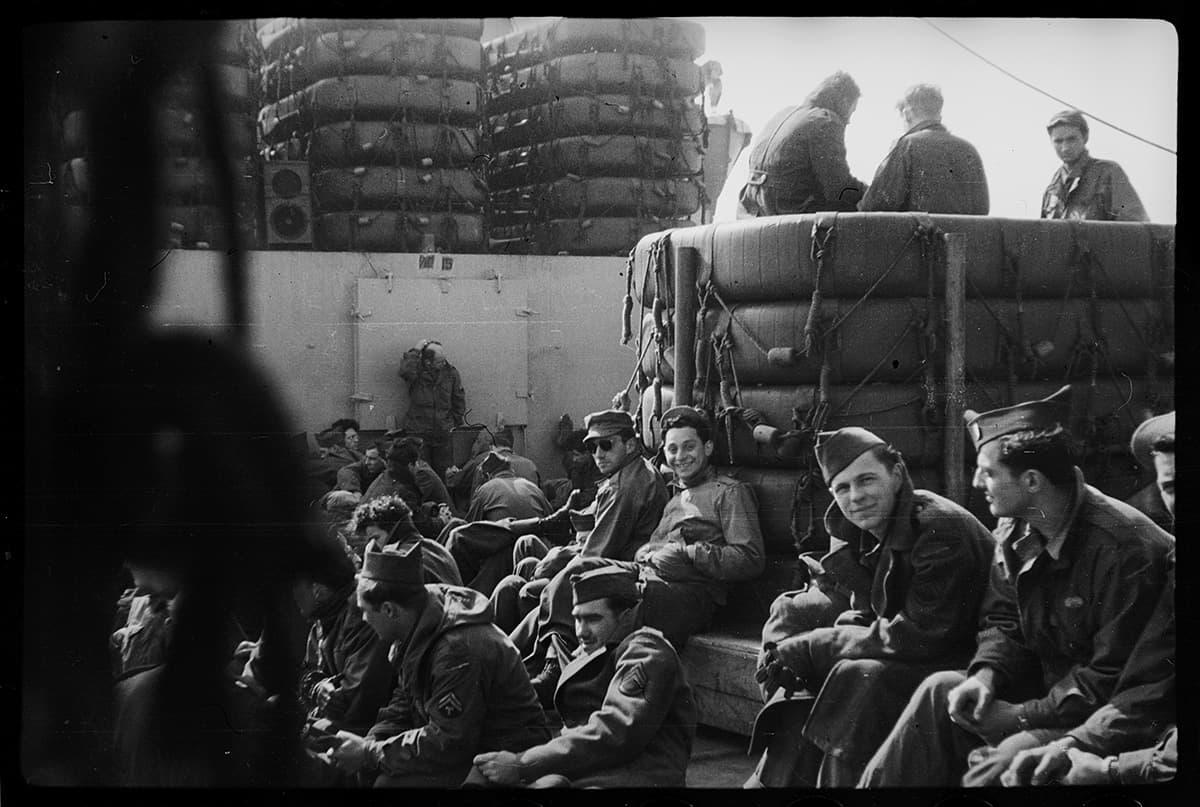
American military personnel on the transport ship "Rollins Victory" during their return to America. North Atlantic Ocean. 1946
American military personnel on the transport ship "Rollins Victory" during their return to America. North Atlantic Ocean. 1946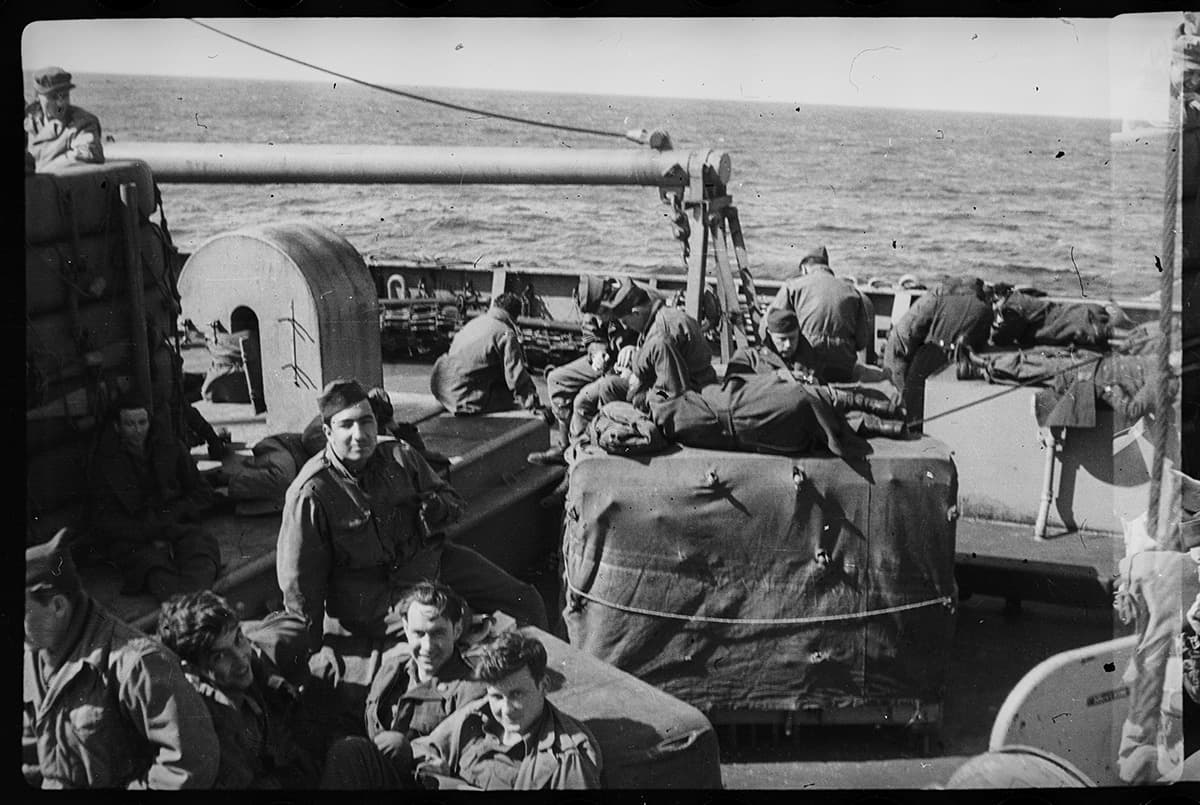
American military personnel on the transport ship "Rollins Victory" during their return to America. North Atlantic Ocean. 1946
American military personnel on the transport ship "Rollins Victory" during their return to America. North Atlantic Ocean. 1946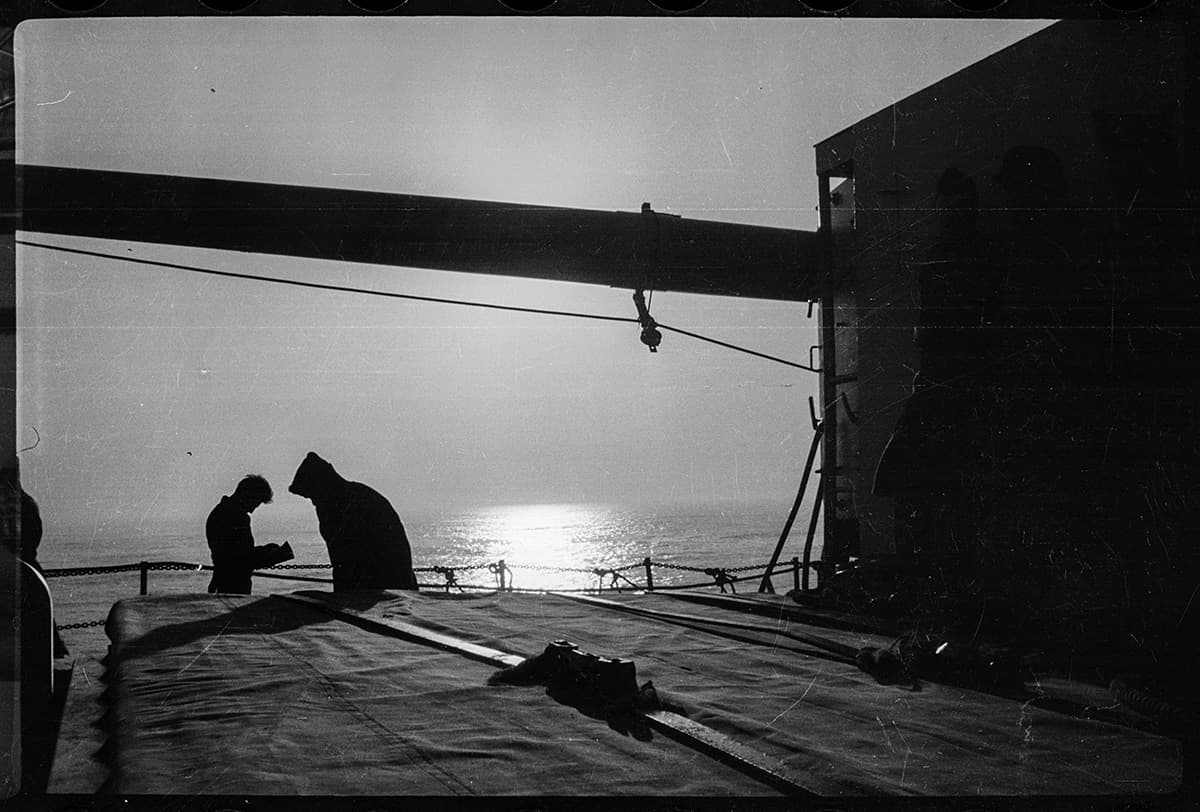
American military personnel on the transport ship "Rollins Victory" during their return to America. North Atlantic Ocean. 1946
American military personnel on the transport ship "Rollins Victory" during their return to America. North Atlantic Ocean. 1946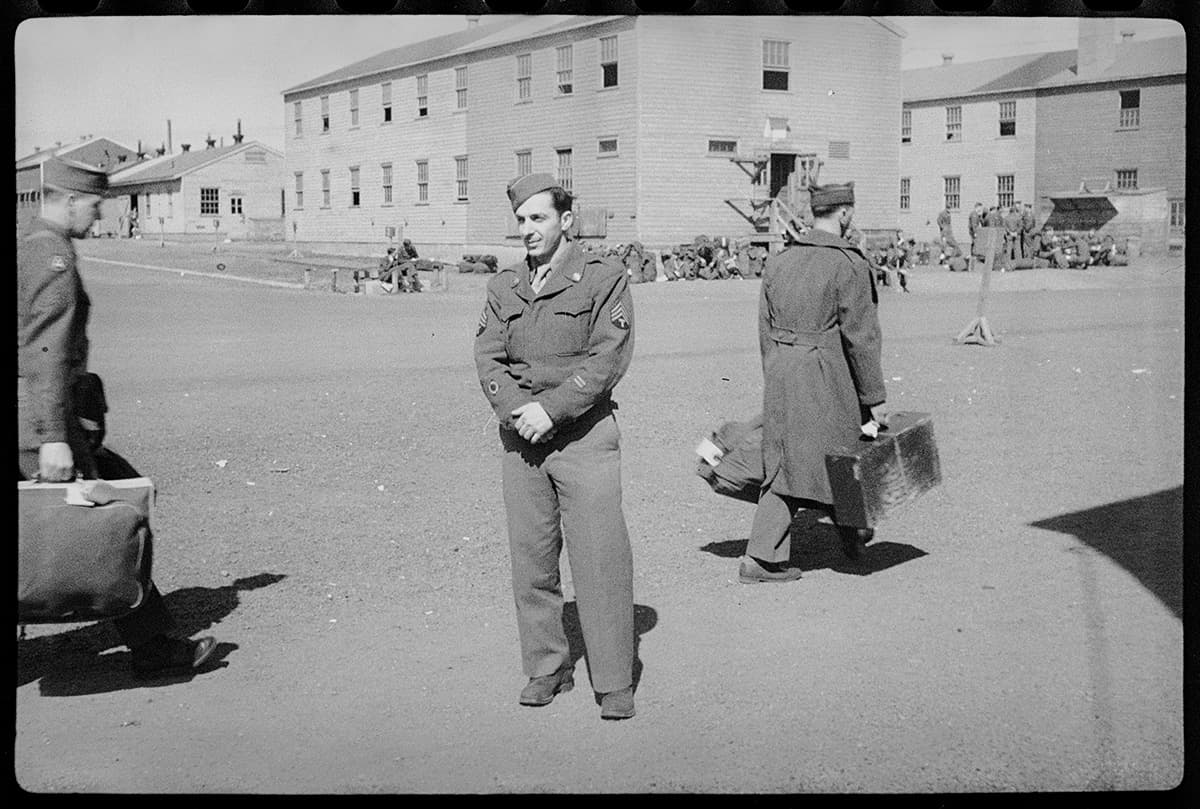
Portrait of a US Army 3rd grade technician at the unit site upon arrival in America. UNITED STATES. Spring 1946
Portrait of a US Army 3rd grade technician at the unit site upon arrival in America. UNITED STATES. Spring 1946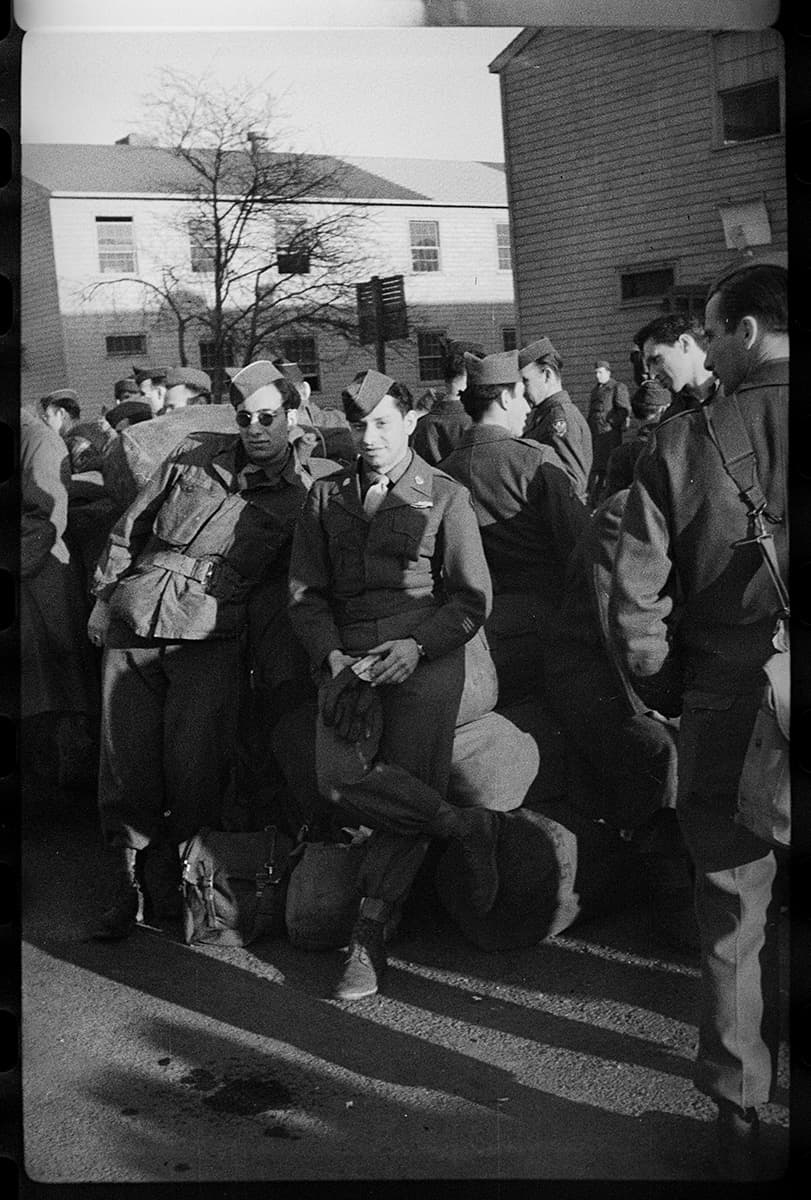
Portrait of Sam Jaffe and a colleague, among unloading US military personnel with duffel bags at the unit's location upon arrival in America. USA. Spring 1946
Portrait of Sam Jaffe and a colleague, among unloading US military personnel with duffel bags at the unit's location upon arrival in America. USA. Spring 1946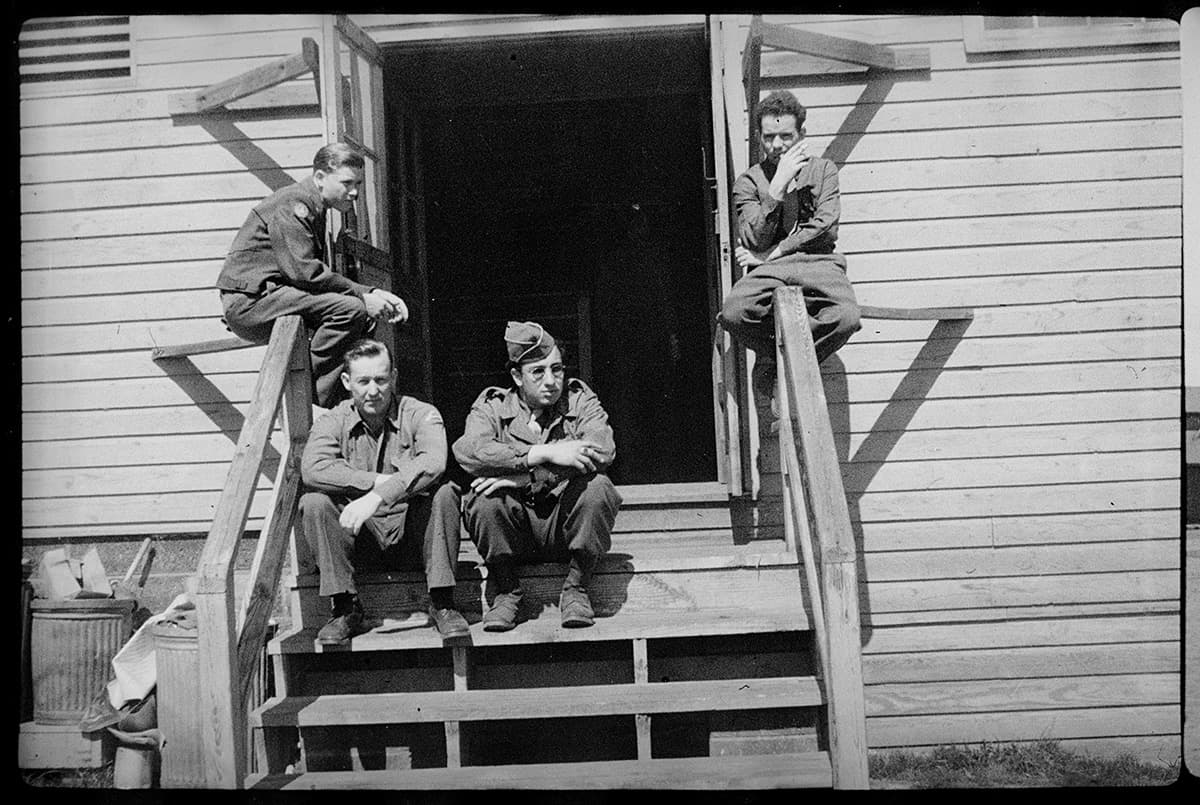
Sam Jaffe and his colleagues sit at the entrance to one of the buildings on the site of the military unit. USA. Spring 1946
Sam Jaffe and his colleagues sit at the entrance to one of the buildings on the site of the military unit. USA. Spring 1946
Photographer Sam Jaffe with his former military colleagues on a street in the Brighton neighbourhood. New York, USA. Spring 1946
Photographer Sam Jaffe with his former military colleagues on a street in the Brighton neighbourhood. New York, USA. Spring 1946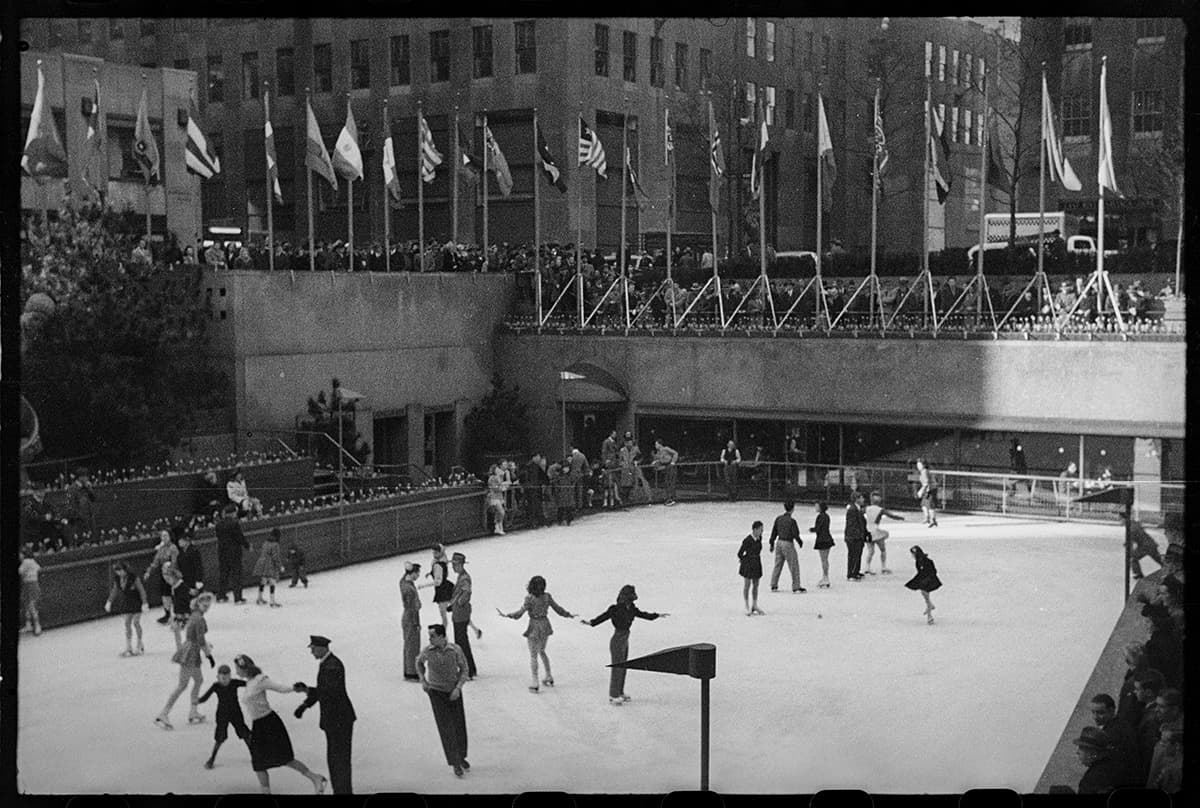
A skating rink at Rockefeller Centre in Manhattan. New York, USA. Spring 1946
A skating rink at Rockefeller Centre in Manhattan. New York, USA. Spring 1946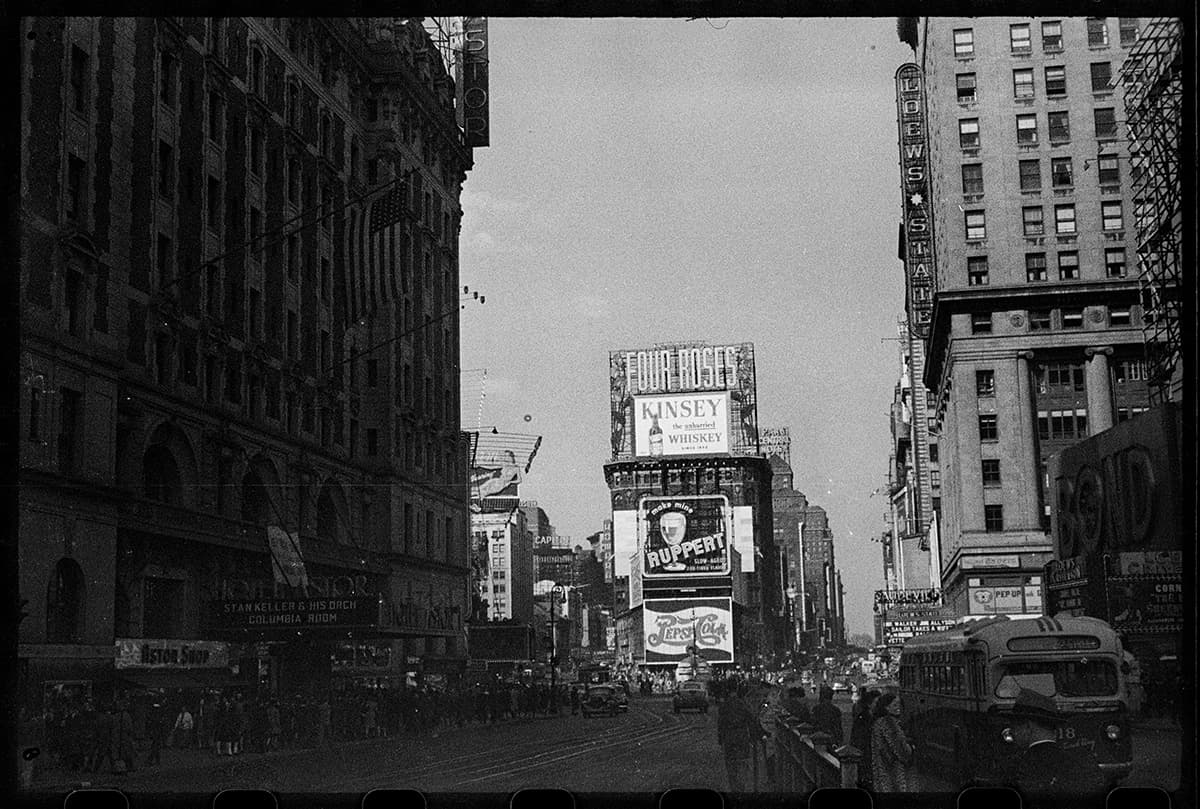
Broadway Street. On the left is the Hotel Astor building in Times Square, which occupied the space between 44th and 45th Streets and was demolished in 1968. On the right is the Lowe's State Theatre building at 1540 Broadway. This was the last theatre in Times Square to continue booking vaudeville shows as demand declined in the 1930s. Above the entrance to the theatre is an advertisement for the American comedy Sailor Takes a Wife. Manhattan, New York, USA. Spring 1946
Broadway Street. On the left is the Hotel Astor building in Times Square, which occupied the space between 44th and 45th Streets and was demolished in 1968. On the right is the Lowe's State Theatre building at 1540 Broadway. This was the last theatre in Times Square to continue booking vaudeville shows as demand declined in the 1930s. Above the entrance to the theatre is an advertisement for the American comedy Sailor Takes a Wife. Manhattan, New York, USA. Spring 1946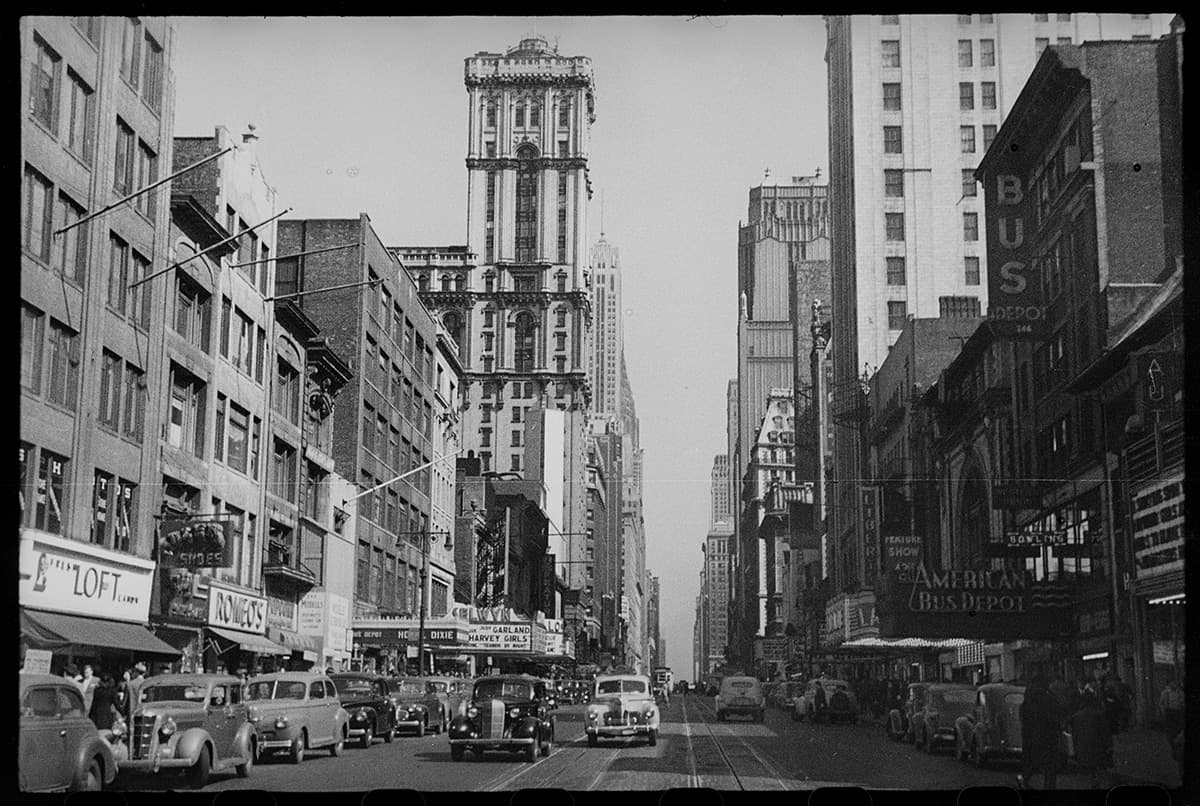
View of 42nd Street. The Chrysler Building can be seen in the distance on the left and the American Bus Depot and Liberty Theatre at 256 West 42nd Street on the right. Manhattan, New York, USA. Spring 1946
View of 42nd Street. The Chrysler Building can be seen in the distance on the left and the American Bus Depot and Liberty Theatre at 256 West 42nd Street on the right. Manhattan, New York, USA. Spring 1946
A panorama of Manhattan Island. New York, USA. Spring 1946
A panorama of Manhattan Island. New York, USA. Spring 1946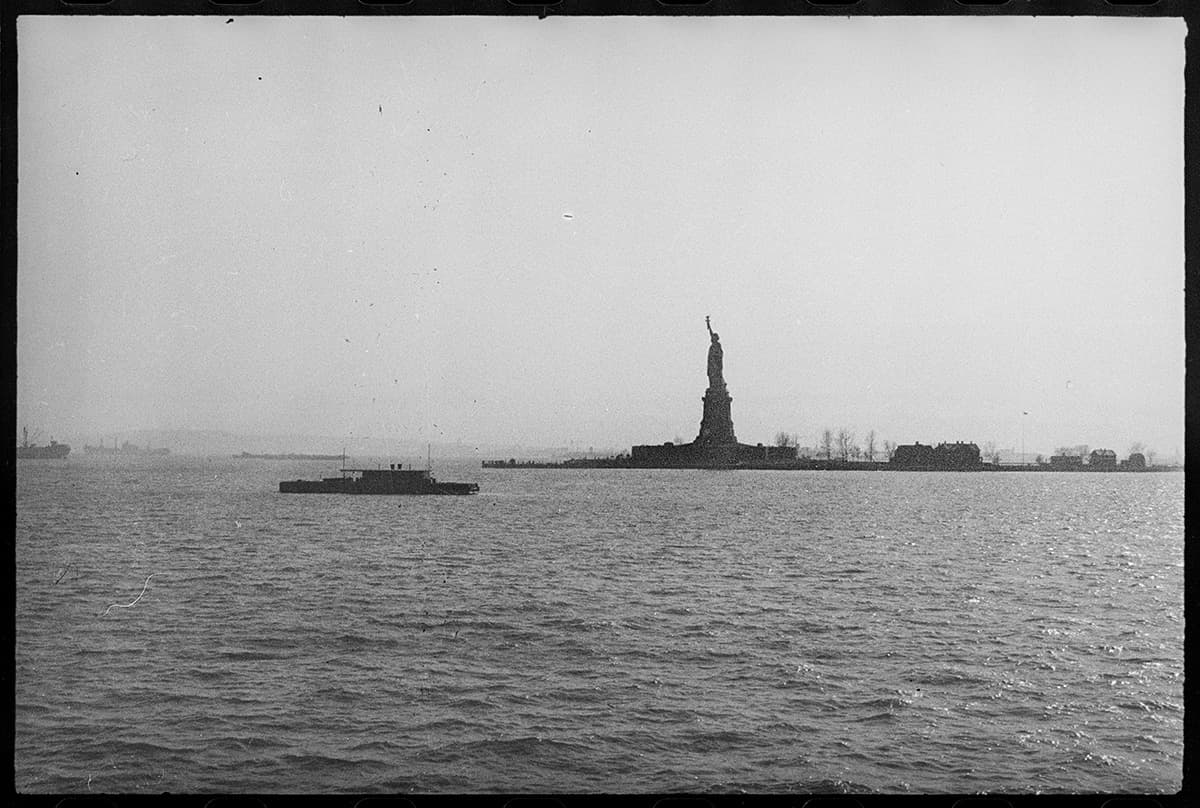
Statue of Liberty on Bedloe Island (the island was officially renamed Liberty Island in 1956) in Upper New York Bay. The statue is 46 metres high (93 metres with base). The full name of the Statue of Liberty is Liberty Enlightening the World. New York, USA. Spring 1946
Statue of Liberty on Bedloe Island (the island was officially renamed Liberty Island in 1956) in Upper New York Bay. The statue is 46 metres high (93 metres with base). The full name of the Statue of Liberty is Liberty Enlightening the World. New York, USA. Spring 1946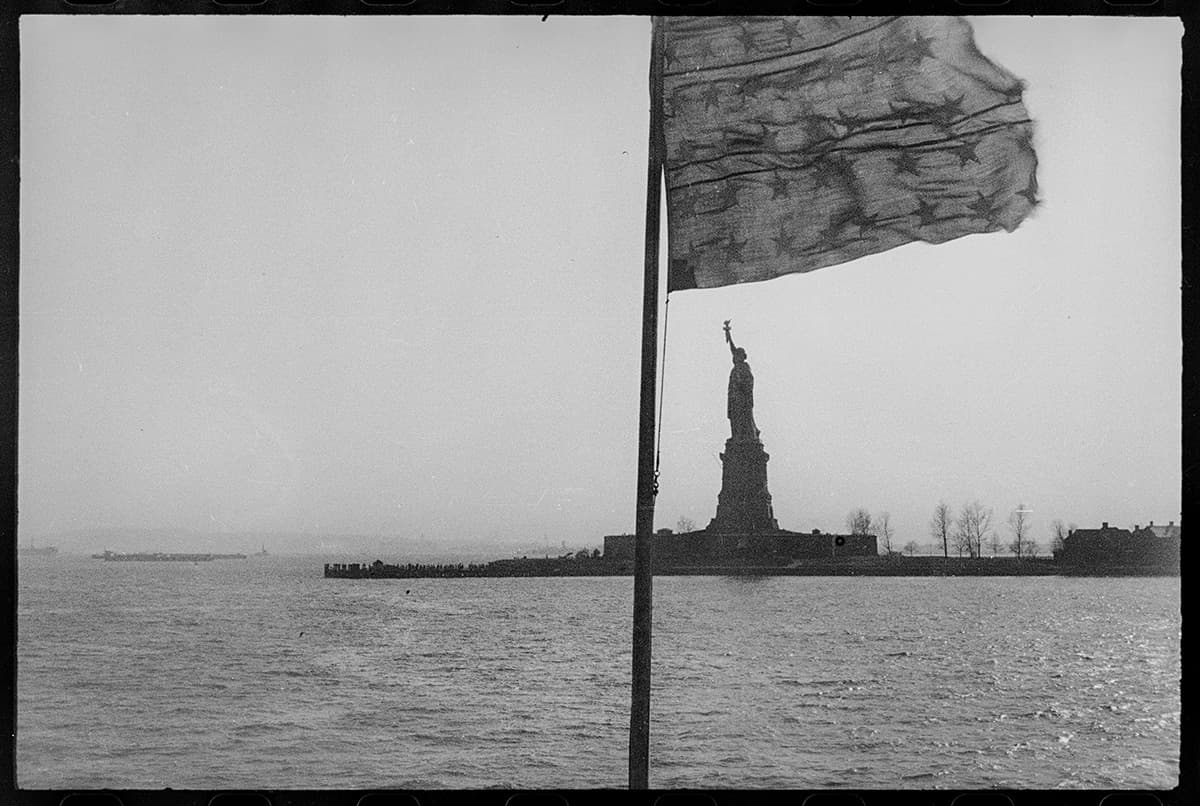
Statue of Liberty on Bedloe Island (the island was officially renamed Liberty Island in 1956) in Upper New York Bay. The statue is 46 metres high (93 metres with base). The full name of the Statue of Liberty is Liberty Enlightening the World. New York, USA. Spring 1946
Statue of Liberty on Bedloe Island (the island was officially renamed Liberty Island in 1956) in Upper New York Bay. The statue is 46 metres high (93 metres with base). The full name of the Statue of Liberty is Liberty Enlightening the World. New York, USA. Spring 1946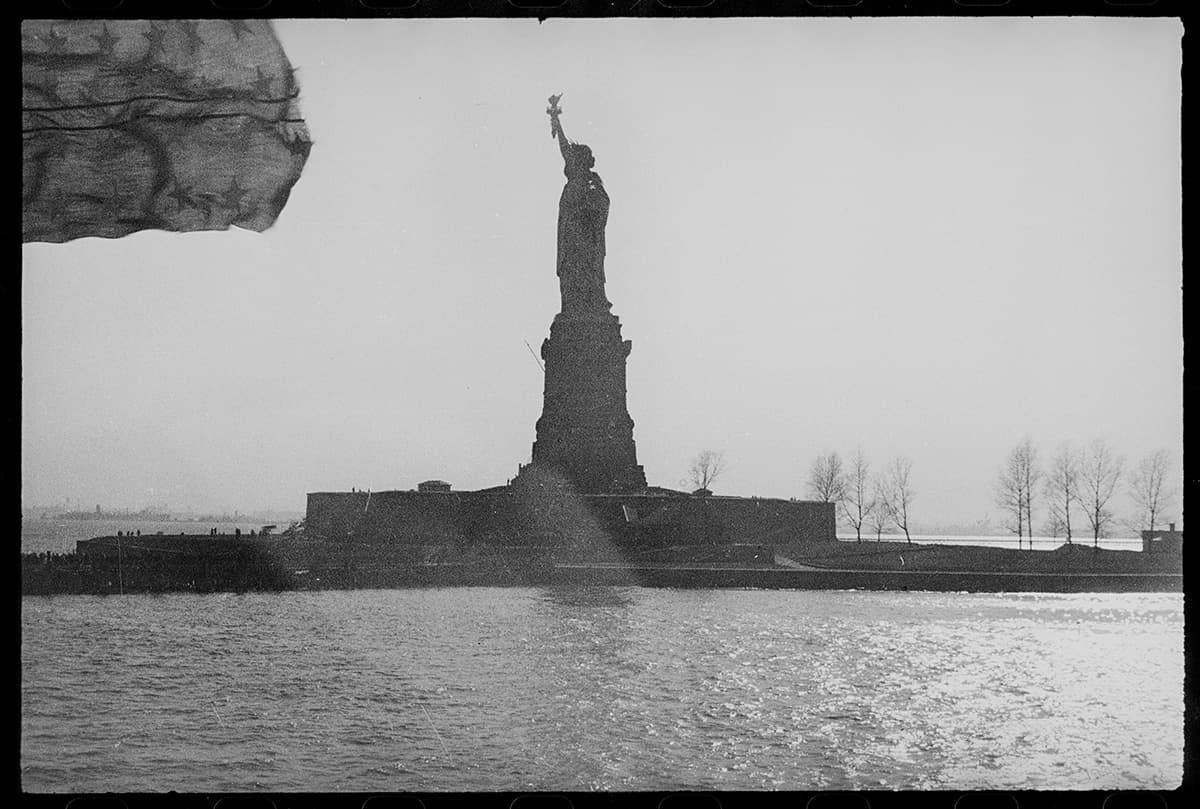
Statue of Liberty on Bedloe Island (the island was officially renamed Liberty Island in 1956) in Upper New York Bay. The statue is 46 metres high (93 metres with base). The full name of the Statue of Liberty is Liberty Enlightening the World. New York, USA. Spring 1946
Statue of Liberty on Bedloe Island (the island was officially renamed Liberty Island in 1956) in Upper New York Bay. The statue is 46 metres high (93 metres with base). The full name of the Statue of Liberty is Liberty Enlightening the World. New York, USA. Spring 1946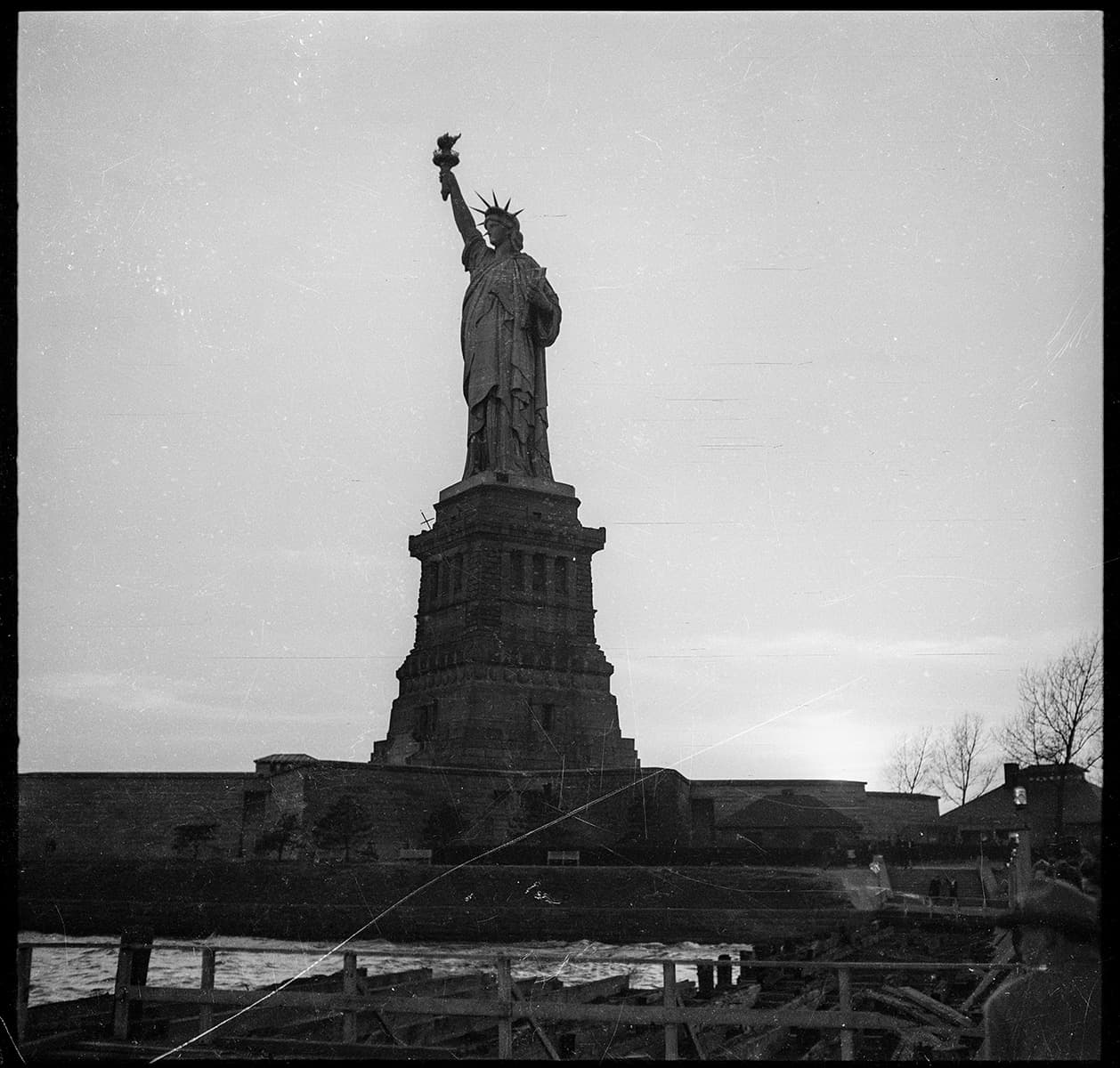
Statue of Liberty on Bedloe Island (the island was officially renamed Liberty Island in 1956) in Upper New York Bay. The statue is 46 metres high (93 metres with base). The full name of the Statue of Liberty is Liberty Enlightening the World. New York, USA. Spring 1946
Statue of Liberty on Bedloe Island (the island was officially renamed Liberty Island in 1956) in Upper New York Bay. The statue is 46 metres high (93 metres with base). The full name of the Statue of Liberty is Liberty Enlightening the World. New York, USA. Spring 1946